Fix pipeline pains. Solve GTM puzzles. And read strategic brain dump.

What does the acronym SEO stand for? Explained Simply
I’ve been in digital marketing for a decade. During this tenure, I’ve heard “SEO” being used to describe everything from keyword research to outright witchcraft.
You know, when people say, “Let’s do some SEO and make it rank!” like it’s a magic spell.
So, let’s clear the air.
SEO stands for Search Engine Optimization.
Those three words carry a world of discipline, art, and analytics. It can even occasionally bring you a headache or two.
But SEO is the wall between a business being found or forgotten by the right people.
Let’s talk about that.
TL;DR:
- SEO stands for Search Engine Optimization. It is the process of improving a website’s visibility on major search engines through technical, content, and authority enhancements.
- SEO attracts organic traffic, establishes trust and credibility, and builds long-term ROI. No paying for every click.
- It operates at three levels: Technical (site performance), On-Page (content & keywords), and Off-Page (backlinks & reputation).
- Local SEO helps businesses boost visibility in location-based searches.
- AI & voice search are redefining how users discover brands. It is no longer enough to just optimize for relevant keywords and search engines.
- Tools like Google Analytics, Search Console, and Ahrefs track SEO success. A tool like Factors.ai connects SEO performance directly to revenue.
What Does SEO Stand For?
SEO seems simple enough, but it carries the power to impact every brand’s online visibility.
Before the linguists beat me up…Yes, I know SEO is an initialism, not an acronym.
But in marketing circles, it kinda means the same thing. Please let us live; we have to optimize all day, as it is.
So when people ask, “What does the acronym SEO stand for?” what they really mean is, “What’s behind this mysterious three-letter thing every marketing person keeps mentioning?
In business, the SEO acronym for business or the SEO abbreviation has become shorthand for all the activities that help your brand get discovered online. It covers a wide range of activities, from fine-tuning a website so search engines read it better to creating content that your potential customers actually want to read.
You don’t want to miss knowing about these 5 mistakes to avoid when measuring content marketing ROI.
Imagine your website as a brilliant new restaurant hidden in a quiet street. SEO is the combination of street signs, maps, lighting, and reviews that help hungry customers find it.
Note: It’s more than “SEO = ranking higher on search engine results,”. The real story comes after the search results get you a click.
How do those visitors behave? Which pages do they engage with? Which blogs or landing pages attract the right accounts, not just random page views?
At Factors, SEO is about understanding the buyer’s digital journey and connecting it directly to revenue. We optimize for algorithms as well as outcomes.
Why SEO Matters for Every Business
Most businesses now live online. For them, search engine optimization (SEO) is marketing oxygen.
About 68% of online experiences begin with a search engine.
That means most people who click an ad, follow you on LinkedIn, or read a blog have asked Google a question to get there. If your website isn’t showing up in those results, you’re irrelevant.
I like to think of SEO as ‘digital gravity’ rather than a marketing channel. It pulls the right audience to your brand, whether you're a SaaS company in Bengaluru or a bakery in Belarus.

- Unlike paid ads, SEO keeps driving results in the long term. Every bit of optimization, every blog post, every backlink will keep attracting an audience.
Read: Are Google Ads Worth It? Pros, Cons & Considerations
- End-users also trust organic results more than ads, as the former are not paid for. With SEO, you don’t pay your way up on any search engine results page. You earn your spot. And nothing gathers customer trust like authenticity.
- So, “SEO acronym business” is more than a keyword. At the business level, you can’t pay your way to natural views and engagement. Instead, you help marketing and sales teams actually see how search queries can drive traffic that converts (what we do at Factors) from anonymous visitors to qualified leads.
For practically every user-facing business, SEO is a growth engine. It drives sustained, efficient outcomes and often becomes the smartest investment in the marketing budget.
The Three Words That Built the Web: Search · Engine · Optimization
The term ‘SEO’ expands into three words that really hold up the modern web (especially for businesses) as we know it. Search engine optimization is the invisible infrastructure of the internet.
So let’s break down each word for a closer look.
- Search: This is the whole reason the web exists. Forget algorithms; the foundation of the internet is humans with questions.
Every “how to,” “best software,” or “near me” reveals that a future customer is looking for a solution, an idea, or even reassurance that they’re not alone with their problem.
Good SEO starts with empathy. You have to understand what your buyer is looking for. Once you gauge the intent behind the words, you’ve won half the battle.
You need to understand user intent as closely as possible, and these Top 15 Intent Data Platforms to Boost Your B2B Sales should help.
If you’re looking for even deeper intelligence, consider this piece on Intent Scoring via Website Visitor Identification.
Note: If you can provide someone with an answer in the exact moment they have the question, you’re not selling. You’re helping.
- Engine: The “engine” in SEO is basically a top-tier matchmaking system. Search engines crawl billions of pages daily, index them like an ace librarian, and rank them based on which best answers user intent.
You can’t bribe search engines (unless you’re running ads, but they will declare it as a paid ad), but you can earn their trust by playing by certain rules.
SEO engines actually don’t care if you’re a startup or a Fortune 500 giant. If you provide better value and relevance, you zoom to the top.
- Optimization: This is what separates amateurs from pros. Your storytelling must meet science.
You can’t just sprinkle keywords and compress images to get SEO wins. Along with quality content, web pages must be fast, relevant, secure, and actually useful.
Pro-Tip: It's a good idea to take a course or do some research about how search engines work, under the hood. It gives you a serious edge over competitors when tracking and analyzing search engine rankings and algorithmic shifts.
Optimization means refining every digital molecule. This includes metadata, headings, links, load time, and content tone. The goal is to make the experience feel effortless for both search engines and people.
Here’s how to discover valuable insights about your website traffic with Factors.ai.
How SEO Works: The Three Levels You Need to Know
If you ask me, “How does SEO actually work?”, I usually answer, “like juggling flaming torches while riding a unicycle.”
Jokes aside, SEO generally comprises three operational levels: Technical, On-Page, and Off-Page. These constitute 90% of organic growth. The rest is caffeine, and keeping up with Google’s mood swings.
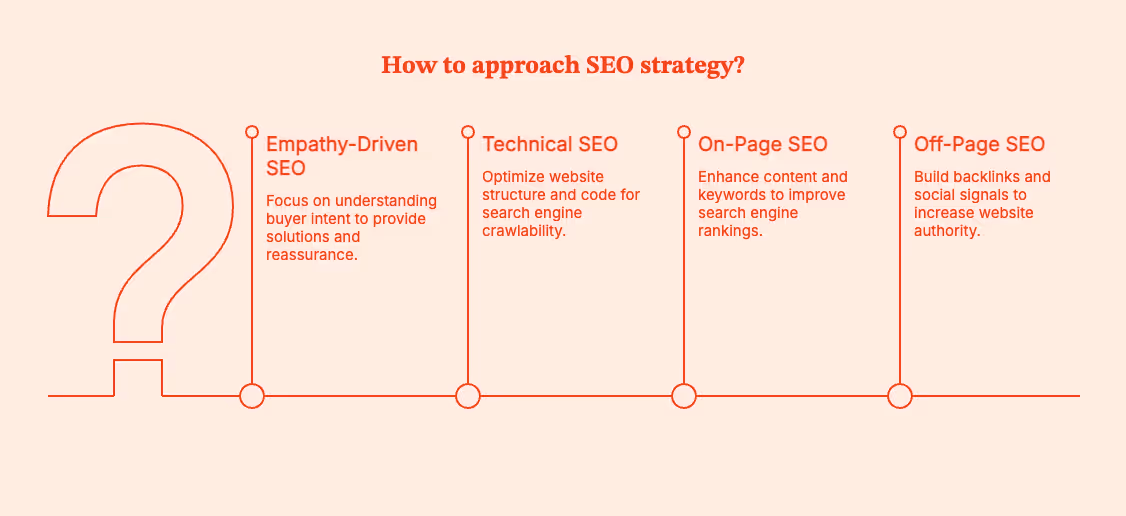
Technical SEO
This is the foundation of your website’s SEO success. The best content won’t work if search engines cannot understand it. That’s where technical SEO comes in.
Here’s what to look for when optimizing technical SEO:
- Crawlability: Can search bots access your pages without hitting dead ends or redirects? Fix broken links, create a sitemap, and keep robots.txt clean to help them do so.
- Mobile-Friendliness: In the second quarter of 2025, mobile devices (excluding tablets) accounted for 62.54% of global website traffic. Your website needs to load fast and work seamlessly on mobile.
- Page Speed: Ideally, your web page should load in 2.5 seconds or less to score well on SEO parameters. Every extra second can cause users to bounce without a second glance.
- Schema Markup: The markup tells the search engine what a piece of content means. It is a standardized vocabulary of code you can add to a website's HTML so search engines really understand what they’re reading.
On-Page SEO
On-page SEO covers content quality, structure, and intent alignment.
- Write for humans, not algorithms. Your content must teach, entertain, or solve a problem.
- Keywords are not scorecards. They are meant to help search engines understand context. Prioritize clarity.
- Treat title tags and meta descriptions like billboards advertising a business on the digital highway. They should be click-worthy without being misleading.
- Use the right hyperlinks to interconnect your web pages with each other. It lets visitors find more relevant content, reduces bounce rates, and increases engagement. Google crawlers also use these links to find related pages, rank them by priority, and gauge link equity.
Off-Page SEO
These are all the actions taken outside the business website to improve its visibility, authority, and credibility in search results. Think of it as your digital reputation.
Largely, it covers:
- Quality backlinks. Don’t chase quantity. A single mention for a respected website matters more than a hundred random directory links from 2010.
- Online references. If folks online are talking about your brand organically, Google realizes that it is more credible.
- Seek (within reason and ethics) social proof in the form of reviews and positive engagement. Users trust brands that other users trust.
To stand any chance at success in the gladiatorial matches (sorry, I meant digital marketing), you have to measure SEO metrics across its three levels…and tie optimization back to ROI.
At Factors.ai, we connect the dots between SEO and business outcomes by highlighting:
- technical fixes that improved organic conversions.
- content pages that delivered qualified leads.
- backlinks that generated new opportunities in the pipeline.
B2B Teams, just starting out on SEO? Here’s a B2B SEO checklist to help you set up and hit the ground running.
Local SEO: Winning Where It Matters Most
Local SEO covers the operations you undertake so that your business shows up for customers in a specific area. For instance, does your website appear in search results when someone types “best coffee near me,” or “B2B analytics firm in Chicago” or similar search intent?

If not, you need more local SEO for your search engine marketing. Here are the basics:
- Google Business Profile (GBP): This is your digital storefront. It shows up in Google Maps, the web, and search engines to describe your business. Users will also see reviews, photos, and directions. Be sure to keep the profile updated.
- NAP citations: This includes details on your Name, Address, and Phone. These should be consistent anytime they show up online. If Google finds three different versions of your address, it will get confused and eventually de-rank your profiles or pages.
- Local content: Create blogs, landing pages, and case studies that mention your region, landmarks, or local client stories.
Local SEO works particularly well for brick-and-mortar stores, service providers, and regional B2B companies that want to capture demand close to their physical location.
At Factors.ai, we map local SEO traffic to account-level signals, so you can see which companies in which regions are engaging. With this insight, you can turn region-based visibility into sales activation.
SEO vs. SEM: How does it impact search results?
A few years ago, whenever I heard someone say, “We’ll do some SEO ads,” I wanted to correct them…with a coffee mug… to their head.
I’m calmer now. Tea helps.
SEO and SEM are related, but not the same thing.
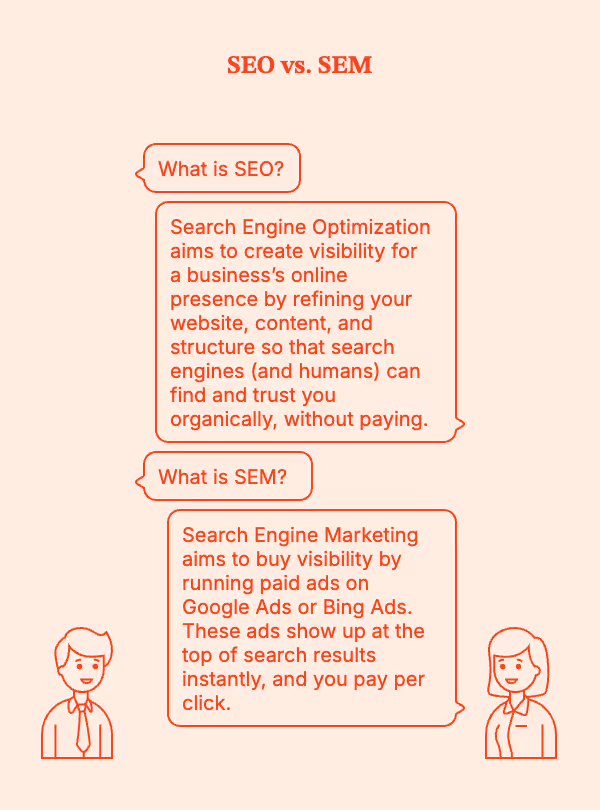
- SEO (Search Engine Optimization) aims to create visibility for a business’s online presence. You refine your website, content, and structure so that search engines (and humans) can find and trust you. And you do this organically, without paying. It’s the very definition of playing the long game.
- SEM (Search Engine Marketing) aims to buy visibility. It involves running paid ads on Google Ads or Bing Ads. These ads show up at the top of search results instantly. You pay per click.
Both are useful tactics, best combined together. SEO builds trust and long-term visibility. SEM drives quick wins and tests which ad copy converts.
Your first time with SEM? You might like our Dummies Guide to Google Ads Management.
With Factors, you can track both organic (SEO) and paid (SEM) touchpoints for a unified funnel view. You can see, for instance, how someone might first discover your brand via a blog post, click a retargeting ad later, and finally convert after an email.
Tools & Metrics: How to Measure SEO Success
You can’t manage what you don’t measure. The right tools and metrics will take SEO from a guessing game to a growth engine.

Your toolkit should have:
- Google Analytics: It tells you who’s visiting, where they came from, and what they did next. Link it with goals or events to track conversions from organic sessions.
- Google Search Console: It shows which keywords triggered impressions, what your CTR looks like, and whether technical issues might be blocking Google from indexing any pages.
- Ahrefs / SEMrush / Moz: These tools analyze backlinks, track keyword rankings, monitor domain authority, and study what’s working for competitors.
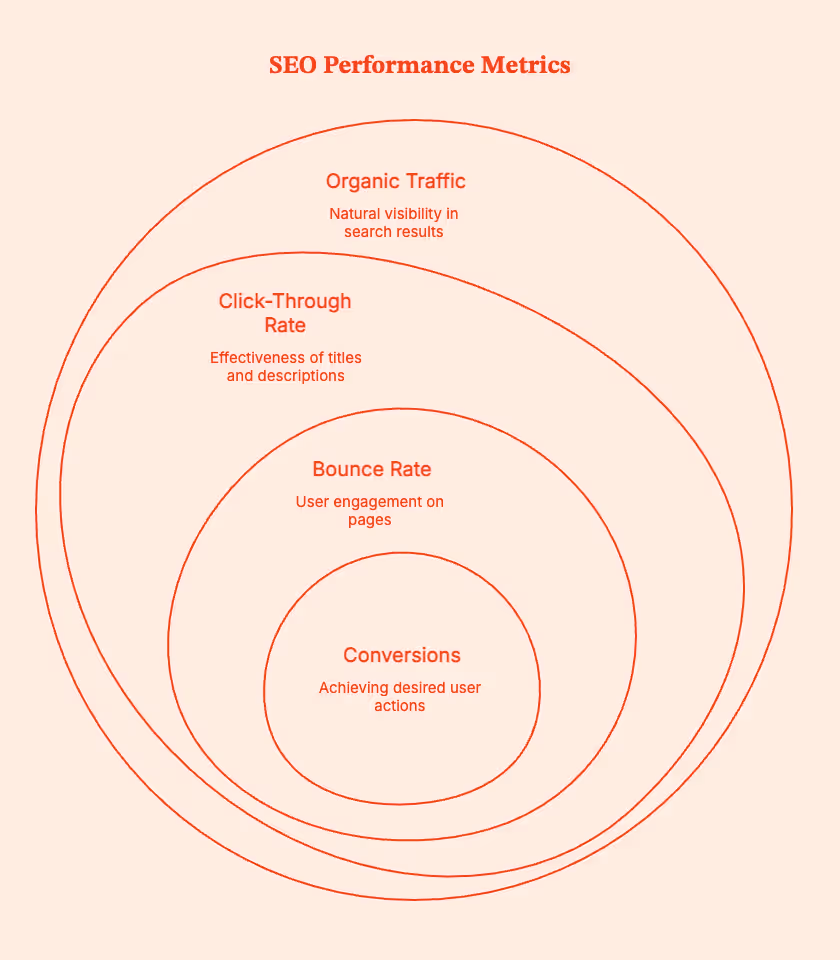
KPIs that actually matter:
- Organic traffic: Are more people finding you online naturally?
- Click-Through Rate (CTR): Are your titles and descriptions getting enough people to click on them?
- Bounce rate: Are visitors spending some time on your page, or bouncing off within seconds?
- Conversions: Are your organic visitors taking desired actions (sign up, get demo, buy)?
Factors.ai will map organic sessions to account-level data and pipeline outcomes. It will show which keywords and landing pages actually drive qualified leads. Now, instead of just saying, “SEO is working”, you can say, “SEO is directly generating $50K in pipeline this month.”
The Future of SEO: From Algorithms to AI (What It Means for Marketers)
SEO was tricky when all you had to manage was Google shuffling rankings based on keywords and backlinks. Now, search engine guidelines have gone full sci-fi (X-Files theme plays).
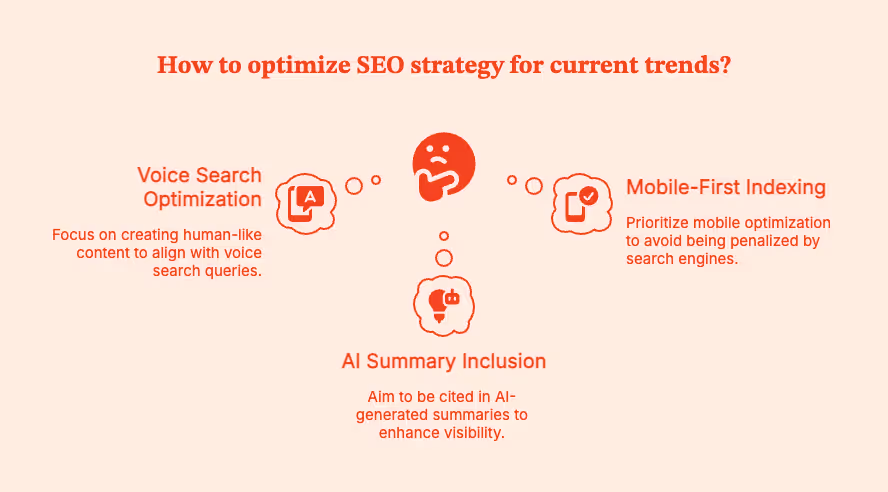
Now, we have to manage AI-driven search, voice assistants, and zero-click results. You have to expect that your audience might expect an answer before they reach your website.
Now, you’ll have to optimize for:
- Voice Search: Increasingly, people ask their AI assistants (I like Siri, but Google Home isn’t bad) questions like “What’s the best CRM for B2B marketing?” . Your content needs to sound human, not robotic. You need to write in the same way people talk.
- AI-Generated Summaries: Google’s AI Overviews now surface synthesized answers to questions on the results page. As a result, ranking logic has changed. You must aim to be cited or featured in AI summaries.
- Mobile-First Indexing: This isn’t new, but many brands still treat mobile optimization as an afterthought. Big mistake.
AI SEO is redefining what optimization means. Search engines aren’t just matching text. They can now interpret intent and context. To meet these standards, content and web page optimization have to be clearer and more structured than ever before.
More AI content also means that readers will have more trust issues around the authenticity of results. You have to work harder to establish the credibility needed for organic search traffic.
The Takeaway
Great SEO still comes down to this: create something genuinely useful, make sure people can find it, and measure the results obsessively.
SEO powers visibility, trust, and quantifiable ROI. It can help startups outshine industry giants, and local businesses dominate their competitors. When done right, SEO can be the most compounding investment in digital marketing. Each optimized page, backlink, and piece of content builds on the last.
At Factors, we focus on turning SEO into a revenue engine. We connect organic performance to pipeline, qualified accounts, and closed revenue.
In a nutshell… what does the acronym SEO stand for?
SEO stands for Search Engine Optimization. It covers all activities undertaken to improve a website’s visibility on popular search engines (Google, Bing).
These refinements help the right audiences find your brand/business naturally without paying for attention or clicks.
At its core, SEO focuses on three levels:
- Technical SEO: Checking that your site is fast, secure, mobile-friendly, and easy for search engines to crawl.
- On-Page SEO: Structuring content, meta tags, headings, and keywords to match user intent.
- Off-Page SEO: Generating trust and authority through backlinks, brand mentions, and social signals.
SEO drives organic traffic, improves brand credibility, and reduces customer acquisition cost (CAC). It delivers compounding returns. Every optimized page will continue to draw in qualified visitors long after it’s published.
Marketers must also account for Local SEO for geographic searches. They also have to optimize for AI-driven SEO, where voice queries, zero-click results, and LLM-powered search engines help people discover information.
It is essential to optimize for both humans and algorithms.
Measuring SEO success must cover the following metrics: organic traffic, CTR, engagement, and conversions. Factors.ai lets marketers connect SEO-driven sessions directly to revenue, closely measuring business impact.
SEO is a strategic growth lever. It helps your business show up when it matters most, build trust over time, and turn discovery into demand.
FAQs for what does Search Engine Optimization stand for
Q. What does SEO stand for in marketing?
SEO stands for Search Engine Optimization. It refers to the process of improving a website’s visibility in search engines. SEO techniques cover technical, on-page, and content improvements…with the intent to help your brand show up when potential customers are looking for answers.
Q. Is SEO an abbreviation or an acronym?
Technically, SEO is an initialism (each letter is pronounced separately). But in business and marketing circles, most people call it an acronym. Grammar purists, just breathe through the pain.
Q. What are the different levels of SEO?
There are three primary levels:
- Technical SEO: The foundation. Covers site speed, crawlability, and structure.
- On-Page SEO: What’s on your site. Includes content, keywords, and meta tags.
- Off-Page SEO: What’s off your site? Covers backlinks, authority, and reputation.
Q. How does SEO impact business growth?
SEO drives organic visibility, which brings in qualified traffic. It reduces Customer Acquisition Cost (CAC), and creates long-term brand equity.
Q. Can SEO be measured in revenue terms?
100% yes.
Platforms like Factors.ai will link SEO-driven traffic and content engagement to pipeline and conversions. Marketers can now use real numbers to prove measurable business impact.
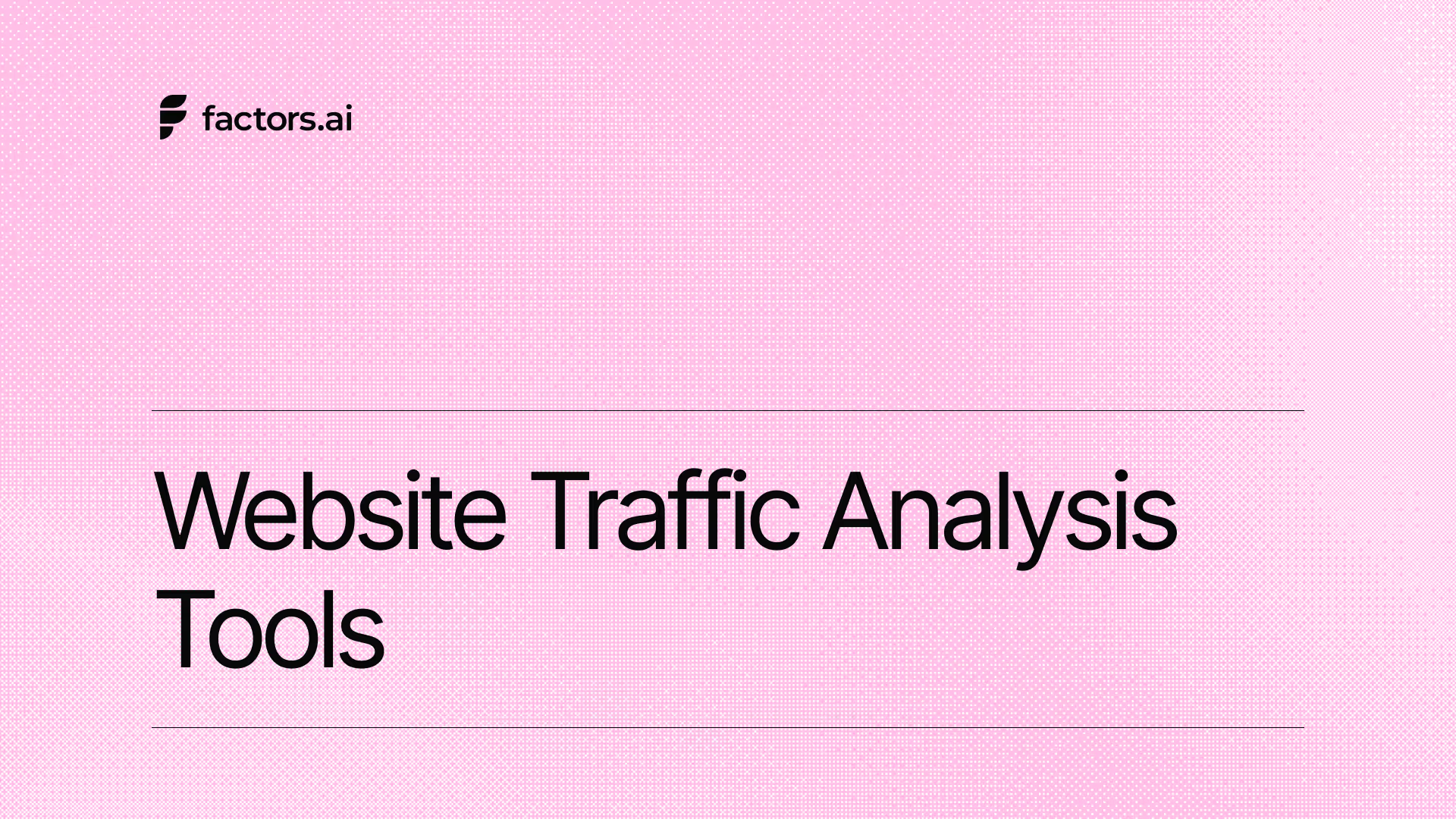
Website Traffic Analysis Tools: How to Check & Compare (Free + Paid)
If someone told you there’s a kind of traffic you’d actually want more of, you’d want it to be website traffic, not the kind that traps you on a highway because some fool decided to block a lane.

Whether you're tracking your own site’s performance or a competitor's, these tools give you that ‘hindsight is 20/20 clarity’ without waiting for a mishap to occur.
The curveball? There are approximately 20 bajillion traffic tools out there (okay, maybe not that many, but close). So, how do you pick the right one without getting lost in a rabbit hole?
Grab your coffee (or third espresso of the day, no judgment), and let's break down everything you need to know about website traffic analysis tools, free traffic checkers, and how to actually check website traffic without losing your mind.
TL;DR
- Web traffic = the visitors coming to your site, measured in sessions, users, and pageviews. It tells you how people find you and what they do once they land.
- Check your own traffic (exact data):
- Google Analytics (GA4): Tracks every session, conversion, and user journey.
- Google Search Console (GSC): Focuses on organic search queries and rankings.
- Check competitor or other sites (estimated data):
- Similarweb: Best for benchmarking and domain traffic analysis.
- Semrush Traffic Analytics: Great for source breakdown and audience overlap.
- Ahrefs Traffic Checker: Ideal for search traffic insights.
- SE Ranking: Solid free traffic checker with trends and country data.
- For deeper behavior insights:
- VWO / Hotjar / Crazy Egg: Show how visitors interact (heatmaps, scrolls, clicks).
- VWO / Hotjar / Crazy Egg: Show how visitors interact (heatmaps, scrolls, clicks).
- For B2B teams:
- Factors: Identifies anonymous visitors, connects them to real companies, and enriches traffic data with firmographics and buying intent.
- Factors: Identifies anonymous visitors, connects them to real companies, and enriches traffic data with firmographics and buying intent.
- Quick tip: Free tools give you accuracy for your own site; paid ones give you estimates for any site.
- Pro move: Combine GA4 + GSC for owned insights, and one estimation tool (like Similarweb or Ahrefs) for market intelligence.
What is Web Traffic and its essential elements?
Before we jump into tools and tactics, let's make sure we're all speaking the same language. Because ‘web traffic’ sounds straightforward until someone asks, ‘Wait, are sessions and pageviews the same?’
Think of web traffic as the different types of people who show up to your (digital) party.

Each one has a different personality. But unlike a real party, you get way more data than just a headcount.
- Sessions are visits. Every time someone lands on your site, that's a session. One person can rack up multiple sessions if they keep coming back (either because your content is that good, or they keep forgetting what they read five minutes ago).
- Users (or unique visitors) track individual people. If Bob visits your site three times today, that's three sessions but one user. Bob's obsessed with you.
- Pageviews count every single page someone loads. If Bob clicks through five pages in one session, you've got five pageviews. It's like counting how many rooms Bob wandered into at your party.
- Traffic sources are how people found you. Organic search folks are the researchers who Googled their way here. Paid ad visitors are the impulse clickers (your ad worked, yay!). Social media traffic? They're the scrollers who got interested. Referral traffic comes from the networkers who followed a recommendation. Direct visitors typed your URL like they had it memorized. Email campaign people are the ones who actually read their inboxes.
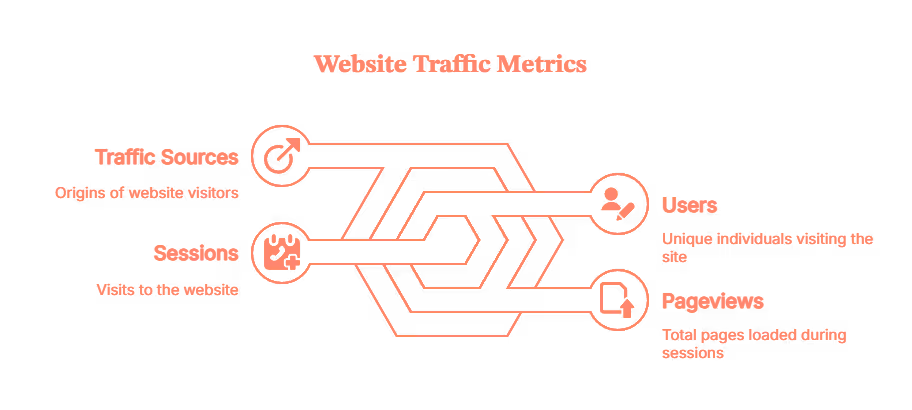
- Knowing your sources and reviewing your traffic reports is how you figure out which marketing channels are actually pulling their weight versus which ones are just there, eating snacks and contributing nothing.
How to Check Website Traffic (Free vs Paid)
Now that we've got the basics down, let's talk about how to check website traffic. Checking it is like seeing your actual report card. Checking a competitor's? That's like hearing through the grapevine that they "did pretty well", useful intel, but not the full picture.
Your own site? Use Google Analytics (GA4). It's free, tracks everything from first click to final conversion, and gives you exact numbers. Google Search Console (GSC) is GA4's nerdy sibling, it focuses on organic search and shows which queries bring people from Google. For deeper insights such as identifying anonymous visitors, their behavior and intent, Factors plugs right in, especially for B2B folks.
Someone else's site? That's where estimated traffic tools come in. Similarweb, Semrush, Ahrefs, and SE Ranking use browser extensions, web crawlers, and some algorithms to estimate any domain's traffic. They give you a ballpark figure. Think of it like the difference between the top speed on your speedometer and what the cop's radar clocks you at.
Best Website Traffic Analysis Tools (Quick Picks)
Let's understand each tool better, as per your use case.
For Your Own Site:
- Google Analytics (GA4) - Best for complete traffic tracking (Free)
- Acts as your command center for website analytics
- Tracks in real time:
- Visitors
- Sessions
- Conversions
- User journeys
- Shows:
- Traffic sources
- Top converting pages
- How users navigate your site
- Limitation: requires tracking code installation, can’t be used to analyze competitor sites
- Google Search Console (GSC) - Best for organic search traffic & queries (Free)
- Tracks your performance in Google Search
- Shows:
- Keywords that trigger impressions
- Page rankings
- Click-through rates
- Focused entirely on search performance
- Completely free tool
- Essential if SEO is part of your strategy
For Competitor Websites or Any Other Domain:
This is where things get fun. Domain traffic analysis lets you estimate traffic for any website, even ones you don't own. It's like standing outside a competitor's store to count how many people walk in. Use it when sizing up competitors, vetting potential partners, or getting a rough idea on the amount of traffic they claim to get.
- Similarweb - Best for domain traffic analysis & benchmarking (Freemium)
- Industry standard for checking any site’s traffic
- Enter a domain to see:
- Monthly visits
- Traffic sources
- Top-referring sites
- Audience geography
- Engagement metrics
- Data pulled from browser extensions, web crawlers, and public sources
- Free version offers limited historical data (a teaser, not the full picture)
- Paid plans unlock:
- Up to 6 months of historical data
- Deeper data splits
- Industry benchmarks
- Semrush Traffic Analytics - Best for competitor traffic breakdown (Paid, starts ~$130/mo)
- Estimates domain traffic and breaks it down by source:
- Organic
- Paid
- Direct
- Referral
- Social
- Provides insights on:
- Subdomains
- Top-performing pages
- Audience overlap (other sites your target audience visits)
- Uses clickstream data and machine learning to generate estimates. Part of Semrush’s broader SEO toolkit, a natural add-on if you already use it for keyword research or backlink analysis
- Ahrefs Site Explorer / Traffic Checker - Best for search traffic estimates (Freemium)
- Focuses entirely on organic search performance
- Enter a domain to see:
- Monthly organic traffic
- Top keywords
- Traffic by country
- Historical trends
- Uses its own web crawler (second-largest after Google) and clickstream panels for data
- Free version offers a preview of available insights
- Full access starts at $129/month, worth it if SEO is a key growth driver
- SE Ranking Website Traffic Checker - Best free traffic checker with trends (Free + Paid)
- Provides estimated monthly visitors, a six-month trend chart, and country-level breakdown, no signup needed
- Strong free offering for a zero-cost tool
- Paid version includes:
- More historical data
- Integration with SE Ranking’s full SEO platform
- Free tier is sufficient for most users
- VWO / Heatmap Tools - Best for qualitative behavior (Paid, various pricing)
- Tools like VWO, Hotjar, and Crazy Egg don’t measure traffic volume
- They show visitor behavior through:
- Heatmaps
- Session recordings
- Click maps
- Help answer key questions like:
- Why do people drop off at checkout?
- Where do they get confused?
- Reveal the “why” behind the numbers
- Best used alongside GA4 for a complete view: combining quantitative and qualitative insights
Accuracy caveats:
With these tools estimates can swing a couple of standard deviations, especially for sites with lesser direct traffic, as well as strong brand searches, or niche audiences. It's like guessing jelly beans in a jar, close, but not exact. If a tool says your competitor gets 100,000 monthly visits, the real number might be 70,000 to 130,000. So plan and tread accordingly.
Feature-by-Feature Comparison of Website Traffic Analysis Tools
Alright, let's get nerdy. Here's a side-by-side comparison of the top traffic analysis tools, broken down by the features that actually matter.
If you're a solo founder, freelancer, or small business, start with the free stack: GA4, GSC, and SE Ranking's free traffic checker. If you're in a competitive market and need regular competitor intel, invest in Similarweb or Semrush. If SEO is your primary growth lever (and honestly, it probably should be), Ahrefs is worth the subscription. And if you're optimizing for conversions, add VWO, Hotjar or Factors to visualize the user journey. Don't overthink it, pick one, start using it, and adjust as you learn what you actually need.
How Factors Can Help Track and Convert Anonymous Website Traffic
Most B2B websites sing the same sad song: tons of traffic, little visibility. You’re spending on ads, content, and SEO, but have no clue which companies are visiting or what they’re doing once they arrive.
Traditional website traffic analysis tools that might stop at "10,000 visitors last month from organic search." Factors flips this script. It identifies anonymous accounts on your site using reverse IP lookup and rich firmographic data (company name, size, industry, and location). In short, it turns invisible visitors into qualified accounts you can actually act on.
Here’s what makes Factors stand out:
- Identify anonymous visitors: Uses a waterfall model (6sense, Clearbit, Demandbase, and Snitcher) to match up to 75% of anonymous traffic to real companies, e.g., instead of “Someone from San Francisco,” you see “Acme Corp, 500+ employees, SaaS, visited your pricing page three times.”
- Track behavior and intent: See how companies interact with your site through pages viewed, clicks, time spent, and buying intent. It helps your marketing and sales team spot who’s just browsing and who’s ready to buy.
- Enrich traffic with context: Connects website activity to outcomes revealing which campaigns drive high-quality visits, what content resonates, and which channels deserve more investment.
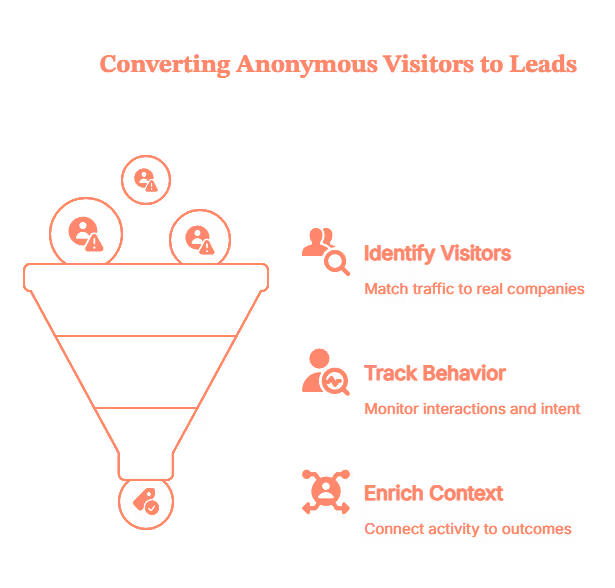
If you’re a B2B marketer tired of watching traffic disappear into the void, Factors helps you see who’s visiting, what they care about, and when to reach out, turning anonymous traffic into actual pipeline.
💡Understand intent scoring via website visitor identification better
In Short
Website traffic analysis tools aren’t just about counting visitors, they help you understand who’s coming, why they’re there, and what makes them stay. Whether you’re growing an eCommerce store, running an SEO campaign, or analyzing competitors, the right mix of tools can turn raw data into real strategy. Start simple with free options, level up as your needs grow, and remember to perform an audit regularly as traffic isn’t the goal, what you learn from it is.
FAQs for Website Traffic Analysis Tools
Q. What is web traffic?
Web traffic is the volume of users and sessions that visit a website. Main metrics include users (unique visitors), sessions (visits), and pageviews (pages loaded). Traffic sources show where visitors come from, while engagement metrics show if they actually stuck around or bounced immediately.
Q. How do I check a website's overall traffic?
For the site you own, use Google Analytics (GA4) and Google Search Console for exact data. For competitors, try SE Ranking, Ahrefs, or Similarweb for solid traffic estimates.
Q. Can I check a competitor's traffic?
Yes, through tools like Similarweb, Semrush, Ahrefs, and SE Ranking. They estimate traffic using data panels and browser extensions. Expect variance, it's accurate enough for competitive strategy and benchmarking. Don't bet your budget on a single tool's estimate, cross-reference when you can.
Q. What's the difference between a "website traffic checker" and a "website traffic analysis tool"?
A traffic checker gives you a quick snapshot of monthly visits, usually free with minimal detail. An analysis tool offers deeper reporting: historical trends, channel breakdowns, page-level metrics, user behavior. Checkers are for speed, analysis tools are for depth.
Q. How does Factors help with tracking and converting anonymous website traffic?
Factors goes beyond counting visitors, it tells you who they are. It identifies anonymous companies visiting your site using reverse IP lookup and firmographic data, revealing details like company name, size, industry, and intent. Perfect for B2B teams who want to turn traffic insights into qualified leads and pipeline.
Q. Are free traffic checkers accurate?
Free checkers provide useful directional data but can deviate from real metrics for competitor sites. They're like weather forecasts, close enough to help you plan, but not perfect. Use them for trends and relative performance, not as absolute truth. Cross-referencing multiple tools helps improve accuracy.
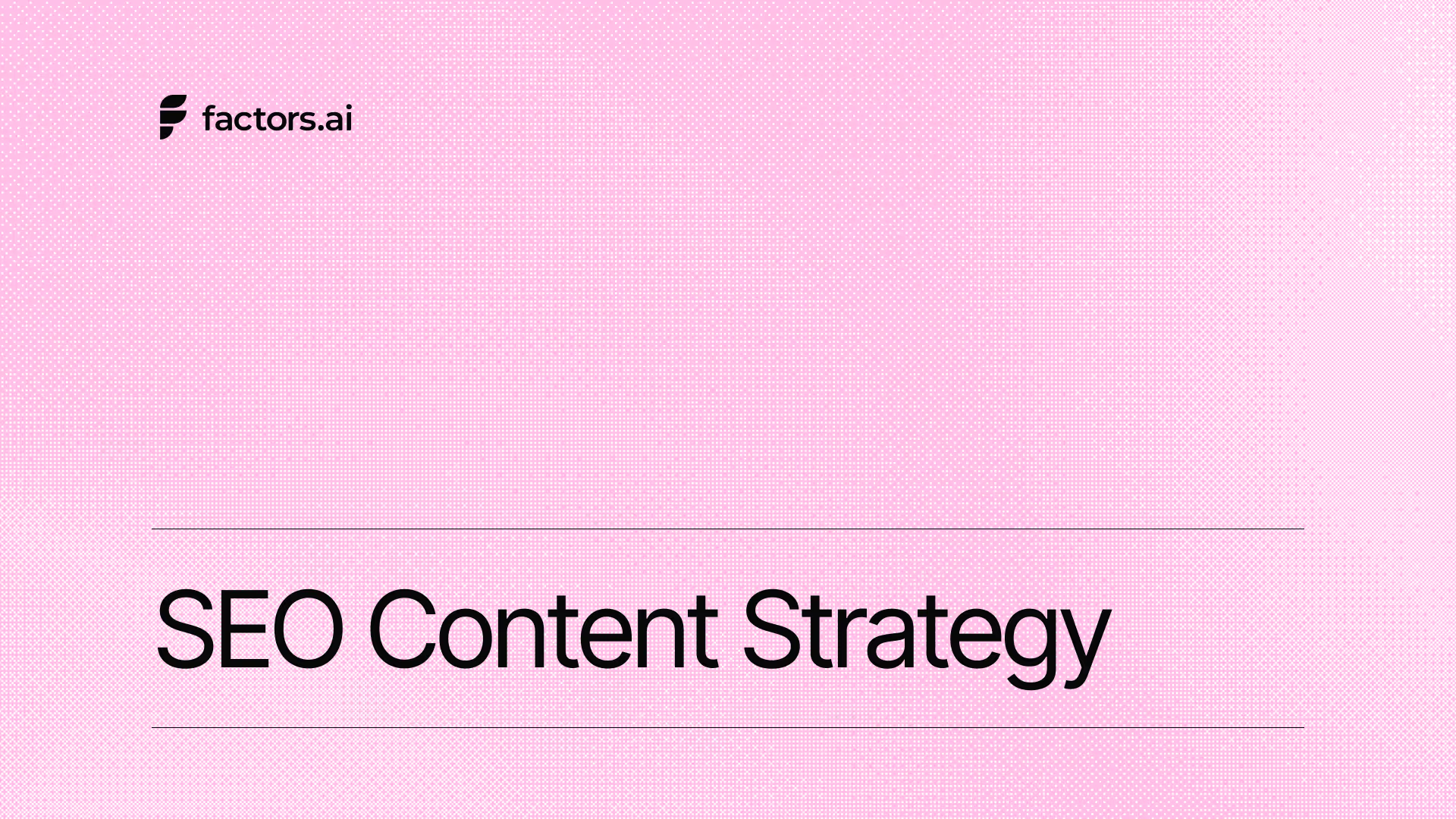
SEO Content Strategy: From Rankings to Revenue
The Shift from Keywords to Intent
Just when everyone thought they’d mastered SEO with perfect keyword research, flawless meta descriptions, and internal links organized like subway maps… rankings tanked. And instead of adapting, most people doubled down. It’s like Ross yelling “PIVOT!” while everyone pretends not to hear.

“SEO driven content” somehow became code for “stuff as many target keywords as we can!” Teams obsessed over keyword density and meta tags, forgetting one small detail: actual humans have to read this.
Most teams chase volume. “This keyword gets 10,000 searches a month!” Great. But how many of those 10,000 people would ever buy from you? Or are they just window shoppers doomscrolling their time away between meetings?
Here’s the uncomfortable truth, organic traffic alone doesn’t cut it anymore. You need the right kind of traffic. The kind that turns into a robust pipeline. The kind that eventually signs contracts.
TL;DR: Building SEO Content That Drives Pipeline
- Intent beats keywords. Create content that matches where buyers are in their journey, not just what has high search volume.
- Use proven structure. Hook with a problem, add context, deliver value, guide to next steps. Make it scannable.
- Build content clusters. Create pillar posts around core ICP problems with supporting deep-dives. Interlink strategically.
- AI assists, humans create. Use AI for research and structure, but keep insights and originality human. Google spots generic content.
- Measure pipeline, not traffic. Track which content drives MQLs, SQLs, and opportunities. Attribution reveals what actually generates revenue.
- Update old winners. Historical optimization beats creating new mediocre content. Refresh your best-performing posts regularly.
- Learn from the best. HubSpot educates constantly. Semrush certifies expertise. Slack meets audiences everywhere with repurposed content.
Why Great Content Wins SEO
SEO without great content is like a storefront with no products. You might get people to show up, but they'll leave empty-handed.
Today search engines reward originality, depth, and relevance. Google's algorithms, thanks to BERT, MUM and SGE, have gotten scary good at understanding what people actually want, not just what they type into the search bar. That means your content needs to do more than hit keyword targets. It needs to solve problems, provide genuine insights, and align perfectly with user intent.
Say someone searches for “marketing automation platforms.” Who are they, really?
A junior marketer who just heard the term for the first time? A marketing director comparing tools? A VP ready to book demos?
Same search. Totally different intent. Completely different content needed.
Think about your own search queries. When you Google “best project management tool,” you’re not looking for a history lesson. You probably want to understand the best possible tools out there, their features, pricing, pros, and cons.
Growth-focused teams already know that SEO-led content marketing isn't just a traffic play anymore. It's a revenue play. The right content doesn't just bring visitors, it brings qualified accounts into the pipeline.
So, stop asking, “What keyword should I target?” Start asking, “What is this person actually trying to understand/know, and how can I help them do it better than others?”
That’s how you win. With a better understanding of your target audience’s intent.
⚡Quick Read: How To Build Your Ideal Customer Profile In 15 Steps (2025)
What Actually Makes SEO Content Work
High-performing content follows a pattern. Not because marketers love formulas (though we do), but because this matches how real humans read online.
Let’s break this SEO version of the Quadratic formula down:
- The Hook + Pain Point Opening
Start by calling out a problem your reader actually has. Skip the "in this post, we'll explore..." nonsense. Get specific about what hurts. - The Context
Answer the "why now?" question. What shifted? Why does this matter today and not six months ago? This keeps people reading instead of bouncing to TikTok. - The Value
Time to deliver. Give people insights, frameworks, examples, real data (use external links). Show them how things work, not just what to do. This is where you earn your keep. - Next Steps
Point people somewhere useful. Another resource, a tool, or just a conversation. Don't leave them hanging like a bad Tinder date.
What Separates Good Content from Great
Internal Linking Strategy
Content clusters around core topics build topical authority. Create multiple pieces that connect around a central theme. You're showing search engines you own this topic. Think of a pillar post on "B2B content marketing strategy" linking to pieces on distribution channels, measurement frameworks, and content formats. It’s like trying to spot Ursa Major on a cloudy night, technically part of the job, but not exactly edge-of-your-seat stuff.
Scannable Formatting
Subheadings every 200-300 words. Short paragraphs. Bullet points for lists (but regular sentences for explanations, please). Most people skim first. Earn their attention, then they'll read deeply.
Finally, On-page SEO ties all these elements together by structuring and linking your content for maximum visibility and user engagement.
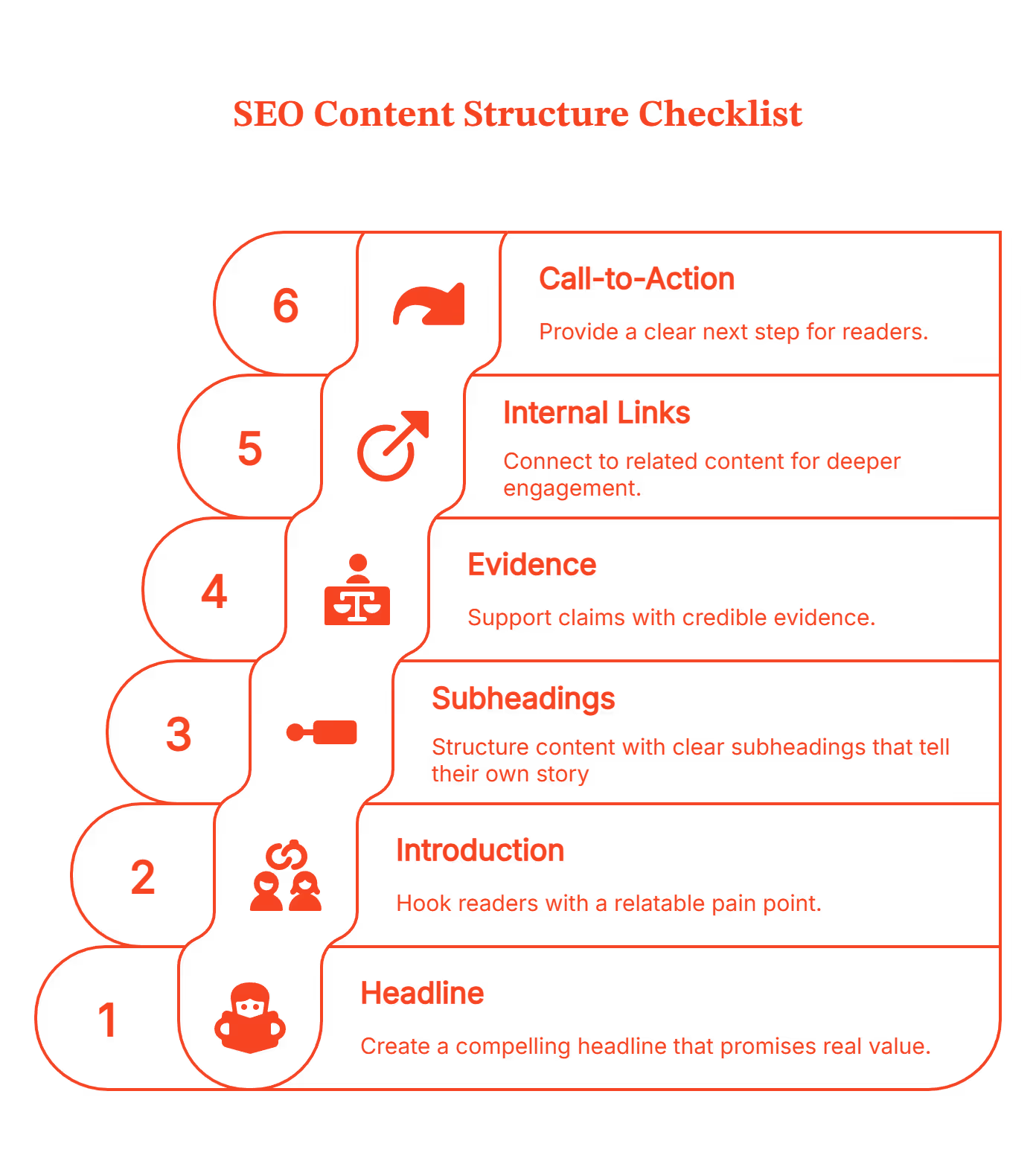
➕Also Read: Step-by-Step Guide to SaaS Content Marketing
Real-World SEO Content Examples (and What They Teach Us)
Right, let's look at some brands that actually get content AND seo right. Here’s what’s actually working out there.
- HubSpot: Practice What You Preach
The Setup:
HubSpot literally invented the term "inbound marketing." So if their content wasn’t killer, that'd be awkward, wouldn't it? They couldn't exactly sell inbound marketing software while doing outbound spam. They had to walk the walk.
What They Did:
Started with a simple realization: their customers couldn't use inbound marketing effectively if they didn't understand the fundamentals. So they created a blog. Then another blog. Then separated blogs by niche: marketing, sales, service, website design. Each with its own audience persona.
But here's the clever bit, instead of just creating more content, they implemented "historical optimization" constantly updating old content to keep it relevant and ranking. Have a look here:
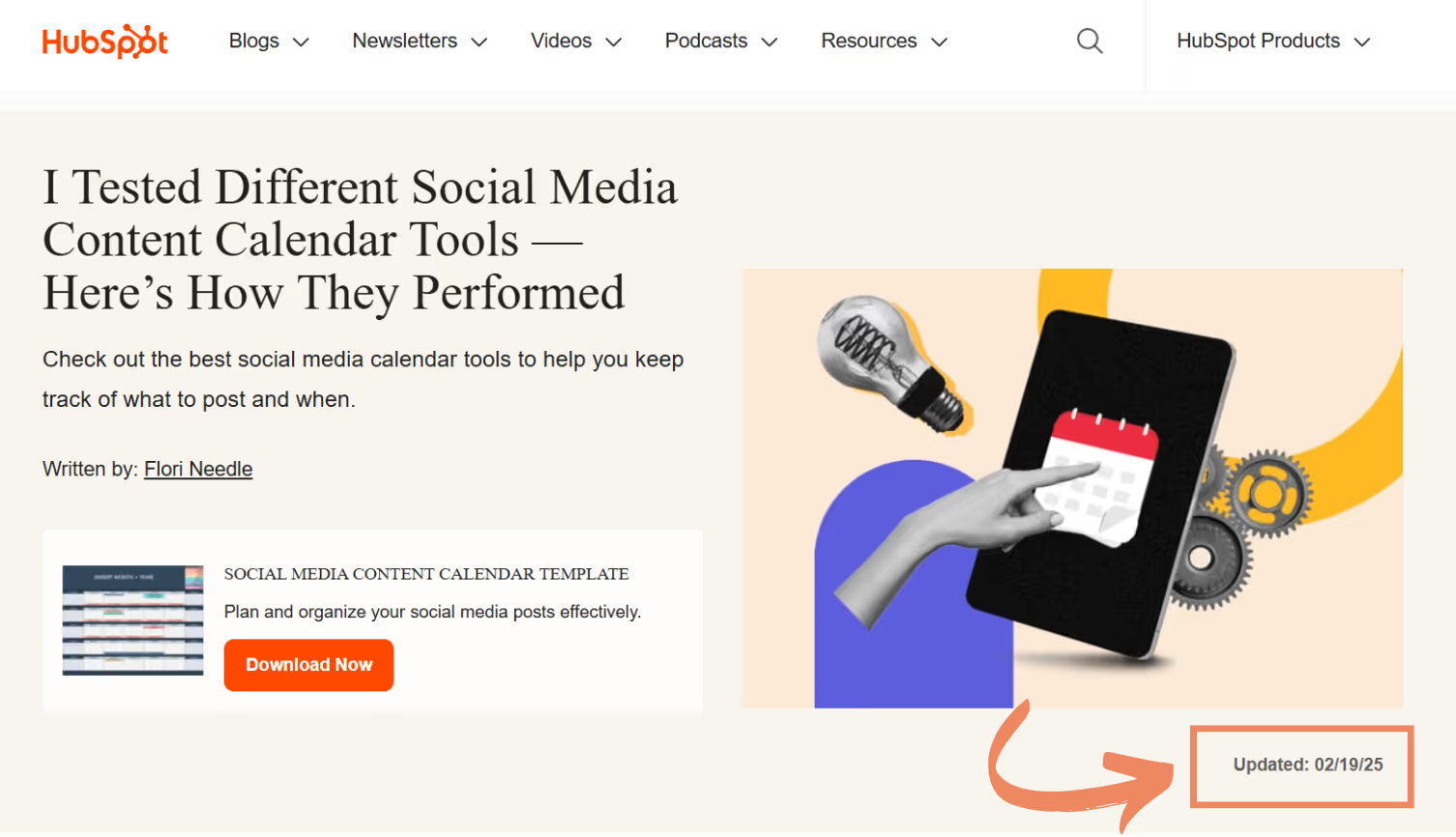
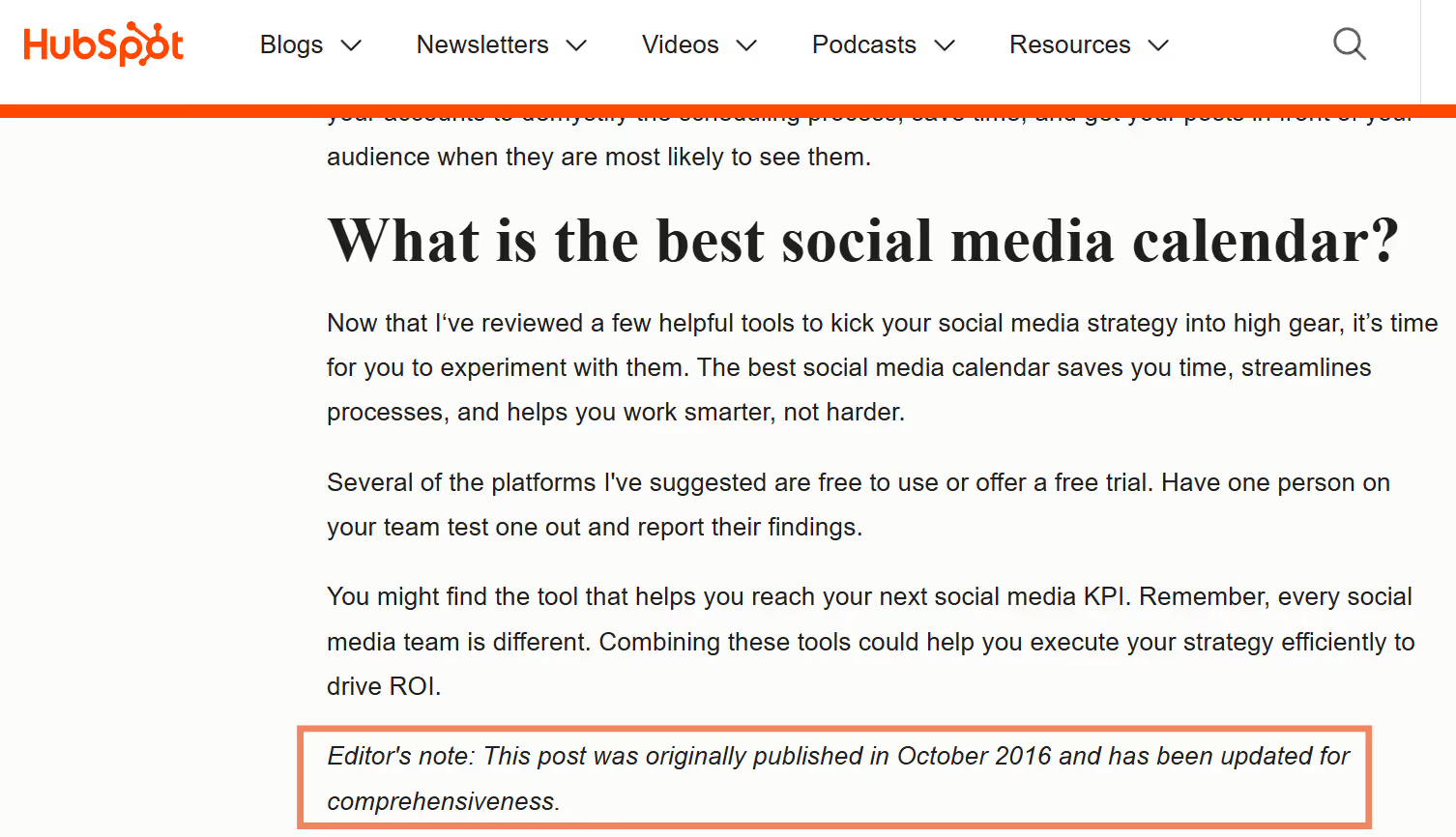
Source: Hubspot
They also built HubSpot Academy with free certifications. The courses teach you marketing concepts, then you practice with HubSpot tools. Smart, right? You learn for free, experience the product firsthand, and if it works... well, converting to paid suddenly makes sense.
Why It Works:
They're not pushing products. They're building credibility. Their content educates first, sells second (or third, or not at all). By consistently creating valuable and authoritative content, they earn quality backlinks from other reputable sites, further boosting their authority and search engine rankings. When you become the trusted guide, people come to you when they're ready to buy.
The Lesson:
Stop selling. Start guiding and establishing your topical authority. And please update your old winners, they're sitting there collecting dust when they could be collecting conversions.
- Semrush: Be the Resource, Not Just the Tool
The Setup:
Semrush is an SEO tool. So is Ahrefs. And Moz. And about 100 others. In a crowded market, how do you stand out?
What They Did:
They realized not everyone visiting their site is an SEO analyst with years of experience. Some are marketers who barely understand what a meta description is. Instead of assuming expertise, Semrush created an entire education ecosystem.
Free courses on technical SEO, keyword research, content strategy, with certificates you can actually put on your LinkedIn. And here's the genius move: the courses teach a bunch of these topics using demos of Semrush. You learn real skills, while subconsciously familiarizing yourself with the tool.
They also partnered with industry heavyweights like Brian Dean and Greg Gifford as course instructors. Borrowed authority used right.
Why It Works:
They're a one-stop shop. Learn SEO and get the tools to implement it. They've positioned themselves as thought leaders, not just software vendors. When you teach someone a skill, they associate that competence with your brand.
Plus, those certifications? Free resume boosters. People share them on social media, which is basically free marketing.
The Lesson:
Turn your expertise into credentials people actually want. And if you can borrow authority from industry leaders to teach your courses? Even better. You're not just selling software. You're building certified practitioners who already trust your platform.
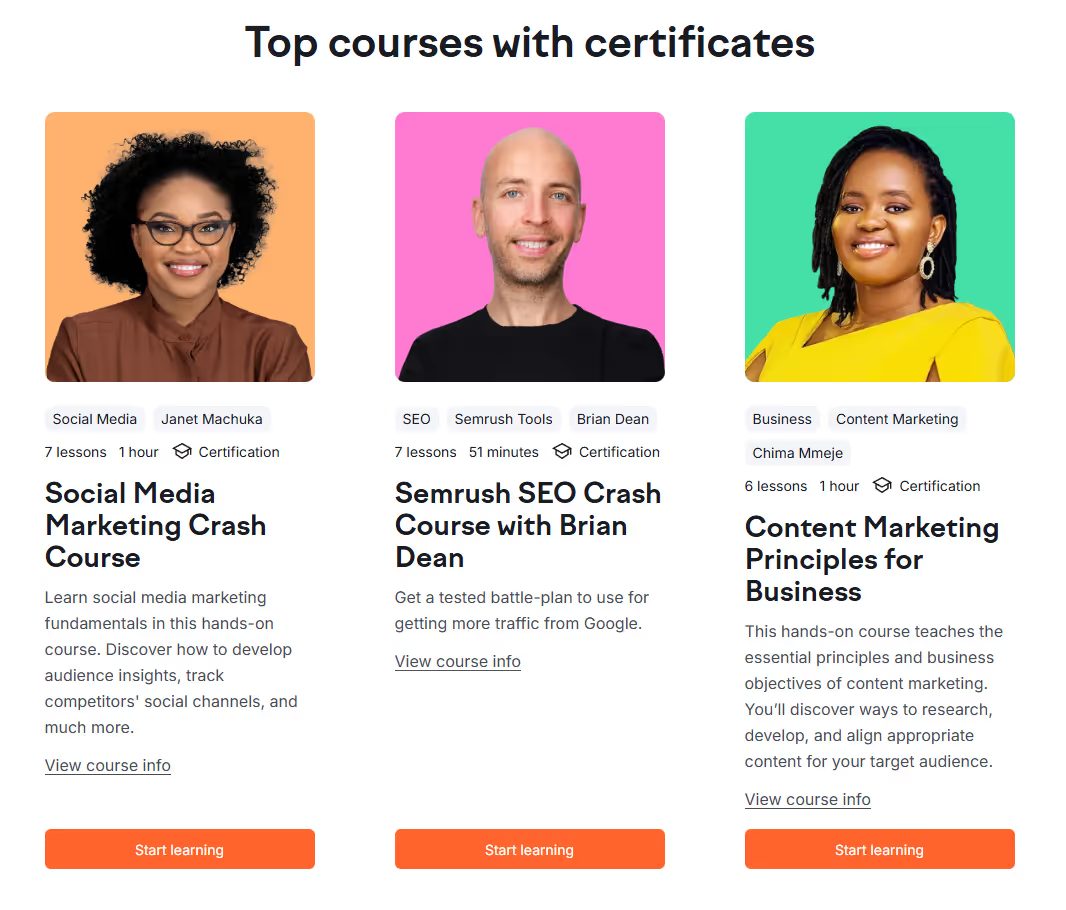
- Slack: Be Everywhere Your Audience Is
The Setup:
Slack exploded during COVID when everyone suddenly needed remote communication tools. But they didn't just ride the pandemic wave, they built a content strategy that works across every channel.
What They Did:
Cross-platform everything. Blog posts, podcasts, live events, on-demand webinars, and an extremely active social presence. Each piece of content complements the others. Blog posts become Twitter threads. Video tutorials get repurposed as Instagram clips. Podcasts distill complex topics for people who prefer audio.
They live by the motto: ‘Go where your audience goes, even if it's not a common channel.’
Why It Works:
They're platform-agnostic. Your target audience isn't just on LinkedIn or just reading blogs. They're everywhere, consuming different formats depending on context. Slack meets them wherever they are.
And everything connects. A podcast episode references a blog post. A social post drives traffic to a tutorial. It's a content ecosystem executed via a great content management system
The Lesson:
Don't put all your eggs in one basket. Repurpose relentlessly. And stop overthinking which channels are "professional enough" for B2B. If your audience is there, you should be too.
Notice the pattern in all the strategies? None of these are about keyword stuffing or winning algorithms. They're about being genuinely helpful in ways their competitors aren't. They provide valuable content, engage, repurpose, and show up consistently.
HubSpot educates. Semrush certifies. Slack meets you everywhere.
That's what winning seo driven content looks like in 2025. Not tricks. Not hacks. Just relentless commitment to being useful to your target audience.
Scaling SEO Content with AI, Analytics, and Data
AI is changing how teams scale SEO content but let's be clear: it's here to support human creativity, not replace it.
Think of AI as the Sheldon of your content team. A genius with data, pattern-spotting, and structure, but completely hopeless at reading the room. That's why it needs a Leonard: someone who can take all that precision and turn it into content that actually connects. Together, they're unstoppable, as long as you know who should lead the conversation.

The AI Advantage (and Its Limits)
AI tools can turbocharge your workflow. Use them for:
- Topic Ideation: Spot trending searches with tools like Clearscope, MarketMuse, SurferSEO, etc.
- Cluster Mapping: Group related themes automatically, so your strategy doesn't look like a conspiracy wall.
- Optimization: Get real-time readability and keyword suggestions.
Google's getting better at identifying AI-generated content that lacks genuine expertise or originality. Your content needs to pass what I call the "unique value test." If your competitor could write something similar with AI, you haven't created real value.
The Data-Driven Edge
The real competitive edge comes from how well you use your existing data and insights.
Here's how you can use analytics to be the brains behind your SEO operation:
Search Trends: Google Trends and Google Search Console to monitor website performance, track SEO rankings and reveal what your target audience actively wants. No more guessing.
CRM Insights: Your sales calls are gold. Real buyer questions, objections, and comparisons. Turn them into content.
But here's where most teams stop short. They track traffic and rankings, then wonder why leadership questions their budget. Organic traffic looks nice in reports. Rankings feel like progress. But if those visitors never become customers, what's the point?
Measuring What Actually Matters
Traditional SEO metrics track rankings, organic search traffic, backlinks. Great. But did revenue grow? Did you close deals?
Modern seo led content marketing connects it to business outcomes. Track which pieces drive qualified accounts, influence deal velocity, and correlate with conversions.
Consider two blog posts:
- Post A: 15,000 visits, #2 ranking, 200 signups → Zero opportunities
- Post B: 800 visits, #8 ranking, 12 opportunities → $380K closed revenue
Traditional metrics pick Post A. Impact metrics reveal Post B drives actual growth.
Stop optimizing for rankings. Optimize for revenue.
Scaling isn't about publishing more. It's about creating better content that stays true to your voice. Use AI for speed, but let humans bring in the creativity, and data bring in the clarity on what's actually working.
How Can Factors Help You?
So you've done the work. Built the clusters. Mapped the intent. Created content value-driven content. Brilliant. Now answer this: which piece drove the deal that closed last week? Can't say? That's the problem. And it's why most content teams spend more time defending their budget than doing their actual job.
Traditional SEO metrics are basically vanity metrics in disguise. "We got 50,000 pageviews this month!" Amazing. Did any of them become customers? "Our blog ranks #1 for this keyword!" Fantastic. Does that keyword bring people who can actually afford your product?
This is where Factors fundamentally changes the conversation.
From Traffic to Pipeline: The Real Metrics
Factors doesn't just tell you which content ranks or how many visits you got. It connects content performance directly to pipeline metrics. You can see which blog posts were visited by accounts that became MQLs, which progressed to SQL, and which created actual opportunities.
Imagine seeing: "This blog post drove 10,000 visits but zero opportunities" versus "This one drove 800 visits and generated 12 opportunities worth $450K in pipeline."
Suddenly your content prioritization becomes crystal clear.
Track Which Content Actually Wins Accounts
Factors tracks content engagement at the account level. You can see which specific assets attract your ideal customer profile accounts and map those interactions directly to pipeline and revenue.
No more guessing which topics resonate with buyers. You'll know exactly which content pieces show up in winning deal journeys versus lost opportunities.
Understanding Your Full Buyer Journey
Factors maps the complete path from anonymous visitor to closed deal. You can see:
- Which accounts visited which content and when
- How buyers move between stages (MQL → SQL → Opportunity → Closed-Won)
- Conversion rates and velocity at each stage
- Where accounts are dropping off and why
- The full sequence of touchpoints that influenced the deal
Cross-Channel Attribution That Actually Works
Here's where most attribution tools fail: they only track one channel at a time. Factors consolidates everything - website visits, ad engagement, sales calls, meetings - into a single dashboard
You can see the complete picture: the account that clicked on your LinkedIn ad, visited three blog posts, downloaded a whitepaper, then requested a demo. Not just fragmented data points, but the actual story of how they discovered and evaluated you.
💡Also read: Understanding Multi-Touch Attribution Models
Beyond First or Last Touch
Traditional attribution models - first touch, last touch - weren't built for complex B2B buyer journeys. Factors gives you complete visibility on every touchpoint that influenced the deal, not just the first or last one.
You'll finally be able to answer questions like: "Which marketing channels contribute most to our highest-value deals?" or "Do accounts that engage with our educational content close faster than those who don't?"
Built for B2B Buying Cycles
Unlike consumer-focused analytics tools, Factors is designed specifically for long, non-linear B2B sales cycles. It tracks at the account level (not just individual users), integrates with your CRM and sales tools, and understands that enterprise deals involve multiple stakeholders across months of evaluation.
To give you the gist
SEO optimized content in 2025 isn't about winning the rankings game. It's about winning the revenue game.
The shift from SEO and keyword optimization to intent-driven strategy isn't optional anymore. You can rank #1 for a hundred keywords and still contribute nothing to your bottom line. Or you can create focused, SEO driven content that brings fewer visitors but generates actual pipeline.
Build content clusters around real ICP problems. Track what drives deals through proper attribution. And update your old content instead of letting it collect digital dust.
The brands winning at SEO led content marketing right now aren't doing anything revolutionary. They're just being consistently useful while everyone else chases vanity metrics.
FAQs for SEO Content Strategy
Q: What's the difference between SEO content and content marketing?
A: SEO content targets search visibility, optimized for keywords and rankings. Content marketing is the broader strategy of creating valuable content across all channels. Best approach? Combine them. Create SEO driven content that ranks in search AND serves your target audience's needs. They're complementary, not separate.
Q: What's the difference between SEO and Search Engine Marketing (SEM)?
A: SEO focuses on organic search rankings through content and optimization. SEM includes both organic SEO and paid search advertising (like Google Ads). Think of it this way: SEO is the long game that compounds over time, while paid search gives immediate visibility. Smart B2B teams use both, paid ads validate topics and drive quick wins, while SEO builds sustainable pipeline without ongoing ad spend.
Q: Has there been a shift in search engine ranking?
A: Absolutely. Google's algorithms (BERT, MUM, SGE) now prioritize search intent over keyword matching. Rankings depend on content depth, user experience, and genuine expertise—not keyword density. The shift moved from "what target keywords can I rank for?" to "what problems can I solve better than competitors?" Quality and intent alignment win over optimization tricks.
Q: What is the ideal structure for a content piece?
A: Hook with a specific pain point, provide context on why it matters now, deliver actionable value (insights, frameworks, examples), and guide to next steps. Use subheadings every 200-300 words, short paragraphs, and scannable formatting. Internal links to related content build topical authority. Make it easy to skim but rewarding to read deeply.
Q: Should I focus on SEO and keyword optimization or user experience first?
A: Both. Write for humans, solve problems clearly. Then optimize: add target keywords naturally, use clear headings, include internal links, make it scannable. Modern seo and keyword optimization means helping search engines understand great content, not tricking them. Google rewards content that genuinely serves users.
Q: How do SEO and social media work together?
A: SEO builds discoverability, social media builds engagement. Repurpose top blog posts into LinkedIn carousels or Twitter threads. Use social signals to identify resonating topics, then create comprehensive blog content around them. Social activity drives brand searches and traffic, which indirectly boosts SEO performance. The integration of SEO and social media amplifies both channels.
Q: How can I scale SEO with AI, analytics, and data?
A: Use AI for topic ideation, keyword clustering, and content outlines. but keep the insights human. Combine three data sources: Search Console (what brings qualified traffic), CRM insights (real buyer questions), and engagement metrics (what resonates). Track which SEO topic categories drive pipeline, not just traffic. Scale based on revenue outcomes, not publishing volume.
Q: How can Factors help you with SEO led content marketing?
A: Factors connects content performance to pipeline metrics. See which blog posts drive MQLs, SQLs, and opportunities, not just pageviews. Track the full buyer journey from content visit to closed deal. Identify which SEO-led content marketing topics attract high-fit accounts versus random traffic. Stop defending budgets with traffic charts; prove value with pipeline reports.

The Practical Guide to SEO Benchmarking
Search engine optimization is a long game. Like… training-for-a-marathon long. You don’t wake up one morning magically ranking #1 (if only). But as your SEO efforts mature, you start collecting all kinds of shiny numbers, rankings, clicks, traffic charts that go up, down, and sometimes sideways.
But the BIG question is: Are those numbers actually good?
That’s where SEO benchmarking steps in (the reality check you actually need). It helps you compare your performance against something meaningful, your past results, your competitors’ wins, or the wider industry’s average pulse.
In this blog, we’re breaking down how to set benchmarks that matter (not just vanity metrics), which numbers to track without losing your sanity, and how to turn all that data into actions that genuinely move the needle.
TL;DR:
- Know if your SEO is actually working. Compare your metrics to past performance, competitors, or industry standards.
- Stop guessing which metrics matter. Track search visibility, keyword rankings, organic search traffic, conversions, content quality, and technical health.
- Follow a proven 7-step process. Define scope, pick KPIs, gather data, add competitors, normalize, analyze gaps, and set targets.
- Turn data into action. Identify what's holding you back and where to double down.
- Report strategically. Weekly on issues, monthly on progress, quarterly on strategy.
- Avoid vanity metrics. Focus on benchmarks that drive real business growth.
What is SEO Benchmarking?
Think of benchmark SEO as setting reference points for measuring your search performance. Let's say your site had 10,000 organic sessions last month. That's your benchmark. Now, your goal might be to hit 15,000 sessions next quarter.
The benchmark becomes your baseline expectation that you need to exceed, not a target you must achieve.
But benchmarking SEO performance only works when you're comparing your numbers to something specific. That could be your past performance, what your competitors are doing, or industry averages. Without these reference points, you're just collecting numbers without any real context.
Benchmarks vs KPIs vs Metrics in SEO
You'll often hear these three terms used interchangeably, but they actually play different roles in how you measure and strategize your SEO efforts. Let me break down what each one means.
These three elements work together to create your measurement framework.
Key metrics give you the raw numbers, benchmarks provide the context for those numbers, and KPIs point you in the right direction. When all three are working together, you've got a solid foundation.
Without them, you're either drowning in meaningless data or setting goals without knowing if they're even realistic
Why Does SEO Benchmarking Matter?
Without benchmarks, you see numbers go up or down, but can't really tell if you're winning or losing. Good benchmarking helps you turn raw data into insights that help drive improvements.
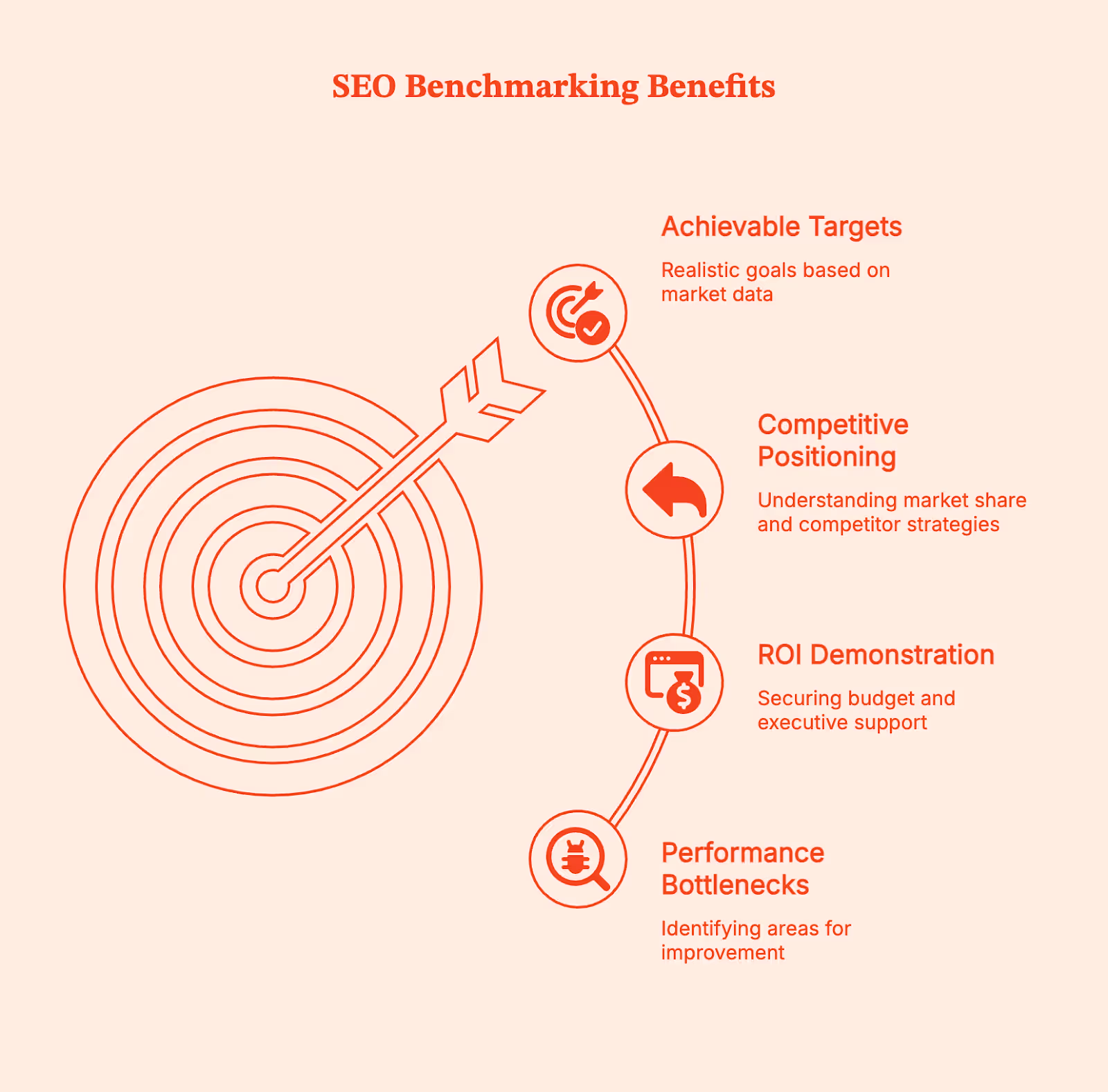
So what can effective benchmarking actually reveal? Let me walk you through it:
- Identifying Performance Bottlenecks
Benchmarking shows you exactly where your SEO strategy is falling apart.
Maybe your blog posts rank well and bring in traffic, but your product pages are stuck on page two. That tells you exactly where to focus your content optimization efforts.
On the flip side, you may be getting tons of clicks from search engine results pages, but if your conversions are lagging behind industry standards, the real problem isn't visibility but your landing page experience, how clear your offer is, or whether you're targeting the right people.
When you benchmark different content types, funnel stages, and user segments against each other, these patterns become crystal clear. Instead of spreading your resources thin across everything, benchmarking pinpoints the specific bottlenecks that, once you fix them, will give you the biggest wins.
- Demonstrating ROI and Securing Buy-In
Benchmarking gives you the proof you need to secure budget, headcount, and executive support. Without hard numbers, search engine optimization SEO stays stuck in the "nice to have" category.
Maybe you've been running SEO campaigns for six months, organic search traffic is climbing, but when budget season rolls around, leadership asks, "What's the actual return?"
If all you can say is "keyword rankings improved" or "we're getting more traffic," you're competing for resources with channels that show clear revenue impact.
But when you can walk into that meeting and say, "Our organic traffic jumped 42% quarter over quarter, our top 3 rankings doubled from 15 to 30 keywords, and our organic conversion rate climbed from 2.1% to 3.4%," you're speaking the language of business results.
That's measurable growth tied directly to the bottom line.
This is where benchmarking turns SEO into a strategic priority because it demonstrates ROI in terms that leadership actually cares about.
- Understanding Competitive Positioning
SEO performance doesn't exist in a vacuum. Let's say your organic traffic grew 10% but your competitors grew 40% during the same period. In reality, you're actually losing market share. Industry benchmarks show you whether you're keeping pace, pulling ahead, or falling behind.
On top of that, competitor analysis reveals what's actually possible when you have similar resources. It helps you pinpoint the specific areas where competitors are outperforming you, whether that's content depth, technical performance, backlink acquisition, or SERP feature ownership.
This context becomes absolutely critical when you're setting realistic expectations and figuring out which initiatives will close the most important gaps.
- Setting Achievable, Data-Driven Targets
Goal setting without benchmarks is guesswork.
You might target 100,000 monthly visits just because it sounds like a nice round number, even though competitors with similar resources and market position are only getting 50,000.
Benchmarking grounds your targets in what's actually realistic.
For example, if competitors in your space with comparable domain authority and content volume are hitting 3.5% CTR, that becomes a meaningful target instead of just some abstract aspiration. Goals driven by benchmarks are way more likely to earn stakeholder buy-in because they're rooted in demonstrated market performance rather than wishful thinking.
Now, all these benefits only work if you're tracking the right metrics and comparing them against meaningful reference points.
Now, all these benefits only work if you're tracking the right metrics and comparing them against meaningful reference points.
Essential SEO Metrics to Benchmark: What to Track for Maximum Impact
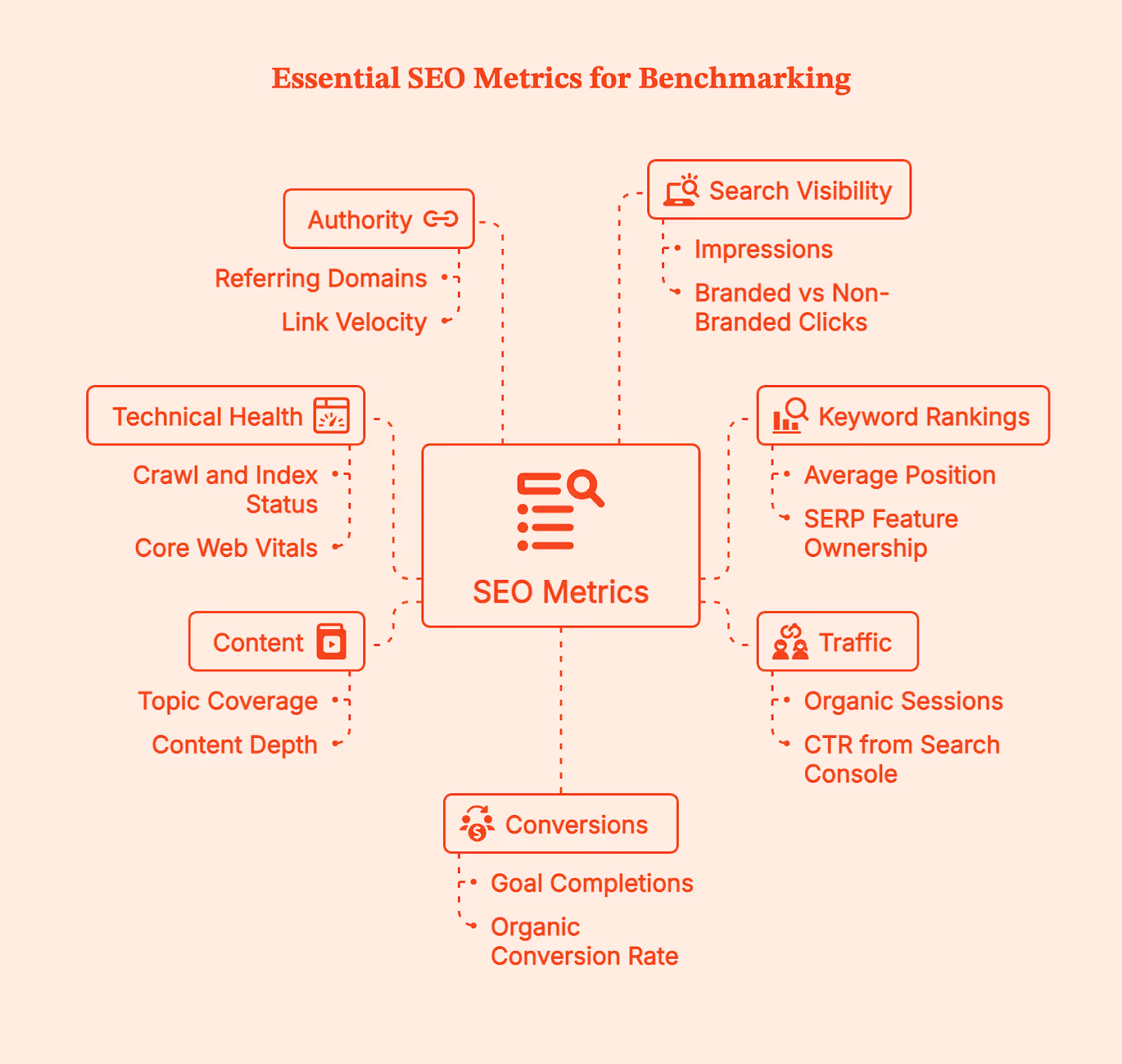
You can track endless data, but these are a few important metrics you must start with before adding anything else to your list.
- Search Visibility: Impressions (how often you appear in results), branded keywords vs non-branded clicks (are people finding you or searching for you?), total ranking keywords, and share of voice (your percentage of available clicks).
- Keyword Rankings: Average position for priority keywords, percentage in top 3 and top 10 (position 1 gets 28% of clicks, position 10 gets under 2%), and SERP feature ownership (snippets, People Also Ask boxes).
- Traffic: Organic sessions, CTR from Search Console (varies by industry: healthcare averages 3.3%, legal 6.6%), and average engagement time.
- Conversions: Goal completions, organic conversion rate, lead quality (MQL/SQL rates), and revenue attribution.
- Content: Topic coverage vs competitors, content depth compared to top results, and freshness.
- Technical Health: Crawl and index status, Core Web Vitals (LCP, FID, CLS), site speed, broken links, and internal linking.
- Authority: Referring domains (backlinks remain a top factor), link velocity, and domain authority scores.
Here's the thing, though: tracking these metrics for your own site is just the starting point. Your website performance only really makes sense when you stack it up against competitor performance.
How to Conduct Competitive SEO Benchmarking?
Your business competitors aren't always your search competitors.
For instance, an analytics platform might compete with sales enablement tools for keywords like 'revenue performance dashboard' or 'pipeline visibility,' even though they solve completely different problems.
So, how do you find your real search competitors? Search your target keywords and take note of who consistently appears in the top 10. If they rank for 60% of your tracked keywords, they're a direct competitor.
Once you've identified your competitors, you'll want to run some gap analyses:
- Keyword gap: What are they ranking for that you're not?
- Content gap: What topics have they covered in depth that you've barely touched?
- Backlink gap: Where are they getting links that you're not?
- SERP feature gap: Are they owning snippets for keywords where you rank but don't have features?
After that, you'll want to measure the delta. If a competitor gets 50,000 monthly visits and you get 20,000, that's a 2.5x gap. You can break this down by category to figure out where to focus your efforts.
Beyond just understanding these gaps, you'll also need to run a systematic benchmark that captures all this data.
How to Run a Complete SEO Benchmark: A 7-Step Process for Measuring Performance
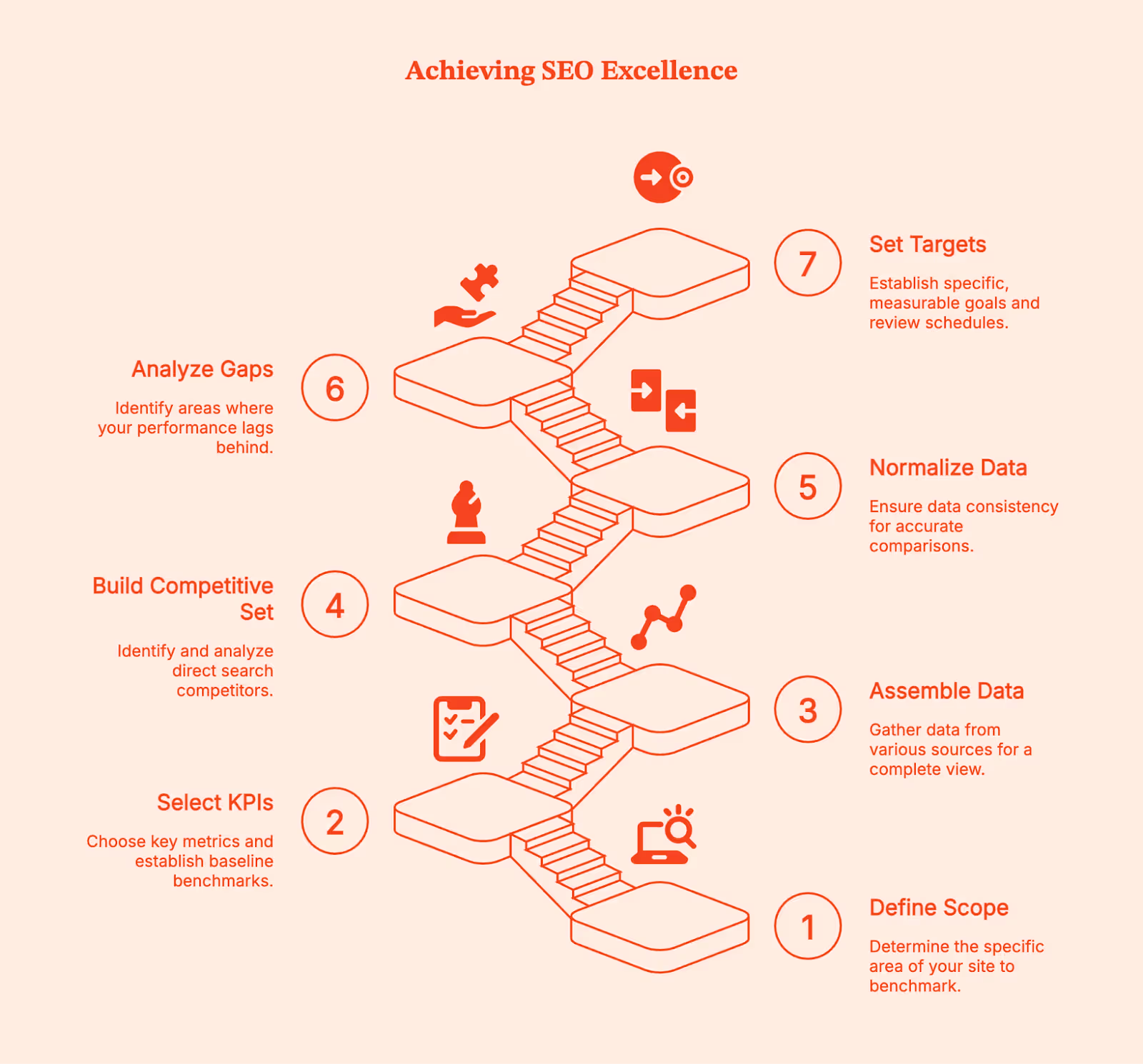
To run an effective SEO benchmark, you need a structured approach. Here are seven steps that'll help you establish meaningful baselines, spot opportunities, and set achievable targets.
Step 1: Define Your Benchmark Scope
First things first: what exactly are you benchmarking? Think about whether you're measuring your entire site, a specific product category, a content hub, or a particular funnel.
Your scope should align directly with your business goals. If you're launching a new SaaS platform for lawyers, benchmark that category specifically. If you're trying to build thought leadership, focus on your blog or resource center.
Trying to benchmark everything at once dilutes your focus and makes it harder to identify actionable patterns. If the objective is to increase demo requests, you'll prioritize conversion metrics and commercial intent keywords rather than top-of-funnel traffic.
Step 2: Select KPIs and Establish Baseline Benchmarks
You'll want to select 10-15 SEO key performance indicators that directly align with your defined goals. It's easy to get swayed and track all possible metrics, but focusing only on the ones that absolutely matter will give you the clearest insights.
Each KPI needs a precisely documented baseline. If your goal is to increase conversions by 25%, you need to know your exact starting point: current conversion count, conversion rate, and the time period measured.
Consistent measurement windows (e.g., 30 days, 90 days) help ensure accuracy, and documenting any seasonal factors that might affect your baseline is equally important. This baseline becomes your primary reference point for measuring SEO progress.
Step 3: Assemble Your Data Sources
Effective benchmarking requires pulling data from multiple sources to get a complete picture.
At minimum, you'll need:
- Google Search Console for impressions, clicks, CTR, and average position
- Google Analytics for traffic patterns, user behavior, and conversion tracking
- A rank tracker for historical ranking data and competitor visibility
- A crawl tool like Screaming Frog or Sitebulb for technical SEO metrics
- And a backlink index, such as Ahrefs or Semrush, for backlink profile analysis
Setting up regular data exports or API connections means you can track search engine rankings over time without manual data gathering eating up your schedule.
Step 4: Build Your Competitive Set
You'll then need to identify 3-5 direct search competitors. They don't necessarily need to be business competitors, but the sites that consistently rank for your target keywords.
Keyword overlap serves as your primary filter: if a site ranks for 40% or more of your priority keywords, they're a direct search competitor.
They should also target similar audiences and have comparable resources (similar domain authority, content volume, team size). It's best to avoid comparing yourself to industry giants with 10x your resources and instead focus on competitors you can realistically overtake with strategic execution.
Step 5: Normalize Your Data for Fair Comparison
Data consistency is critical for accurate benchmarking. Use identical date ranges for all comparisons. For instance, compare January to January, not January to December, to account for seasonality.
If you're comparing mobile performance, make sure all data sources are filtered to mobile devices.
If you operate in specific markets, geographic regions need to align as well. When comparing to competitors, using the same seo tools and settings is essential. Inconsistent data normalization leads to false conclusions and misguided strategy decisions.
Step 6: Analyze Gaps and Prioritize Opportunities
Once your data is normalized, you can identify the biggest gaps between your SEO performance and your benchmarks (both historical and competitive).
Patterns will start to emerge: Are you losing ground in specific content categories? Do competitors dominate certain SERP features?
Technical performance might be holding you back.
The ICE framework helps you prioritize fixes: Impact (how much will this move the needle?), Confidence (how sure are you it will work?), and Ease (how quickly can you implement it?).
Quick wins include fixing technical errors that block high-value pages, updating thin content on keywords where you rank on page 2, and adding internal links to orphaned content that's not getting crawled effectively.
Step 7: Set Specific Targets and Schedule Reviews
Set concrete, measurable targets with clear owners and a deadline.
For instance, "Increase non-branded sessions from product pages by 30% by Q3, owner: Sarah" is far more actionable than "improve traffic."
Additionally, break large goals into monthly milestones, allowing you to course-correct quickly if you're falling behind.
Schedule your next review based on your site's velocity: monthly reviews work for most sites, quarterly reviews suit slow-moving industries or smaller sites, and weekly reviews are appropriate for high-velocity businesses like news sites or large e-commerce platforms with frequent inventory changes.
How to Structure an Effective SEO Keyword Benchmark Report
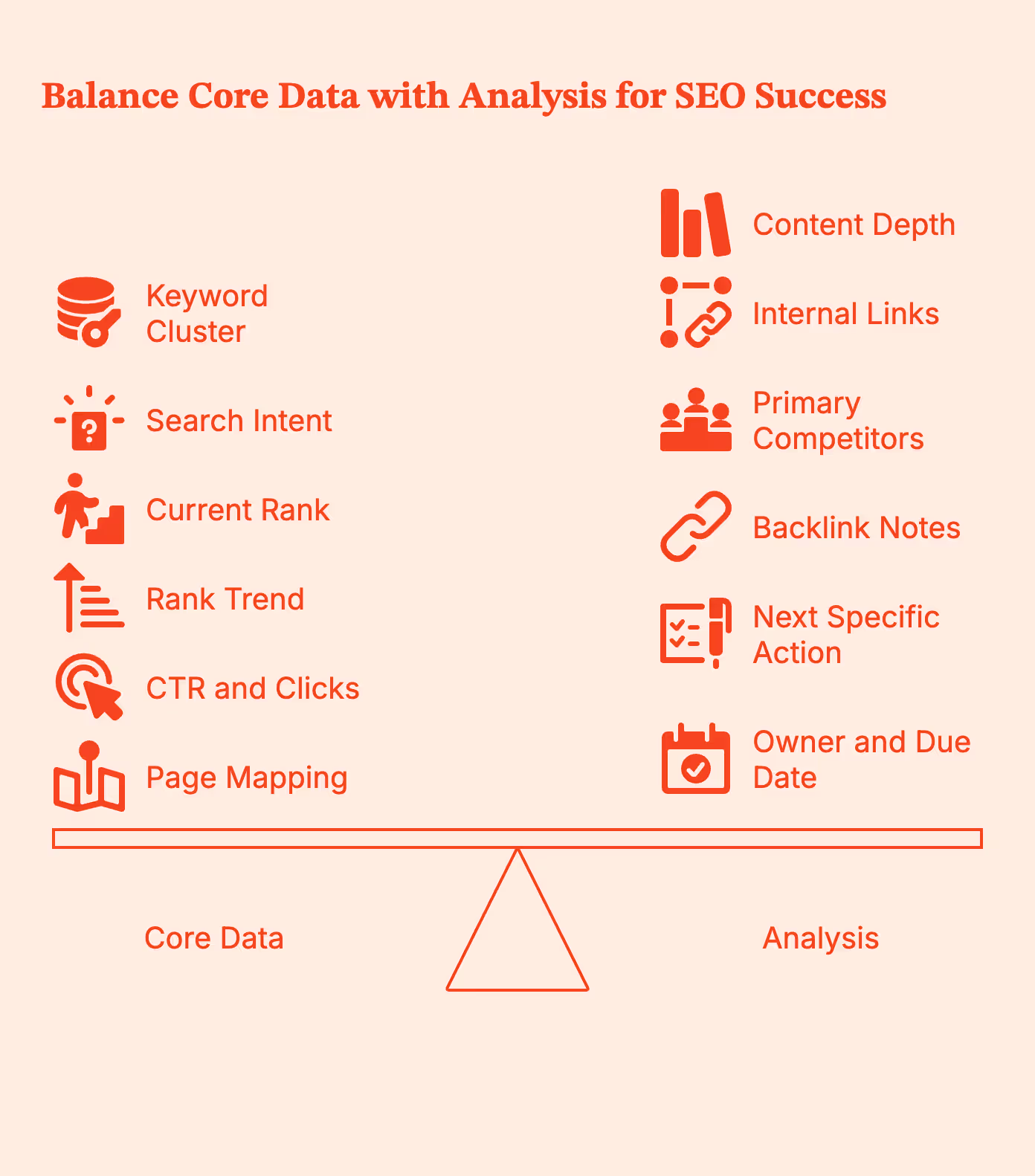
Structure your report with these columns:
- Core data: Keyword cluster (group related terms), search intent (informational/commercial/transactional), current rank, rank trend, CTR, clicks, and page mapping (which page targets this given keyword).
- Analysis: Content depth vs competitors (thin/adequate/comprehensive), internal links pointing to page, primary competitors in positions 1-3, and backlink notes.
- Action: Next specific action ("rewrite intro", not "optimize"), owner, and due date.
Then, set up views for regional, device type, brand vs non-brand, and intent type.
Create three sections:
- Top Movers: Biggest ranking changes (up/down) in 30 days
- Quick Wins: Keywords in positions 4-10 where small improvements drive more traffic
- Blocked by Tech: High-value keywords where technical issues prevent better performance
The structure matters, but so does timing. Different stakeholders need different reporting frequencies.
How Often Should You Review SEO Benchmarks and Set Performance Targets?
- Weekly: Track critical changes only: major ranking shifts, technical errors, traffic anomalies. Flag what needs immediate attention.
- Monthly: Compare benchmarks to targets. Review traffic/conversion trends, ranking progress, new SEO content performance, and technical health. Did you hit goals? Where are you ahead or behind?
- Quarterly: Full benchmark reset. Compared to the previous quarter and year-over-year. Reassess competitive set. Answer bigger questions: Are content pillars working? Should we shift the budget? Do we need different keywords?
Essential SEO Benchmarking Tools and Ready-to-Use Templates
- All-in-one platforms: Ahrefs, Semrush, or Moz handle seo keyword research, position tracking, backlink monitoring, and competitive research. Ahrefs excels at backlink data, Semrush has strong PPC integration, and Moz focuses on simplicity.
- Site crawlers: Screaming Frog or Sitebulb find technical issues. Run monthly crawls to benchmark health.
- Best keyword research tools: Google Keyword Planner for search volume and keyword ideas, Ahrefs Keywords Explorer for related keywords and search queries, and Semrush Keyword Magic Tool for building a comprehensive keyword list with niche keywords.
- Essentials: Google Analytics for analytics tracking and Google Search Console (impressions, clicks, CTR, position). Non-negotiable for website owners and SEO professionals.
- Dashboards: Google Data Studio, Tableau, or Databox visualize benchmarks and automate client reporting.
- Third-party tools: Consider specialized tools like Google Business Profile for local businesses and other SEO tools for link building and on page SEO analysis.
- Template structure: Include sheets for an overview dashboard, keyword performance by cluster, competitive comparison grid, technical health checklist (including meta descriptions, meta title, and page SEO), content gap analysis, and monthly snapshots.
Beyond internal tracking, your benchmark data has another valuable use: thought leadership.
How to Turn Your SEO Benchmark Data into Thought Leadership Content

The steps you take to successfully benchmark SEO data can be used to create content for people struggling with the same. Here's how you can easily create thought leadership content:
- Document methodology: Explain date ranges, tools, and sample size. Transparency builds credibility when discussing your content strategy.
- Create anonymized cohorts: Group by industry, company size, or traffic level. Share percentile ranges, not specific numbers: "Median healthcare CTR was 3.2%, 75th percentile at 4.1%."
- Design clear charts: One insight per chart. Show benchmark ranges, year-over-year trends, and performance distribution to demonstrate SEO success.
- Repurpose everywhere: Break into 5-10 blog posts, create social graphics with stats, pitch publications with exclusive findings, build sales materials, and update annually to attract more website visitors.
This content drives organic search traffic, builds authority, and gives your sales team data for conversations. It also helps you compare organic results against Google Ads campaigns to understand your full search presence.
In a Nutshell…
I’m hoping that by now you agree that SEO benchmarking is all about making that data work for you.
By comparing performance to meaningful baselines, competitors, and market standards, you move from aimless reporting to focused, strategic action. When you set the right scope, choose metrics that align with business outcomes, and analyze consistently over time, benchmarking becomes the signal.
This guide gave you a step-by-step process to track what truly matters, spot opportunities where others overlook them, and report in a way that resonates with decision-makers. Whether you’re tracking performance monthly or reviewing quarterly trends, benchmarking helps you sharpen focus, improve ROI visibility, and stay one step ahead of your search competition.
Bottom line: good SEO is about knowing what’s working, what’s not, and what’s next.
FAQs for SEO Benchmarking
Q. What does an SEO report mean?
A. A summary of performance vs goals and benchmarks, with insights and next steps. Not a data dump. Good reports answer three questions: Where are we? How does that compare? What do we do next?
Q. How often should I benchmark?
A. Track weekly for issues, review monthly against benchmarks, and realign quarterly for strategy. Adjust based on site scale and volatility.
Q. What are good benchmarks for CTR and conversions?
A. CTR varies by industry: healthcare, 3.3%, legal, 6.6%. Compare these to Google Ads benchmarks for a full picture. E-commerce conversion averages 2.5-3%, B2B leads 2-5%. Your baseline matters more than industry averages. Focus on improving your own performance and track keyword rankings consistently.
Q. Which tools are best for competitive benchmarking?
A. Combine Semrush or Ahrefs (keywords, content, backlinks), Screaming Frog (technical), and Google Search Console + Google Analytics (your own data). All-in-one platforms handle most needs for tracking keyword performance.
Q. How do I create a compelling keyword report for leadership?
A. Lead with goals and changes. Start with a one-page summary showing status vs goals, three wins, three risks, and top actions for 90 days. Use visuals and color coding: green for on-target clusters, yellow for at-risk, red for problems. Show the 30 highest-value keywords, not all 500. End with clear budget or approval requests tied directly to benchmark gaps.
.avif)
MQL vs SQL: The Key Difference Driving Sales & Marketing Alignment
Every successful revenue engine depends on one thing: the ability to separate interested prospects from real buyers. No matter how much traffic your website attracts or how many campaigns you run, growth only happens when you can identify which leads deserve immediate sales attention and which ones need nurturing. The primary difference between a Marketing Qualified Lead (MQL) and a Sales Qualified Lead (SQL) is the lead's purchase intent and the specific marketing or sales approach required for each.
Think of it like dating; not everyone who shows interest is ready for a relationship. Some are only demonstrating initial interest and just want to know more, while others are ready to commit. Your job is to figure out who’s who. That’s where lead qualification (this blog) comes in.
Also, read lead generation 101.
TL;DR
- MQLs are leads showing early engagement and curiosity, not ready to buy but open to nurturing.
- SQLs show strong intent with actions like demo requests, pricing inquiries, or product comparisons, ready for direct sales outreach.
- Clear qualification turns a messy funnel into a predictable revenue engine.
- Sales and marketing alignment ensures smooth handoffs and faster conversions.
- Shared lead scoring models and automated workflows keep teams focused on the right leads.
- Tools like Factors track signals, trigger actions, and surface opportunities in real time.
- Avoid common pitfalls like pushing leads too early, waiting too long, or misjudging intent.
- AI-driven predictive lead scoring, real-time intent data, and deeper attribution are shaping the future of lead qualification.
- Nailing the MQL-to-SQL transition means more pipeline, higher win rates, and scalable growth.
What is sales funnel and lead management
Think of the sales funnel as a filtering system. At the top, you have a broad mix of visitors, blog readers, ad clickers, webinar attendees, and curious trial users. But like I said above, not everyone at the top is ready to buy. Some are just exploring, some are gathering information, and only a fraction have genuine purchase intent.
Lead management is the process of sorting through this noise, qualifying leads based on data and signals, and ensuring that the right contacts move from one funnel stage to the next. When done correctly, this process eliminates wasted sales effort, aligns marketing with revenue goals, and drives higher win rates.
Importance of effective lead qualification in business growth
A poorly qualified funnel is like running ads with no targeting: expensive and inefficient. You might get lots of clicks, but if none of them turn into customers, what’s the point? It’s like throwing darts in the dark; you’re bound to miss most of the time. And those misses hurt your metrics, drain time, energy, and resources across the team.
Often, sales reps waste hours chasing leads who were never going to buy, while high-intent prospects slip through the cracks. Flip that equation with proper lead qualification, and the difference is dramatic:
- Higher conversion rates - because sales only talks to leads that match your ICP and show intent.
- Shorter sales cycles - because SQLs (Sales Qualified Leads) are contacted at the right buying moment.
- Better marketing ROI - because budgets are focused on campaigns that generate quality leads, not vanity metrics.
The difference between a scalable revenue engine and a stalled pipeline often comes down to how clearly a company defines and manages MQLs and SQLs.
What are MQLs and SQLs
Marketers and sales teams often throw these acronyms around, but definitions vary widely across companies. Because if you’ve ever been in a marketing meeting, you’ve probably heard these terms tossed around like confetti.
Let’s see:
- MQL (Marketing Qualified Lead): A lead that has engaged with your marketing (downloaded an eBook, signed up for a newsletter, attended a webinar) and fits your ICP. They’ve shown interest but aren't ready to buy yet.
- SQL (Sales Qualified Lead): A lead that has crossed the intent threshold. They’ve either requested a demo, asked for pricing, or engaged in behavior that indicates they’re evaluating solutions seriously. Sales can confidently prioritize them.
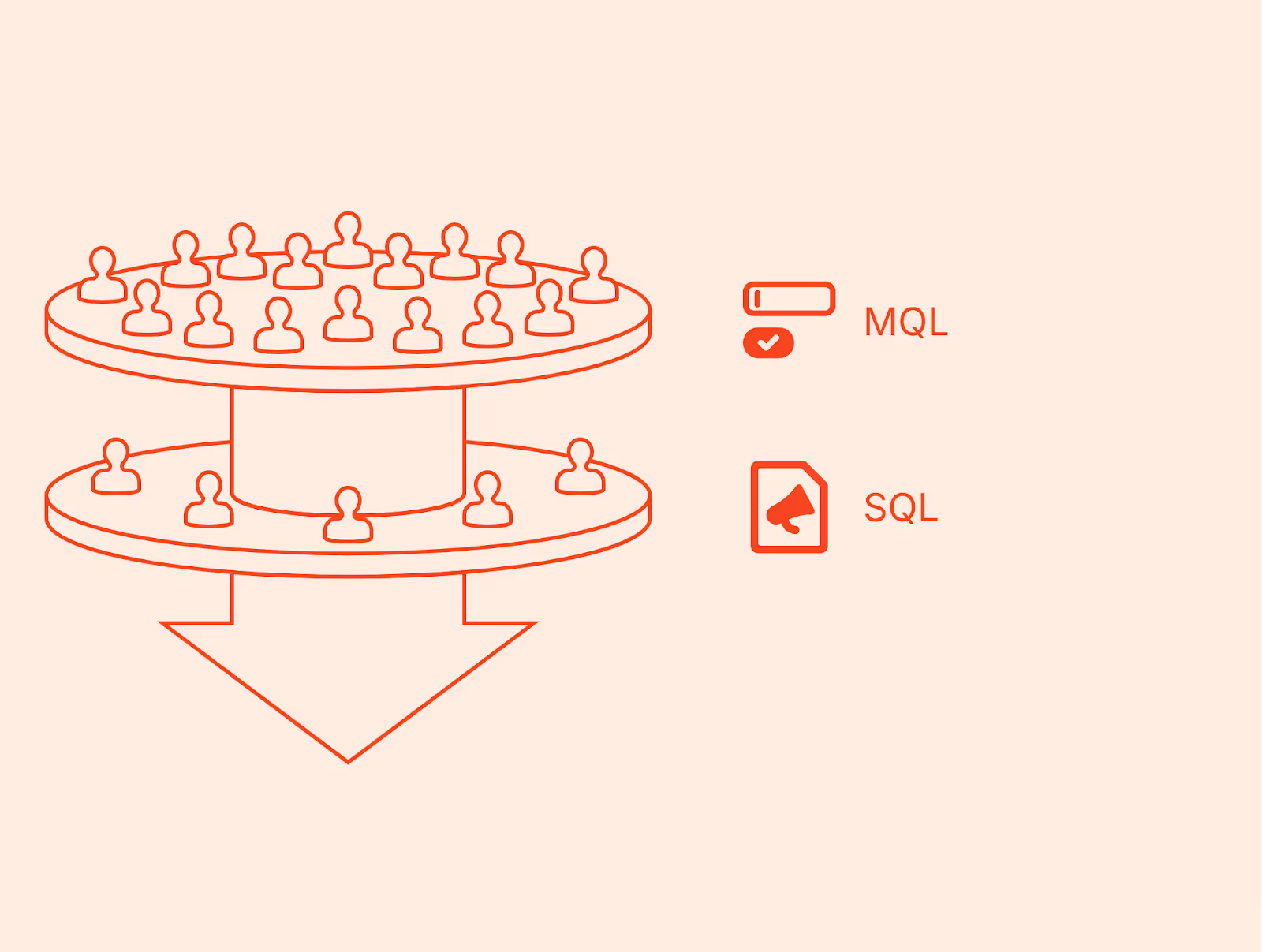
This is where the MQL vs SQL distinction matters most. MQLs are nurtured until they’re ready, while SQLs are handed off immediately to sales for follow-up. Confusing the two wastes resources and leads to frustration on both sides.
How MQLs and SQLs fit into the overall sales and marketing strategy
Think of MQLs and SQLs as two gears in the same machine. Marketing creates awareness and nurtures prospects into MQLs. Once the lead shows clear buying intent, it becomes an SQL and enters the sales pipeline.
When marketing and sales align on what qualifies as an MQL vs SQL, the handoff becomes seamless. Marketers can measure success in terms of how many MQLs convert into SQLs, while sales can focus their energy on leads that are truly ready to buy. This shared framework strengthens collaboration, reduces missed opportunities, and ultimately drives more predictable revenue growth.
What is the main difference between MQL and SQL
In sales and marketing, the line between interest and intent is razor-thin. Misjudge it, and you either push leads too soon (risking churn) or wait too long (missing the buying window). That’s why the distinction between MQL and SQL is critical. Let’s break down the key differences.
Also read https://www.factors.ai/blog/post-sale-customer-journey-framework
What is an MQL? And what are its characteristics?
A Marketing Qualified Lead (MQL) is a prospect who has interacted with your brand in meaningful ways but is not yet ready for a direct sales pitch.
- Definition: A lead that meets baseline ICP criteria and has shown early buying interest through marketing channels.
- Signals: Downloaded an eBook, attended a webinar, engaged with multiple emails, or browsed your product pages.
- Stage: Middle of the funnel, aware of their problem, exploring potential solutions.
- Action required: Nurturing through content, ads, and automated workflows.
In short, an MQL is a potential buyer who says, “I’m interested, but not just yet.”
What is an SQL? And what are its characteristics?
A Sales Qualified Lead (SQL), on the other hand, is ready for direct engagement.
- Definition: A lead that has demonstrated clear buying intent and meets sales-readiness criteria.
- Signals: Requested a demo, visited the pricing page multiple times, asked for a product comparison, or directly contacted your team.
- Stage: Bottom of the funnel, actively evaluating vendors or making purchase decisions.
- Action required: Timely outreach from SDRs or AEs, qualification calls, and opportunity creation.
An SQL essentially says, “I’m evaluating solutions. Convince me why yours is the right fit.”
Criteria used to identify MQLs vs SQLs
The SQL meaning marketing teams use often varies, but successful organizations define clear, measurable criteria. In other words, guessing isn’t an option here; the clearer your criteria, the less time your team wastes chasing the wrong people.
Here’s what typical MQL criteria often include:
- MQL criteria:
- Fits ICP (industry, size, persona)
- 3+ high-intent web visits in 30 days
- Consumed gated content (eBook, case study, whitepaper)
- Opened multiple nurture emails
- SQL criteria:
- Completed demo or trial sign-up
- Multiple visits to pricing or product comparison pages
- Responded positively to sales outreach
- Scoring threshold surpassed (e.g., >80 points)
(For more on scoring models, read Unlocking the Secrets of Lead Scoring Models)
The Role MQLs and SQLs play in the customer journey
- MQLs: Fuel the middle of the funnel. They show interest, need education, and are not yet ready to be approached by sales.
- SQLs: Fuel the bottom of the funnel. They are closer to a purchase decision, ready for sales engagement, and need tailored conversations.
Without MQLs, the funnel dries up. Without SQLs, the funnel never converts. Together, MQL and SQL form the backbone of a healthy pipeline.
Also read https://www.factors.ai/blog/stages-of-the-customer-journey
Common indicators and signals for qualification
- Behavioral: Content downloads, repeat visits, webinar registrations → MQL. Demo requests, trial usage, pricing page visits → SQL.
- Firmographic: Company size, industry, revenue → filters for both MQL and SQL qualification.
- Technographic: Tools currently in use → helps decide sales relevance.
- Intent signals: Ads engagement, G2 research, product activity.
At a glance: Here’s how MQLs and SQLs differ
Here’s why the distinction matters
When teams blur SQL vs MQL definitions, the entire revenue process breaks. It’s a bit like passing the baton in a relay race. If one team doesn’t know when to hand it over, the whole thing slows down (or worse, collapses).
And that’s exactly what happens in many organizations: marketing floods sales with unready leads (hurting SDR efficiency), or sales misses high-intent leads because they weren’t flagged in time. Clear separation ensures:
- Marketing measures success by MQL→SQL conversion.
- Sales measures success by SQL→Opportunity conversion.
- Leadership sees predictable pipeline progression across the funnel.
To understand how sales and marketing can collaborate better at this stage, explore our 6 Tips to Align Sales and Marketing Teams.
Challenges and pitfalls: Common traps when defining MQLs vs SQLs
Even experienced teams encounter difficulties when drawing the MQL/SQL line. Common pitfalls include:
- Overqualification: Labeling too many leads as SQLs before they’re ready. This leads to wasted outreach and sales fatigue.
- Underqualification: Holding onto MQLs for too long, which delays engagement and causes competitors to swoop in first.
- Siloed systems: Marketing automation platforms and CRMs that don’t sync create inconsistent lead statuses, confusing SDRs.
- Lack of feedback loops: Without sales feedback, marketing doesn’t know which MQL behaviors actually predict SQL conversion.

Avoiding these pitfalls requires both technology (CRM + automation) and process discipline (weekly feedback loops, clear scoring rules, documented SLAs).
Why the MQL–SQL Distinction Matters for Growth
At the end of the day, the MQL vs SQL distinction is about more than labels. It’s about ensuring your revenue engine runs efficiently:
- Marketing focuses on quality, not just volume.
- Sales focuses on timing, not just effort.
- Leadership gains predictability across the funnel.
Get it right, and your funnel becomes a growth multiplier. Get it wrong, and it becomes a costly bottleneck.
Here’s how defining MQLs and SQLs impacts business growth
The distinction between MQLs and SQLs isn’t just a matter of terminology; it has direct, measurable consequences on how efficiently a business grows. Companies that clearly define and operationalize MQL vs SQL are able to build predictable revenue systems. Companies that blur the line struggle with wasted effort, lost deals, and misaligned teams.
- Impact of lead qualification on sales pipeline efficiency and conversion rates
One of the strongest outcomes of proper qualification is improved pipeline efficiency.
- Higher-quality SQLs mean higher conversion rates. If sales is handed leads who are already showing intent signals, win rates increase naturally.
- Shorter cycle times. When SQL sales teams receive qualified prospects at the right moment, they can engage quickly before interest decays.
- Cleaner pipeline visibility. Leadership can forecast accurately because MQL→SQL→Opportunity conversion ratios are reliable.
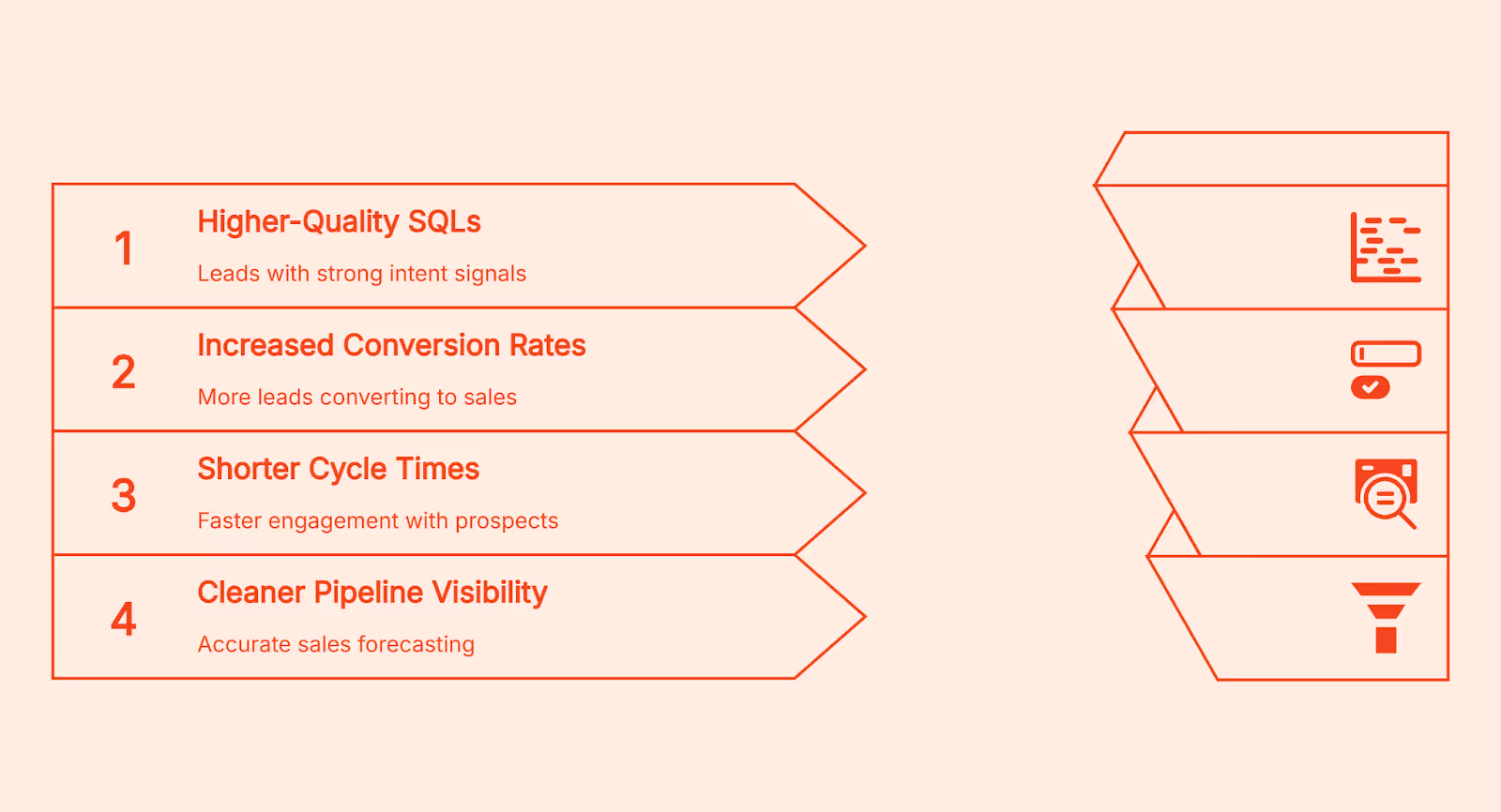
A mismanaged funnel has the opposite effect: bloated pipelines filled with weak opportunities, wasted SDR time, and frustrated marketers.
Common pitfalls to watch out for
- Pushing leads to sales before they show real buying intent.
- Setting criteria so strict that promising leads never make it through.
- Working in silos without feedback or shared context.
- Ignoring sales feedback when refining qualification models.
- Relying on a static scoring model instead of adapting over time.
Here’s how proper qualification improves marketing ROI
Marketing budgets are finite. If a team optimizes campaigns purely for lead volume without considering quality, ROI plummets.
By distinguishing SQL vs MQL, marketing can:
- Identify which campaigns generate leads that actually convert into SQLs.
- Shift spend toward high-quality channels (for example, G2 or high-intent search) instead of vanity metrics (e.g., low-cost leads from broad awareness ads).
- Prove contribution to pipeline in terms of SQL creation, not just MQL volume.
This closes the loop on SQL marketing impact: marketing doesn’t just generate interest. Having clear thresholds avoids the guesswork it directly fuels revenue by creating SQLs.
And when it comes to measuring which channels actually contribute to that growth, accurate attribution becomes essential. The Factors B2B Marketing Attribution Guide highlights the biggest challenges companies face and how multi-touch attribution connects every click to revenue.
Aligning marketing and sales for a seamless handoff
A classic failure point in many organizations is the ‘throw it over the wall’ mentality: marketing generates leads, hands them to sales, and hopes for the best.
Even the most sophisticated lead qualification process can fall apart if marketing and sales aren’t on the same page. It’s not enough to define MQLs and SQLs, both teams need to collaborate continuously to ensure every handoff is timely, relevant, and acted on.
How to strengthen marketing and sales collaboration
- Evolve shared definitions: Go beyond just agreeing on MQL and SQL criteria once revisit and refine them regularly as buyer behavior and ICP insights evolve.
- Turn communication into a system: Don’t limit alignment to monthly syncs. Set up recurring lead review sessions where both teams analyze what’s working, what’s not, and how scoring can improve.
- Recycle rejected leads effectively: Not every SQL will convert immediately. Instead of dropping them, feed them back into marketing workflows for continued nurturing.
- Build joint dashboards and KPIs: Move past vanity metrics. Create shared views of conversion rates, velocity, and pipeline impact so both teams measure success on the same terms.
Strategic recommendations for aligning marketing and sales efforts
- Define thresholds clearly. Document exactly what makes a lead an MQL vs SQL.
- Automate handoffs. Use CRM workflows and real-time alerts so no SQL falls through the cracks.
- Enforce SLAs. Sales must act on SQLs quickly; marketing must deliver only leads that meet criteria.
- Measure success across stages. Track MQL→SQL conversion rates, SQL→Opportunity rates, and ROI from each campaign.
- Create a feedback loop. Sales shares qualitative input on SQL quality; marketing refines scoring models based on that data.
Look, marketing and sales alignment isn’t a one-time fix; it’s a discipline. But with the right frameworks and the right platform, it becomes easier, faster, and far more scalable.
Best practices for managing MQLs and SQLs effectively
Knowing the difference between MQL vs SQL is only half the battle.
The real growth comes from how you manage these leads, how you define them, nurture them, transition them, and continuously refine the process.
Let’s break down the best practices that top-performing teams use to maximize lead conversion.
- Develop clear qualification criteria and scoring models
The foundation of effective lead qualification is a transparent, points-based scoring model.
- Fit (Firmographic/ICP criteria): Industry, company size, geography, tech stack.
- Intent (Behavioral criteria): Page visits, webinar attendance, content downloads, product trial activity.
- Recency: How recently those actions occurred (a demo request last week is stronger than one six months ago).
For example:
- A prospect from your ICP who attended a webinar (+20), downloaded an eBook (+10), and visited the pricing page twice (+30) might hit the 60-point threshold for MQL.
- Once they request a demo (+30) or actively engage with a rep (+20), they cross the 80-point threshold into SQL.
Having clear thresholds avoids the guesswork. Sales knows why a lead was passed over, and marketing knows what behaviors to prioritize.
Factors helps you visualize this transition through its Milestones feature, which offers funnel analytics that pinpoint what actions drive movement from MQL → SQL, so you can double down on what works.
- Implement lead-nurturing strategies for MQLs
MQLs and SQLs require different engagement strategies. An MQL should never be treated like an SQL; doing so risks scaring them away before they’re ready.
For MQLs:
- Content drip campaigns: Educational content → case studies → product comparisons.
- Retargeting ads: Serve content to high-fit accounts browsing your site but not converting.
- Personalized nurture: Use marketing automation to send emails aligned with their activity (e.g., “Since you downloaded our product guide, here’s a webinar you might like”).
The goal is to warm them until intent signals show they’re ready to progress.
- Transition leads from MQL to SQL: timing and communication
The handoff moment is where most companies lose momentum. Without speed and clarity, hot leads go cold.
Best practices include:
- Service Level Agreements (SLAs): Documented rules, e.g., Sales must engage an SQL within 24 hours.
- Automated alerts: Slack/MS Teams messages triggered when a lead reaches SQL status.
- CRM workflows: Automatically assign SQLs to the correct SDR, create tasks, and log activity.
Example: If a prospect hits the SQL threshold at 10 a.m. after browsing the pricing page, an SDR alert should fire instantly. Waiting until the weekly sync to act wastes the signal.
- Use CRM and marketing automation tools for seamless handoffs
Technology ensures consistency. Modern GTM stacks make SQL sales handoffs smooth and measurable.
- CRM systems (Salesforce, HubSpot): Track lead status changes from MQL → SQL → Opportunity.
- Marketing automation (Marketo, Pardot, HubSpot): Score and nurture MQLs until they’re ready.
- ABM/ad platforms: Sync high-intent MQL segments into LinkedIn or Google Ads for precision retargeting.
This integration ensures marketing and sales are never blind to each other’s activities. For example, SQL marketing teams can see which campaigns sourced SQLs, while sales can give feedback on which MQL signals actually led to opportunities.
- Continuously monitor and refine qualification processes
Lead qualification is not a “set it and forget it” system. Buyer behavior changes, markets shift, and what worked last quarter may not hold next year.
Best practices include:
- Weekly or bi-weekly MQL→SQL reviews: Marketing and sales analyze which signals worked and which didn’t.
- Adjust scoring weights: If trial usage proves more predictive than eBook downloads, increase its point value.
- Feedback loops: Sales shares qualitative feedback on why certain SQLs closed or stalled, informing marketing.
- KPI tracking: MQL→SQL conversion rate, SQL→Opportunity rate, average time-to-SQL, win rate by source.
Also read: KPIs Explained: Conversion Rates
Continuous refinement turns the MQL and SQL framework into a living system that evolves with your business.
Putting it together: Steps for predictable growth
Here’s what a streamlined MQL-to-SQL qualification process looks like from start to finish:
- Define MQL and SQL thresholds (with scoring tied to ICP + intent).
- Nurture MQLs with targeted content, ads, and automation.
- Trigger handoff automatically when SQL criteria are met.
- Enforce SLAs so sales acts quickly on SQLs.
- Review and refine scoring and signals every week.
The result? Sales spends time on the right accounts, marketing proves ROI beyond vanity metrics, and leadership gets a clean, predictable pipeline.
How Factors helps
Most teams struggle with the MQL→SQL handoff because marketing and sales speak different languages. Marketing tracks engagement; sales tracks intent. Somewhere in between, leads get lost. That’s where Factors brings everyone back on the same page.
Factors simplifies alignment by giving both teams a shared source of truth. Features like Milestones visually map the journey from MQL to SQL, showing exactly which actions or content drive progression between stages. With these funnel analytics, you can finally diagnose drop-offs, validate GTM experiments, and double down on what’s working.
Meanwhile, real-time AI Alerts notify sales reps the moment a lead crosses an intent threshold, like revisiting the pricing page or engaging with multiple assets. These alerts don’t just say who to reach out to, but why and how, surfacing rich account context for hyper-personalized follow-ups. It means your reps never miss a ready buyer, and marketing gets immediate feedback on what’s driving sales conversations.
To take it a step further, GTM Engineering combines AI Agents and execution services that turn intent into revenue. Agents automatically:
- Alert reps in real time when an account is ready to talk
- Pull detailed account research
- Identify and multi-thread buying groups
- Revive closed-lost deals
- Track post-meeting engagement to guide next steps
This automation ensures every follow-up is timely, relevant, and backed by context.
Now, all this intelligence feeds into Factors’ Account 360, a unified view of every touchpoint, from ads and content engagement to sales outreach. It gives your GTM teams complete visibility into the buyer journey, so marketing knows which campaigns are driving SQLs, and sales knows exactly what the account has seen, done, and responded to.
And with Dynamic Ad Activation, you can sync audiences to LinkedIn and Google Ads in real time, ensuring every campaign stays in sync with funnel progression. Run buyer-stage–specific campaigns, retarget high-intent accounts, and suppress low-quality leads, automatically.
Together, these features transform lead qualification from a guessing game into a repeatable, data-backed process. Forget disjointed dashboards or manual CSV uploads, and those alignment meetings that go in circles. (I can hear you breathe a sigh of relief!)
With Factors, alignment stops being a recurring pain point and becomes a revenue-driving habit, powered by shared visibility, smart automation, and AI that connects intent to action.
Future trends in lead qualification and sales enablement
Lead qualification is evolving quickly. The truth is, the way we qualify leads today might look completely different in just a couple of years and that’s not a bad thing. Here’s a glimpse of what that future is starting to look like:
- AI-driven scoring: Machine learning models now combine behavioral, firmographic, and product usage fdata to predict intent with far greater accuracy.
- Real-time intent data: Integration of external signals like review site activity, funding data, or hiring patterns into lead scoring.
- Deeper ad platform integrations: Expect SQL marketing workflows that sync high-intent accounts into ad campaigns in near real time.
- AI assistants in sales: SDRs increasingly rely on AI agents that not only identify high-intent accounts but also surface the right contacts and generate personalized outreach insights.
In a nutshell…
The MQL vs SQL debate determines how effectively your revenue engine runs. MQLs represent early interest and the potential for future opportunities. SQLs, on the other hand, represent immediate buying intent and the chance to close deals quickly.
MQLs and SQLs are not interchangeable. Confusing them leads to wasted resources, missed opportunities, and frustrated teams. Clear definitions and scoring rules ensure that marketing fuels pipeline with quality leads and sales engages only when prospects are ready. The SQL meaning marketing teams rely on must tie directly to measurable business outcomes like conversion rates, pipeline growth, and ROI.
Both are essential, but they require different playbooks, timelines, and ownership.
FAQs for MQL vs SQL
Q1: What is the main difference between MQL and SQL?
A: An MQL is a lead who has shown interest through marketing activity but isn’t ready for sales yet. An SQL has demonstrated clear buying intent and is ready for direct sales engagement.
Q2: Why is it important to distinguish between MQLs and SQLs?
A: Mixing the two wastes time and resources. The distinction ensures that marketing focuses on nurturing and sales focuses on closing, improving overall pipeline efficiency.
Q3: What does SQL mean in marketing?
A: In marketing, an SQL is a lead that has passed qualification criteria, showing intent signals like demo requests or pricing inquiries, and is ready for sales outreach.
Q4: How do you convert MQLs into SQLs?
A: Through lead nurturing, emails, ads, content, and retargeting, until the lead crosses defined scoring thresholds (e.g., demo requests, pricing page visits).
Q5: What KPIs should businesses track for MQLs and SQLs?
A: MQL→SQL conversion rate, SQL→Opportunity conversion rate, average time-to-SQL, pipeline sourced by SQLs, and win rate by origin channel.
Q6: Can a lead skip MQL and go directly to SQL?
A: Yes. If a prospect shows strong buying intent from the start like requesting a demo or contacting sales they can skip the MQL stage and become an SQL immediately.
Q7: How many MQLs convert to SQLs?
A: There isn’t a universal benchmark as it varies by product, ICP, lead source, and how you define each stage. The most useful benchmark is your own: track MQL→SQL by channel/segment over a consistent window (e.g., last 90 days) and improve it by tuning fit criteria, scoring, SLAs, and nurture..
Q8: What SQL means in marketing?
A: It refers to a lead that’s shown clear buying intent and is ready for direct sales engagement, usually after taking actions like requesting pricing or booking a demo.
Q9: What’s the difference between “SQL sales” and “SQL marketing”?
A: “SQL marketing” is how marketing identifies a lead as sales-ready. “SQL sales” is how the sales team qualifies and engages that lead to move it into an opportunity.
Q10: Do all SQLs become customers?
A: No. Some SQLs don’t convert due to factors like timing, budget, or competition, but strong qualification increases the chances they will.
Related Reads from Factors
If you’re looking to improve how your team defines, qualifies, and moves leads from MQL to SQL, these reads can help you sharpen the foundation:
- How To Build Your Ideal Customer Profile In 15 Steps – A practical guide to defining your ICP so your MQLs and SQLs are more targeted, qualified, and conversion-ready.
- How To Leverage Signals For Account Scoring – Learn how to use intent and engagement signals to fine-tune lead scoring models that bridge the MQL→SQL gap.
- An Introduction To B2B Account Scoring - Understand the basics of account-level scoring to ensure sales teams focus on the highest-potential opportunities first.
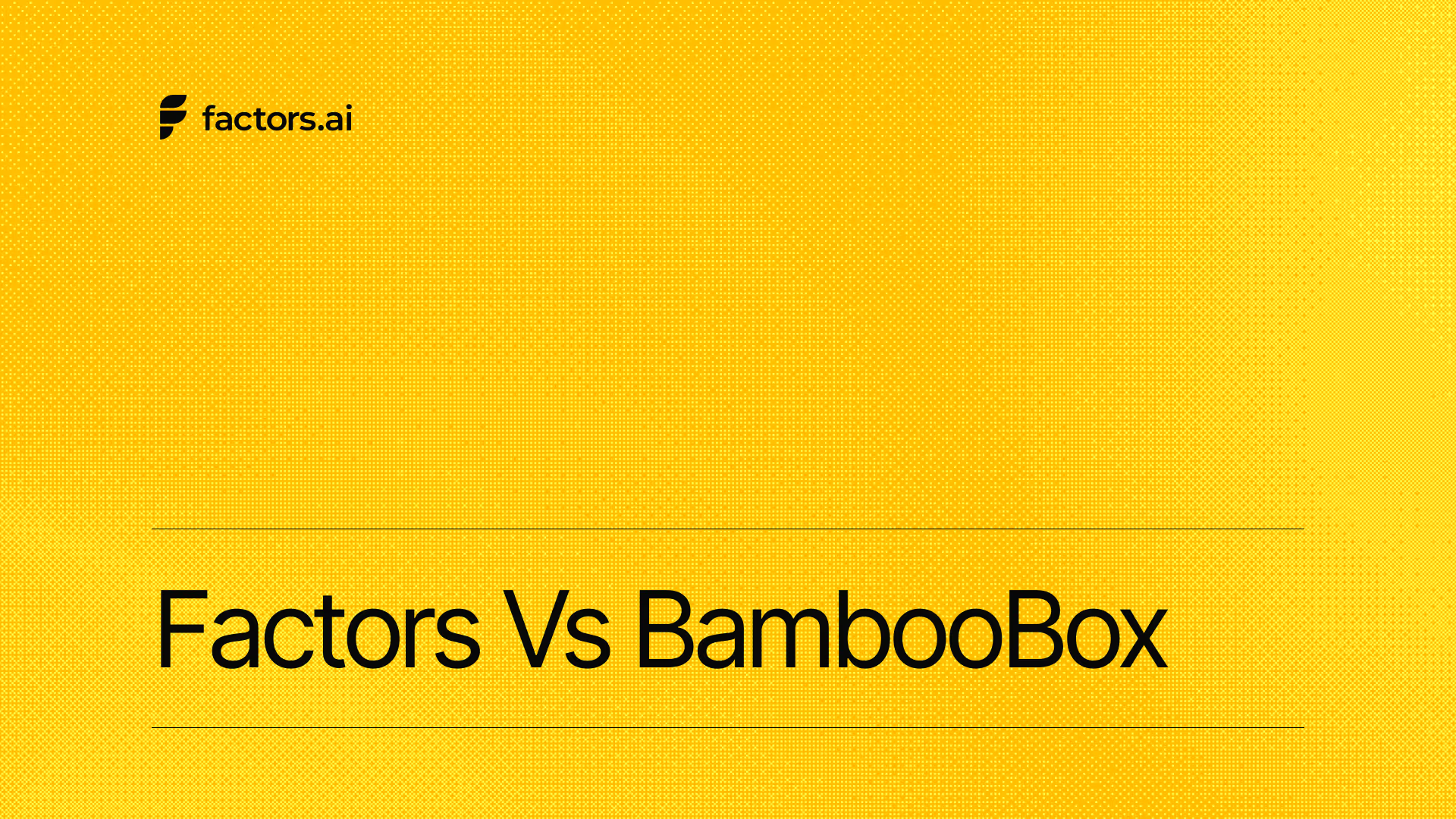
Factors vs BambooBox: Which alternative is best for B2B teams?
ABM platforms can look the same from the outside, kind of like shampoo bottles in the supermarket. The label says ‘strengthens and smooths,’ but one leaves you shiny, the other leaves you tangled.
And look, if you’re here, you already know what ABM should look like: less guesswork, more qualified pipeline, and campaigns that reach the right accounts before the RFP goes live.
What’s harder is deciding which platform can take you there without duct-taping tools, chasing down sales reps for follow-ups, or losing budget visibility once ads go live. Basically, what will leave you with strong and shiny results.
This guide breaks down Factors vs BambooBox across the parameters that matter.
Each chapter compares the platforms, from identification and orchestration to ad activation and attribution, so your decision isn’t based on “who says what on LinkedIn” but on what moves your revenue motion forward, right now.
If you’re evaluating ABM tools with real budget and bandwidth on the line, you’ll want the full view. Let’s get into it.
Factors vs BambooBox: Features and Functionality
Choose the platform that helps your team
(a) See more of the right accounts,
(b) Move from signal to action without spreadsheet gymnastics, and (c) arm sellers with the context to start better conversations.
Below is a clear, parameter-by-parameter view of how Factors and BambooBox handle identification, intent, orchestration, seller enablement, analytics, and ads.
Factors Features and Functionality
- Identification & Intent
- Visitor Identification: Identify up to 75% of anonymous visitors with sequential enrichment across 6sense, Clearbit, and Demandbase (plus additional providers when available). Once an account is identified, user geo-location and job title triangulation can likely pinpoint more than 30% of the individual visitors.
- Custom Intent Models: Blend website activity, CRM stages, product usage, ad clicks, and G2 intent to create precise buying-intent models that refresh continuously.
- Orchestration & Workflows
- Automated Workflows: Push qualified signals straight to Slack/MS Teams, your CRM, ad audiences, and outreach tools—no manual list building.
- AI Aler ts: Real-time, high-context notifications for events like form-fill drop-offs, demo/pricing page revisits, and post-meeting browsing.
- Seller Intelligence & GTM Services
- AI Agents: Find the best contacts, score them, and auto-generate sales-ready talking points and next steps.
- GTM Engineering (optional): Get hands-on help setting up agents and workflows that turn buyer signals into meetings, think real-time routing, closed-lost reactivation, and post-meeting engagement tracking.
- Scoring, Buying Groups & Multi-threading
- Account & Contact Scoring: Prioritize by ICP fit, funnel stage, and intent intensity.
- Multi-threading & Buying Group Identification: Spotlight decision-makers and influencers to reduce single-threaded risk.
- Journeys, Analytics & Milestones
- Customer Journey Timelines: A chronological log of every action across web, ads, product, and CRM to plan smarter, data-backed outreach.
- Milestones: Funnel-stage analytics that reveal which content, actions, and campaigns move accounts from MQL → SQL → opportunity.
- Unified Views & Collaboration
- Account 360: One sortable view of every touch—ad impressions, content engagement, sales outreach, product signals—so reps and marketers work from the same reality.
- Slack/MS Teams Alerts: Instant notifications to the right owner when high-intent activity happens.
Ad Activation & Feedback Loops
- LinkedIn AdPilot
LinkedIn AdPilot helps B2B marketers skip the guesswork and run efficient, high-converting ads, built on real buyer intent. It connects your CRM, website, and ad data to help you target smarter, spend wiser, and prove real ROI.
Key features:
- Audience Sync: Build and auto-update LinkedIn audiences using ICP-fit and intent data. Say goodbye to manual CSV uploads.
- Smart Reach: Prevent ad budget skew by controlling impressions per account, reach more of your target list without overserving a few big names.
- True ROI: Go beyond clicks to measure how LinkedIn ads actually influence pipeline, demos, and deal closures.
- LinkedIn CAPI: Sync online and offline conversions directly to LinkedIn to train its algorithm with richer, privacy-safe data.
- Company Intelligence: See which accounts viewed or engaged with your ads, and how that engagement impacted other channels.
- Google AdPilot
Google AdPilot helps B2B marketers cut wasted spend and make Google Ads work like a revenue engine. It syncs ICP-fit audiences, feeds smarter conversion signals back to Google, and ties every click to pipeline impact — turning guesswork into measurable ROI.
Key features:
- Audience Sync: Auto-refreshes ICP-fit and intent-based audiences for precise targeting and smarter remarketing.
- Conversion Feedback: Sends weighted conversion values through Google CAPI so the algorithm learns what high-value leads look like.
- Multi-Touch Tracking: Captures every GCLID across decision-makers for 3× better optimization feedback.
- Analytics: See which accounts engage, what they search for, and how ads influence pipeline, all in one dashboard.
Net effect: Factors moves your GTM motion from reactive to orchestrated, turning an unknown visit into a qualified meeting with fewer handoffs and no “who owns this?” confusion.
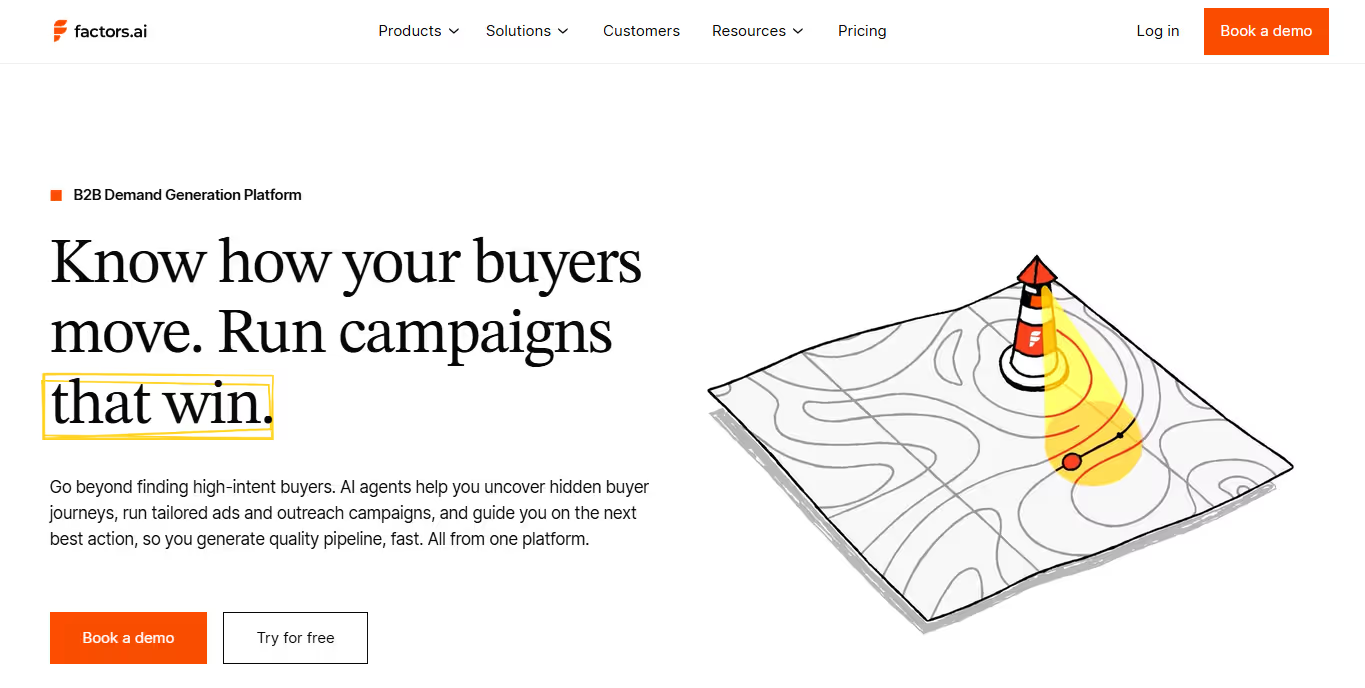
BambooBox Features and Functionality
- Identification & Intent
- Account Identification: Bamboobox enables the identification of visiting companies.
- Signal Coverage: Pulls first, second, and third-party data from website/CRM and major ad platforms.
- Orchestration & Sales Support
- Real-time Alerts: Slack/MS Teams alerting is not highlighted in public materials.
- Real-time Alerts: Slack/MS Teams alerting is not highlighted in public materials.
- Scoring, Buying Groups & Journeys
- Engagement Views: Account engagement and buyer-journey reporting.
- Buying Groups: Detailed buying-group mapping and contact tiering are not described.
- Ad Activation
- LinkedIn: Signal-based audience building with ad-view attribution to connect exposure to accounts.
- Google Ads: Targeted ABM features are slated to be released soon.
Integrations & Data
- Ecosystem: Connectors for HubSpot, Salesforce, Zoho, Salesloft, Marketo; media integrations for LinkedIn and Google.
- Unified View: A single, sortable account timeline across web, ads, product, and CRM is not specified.
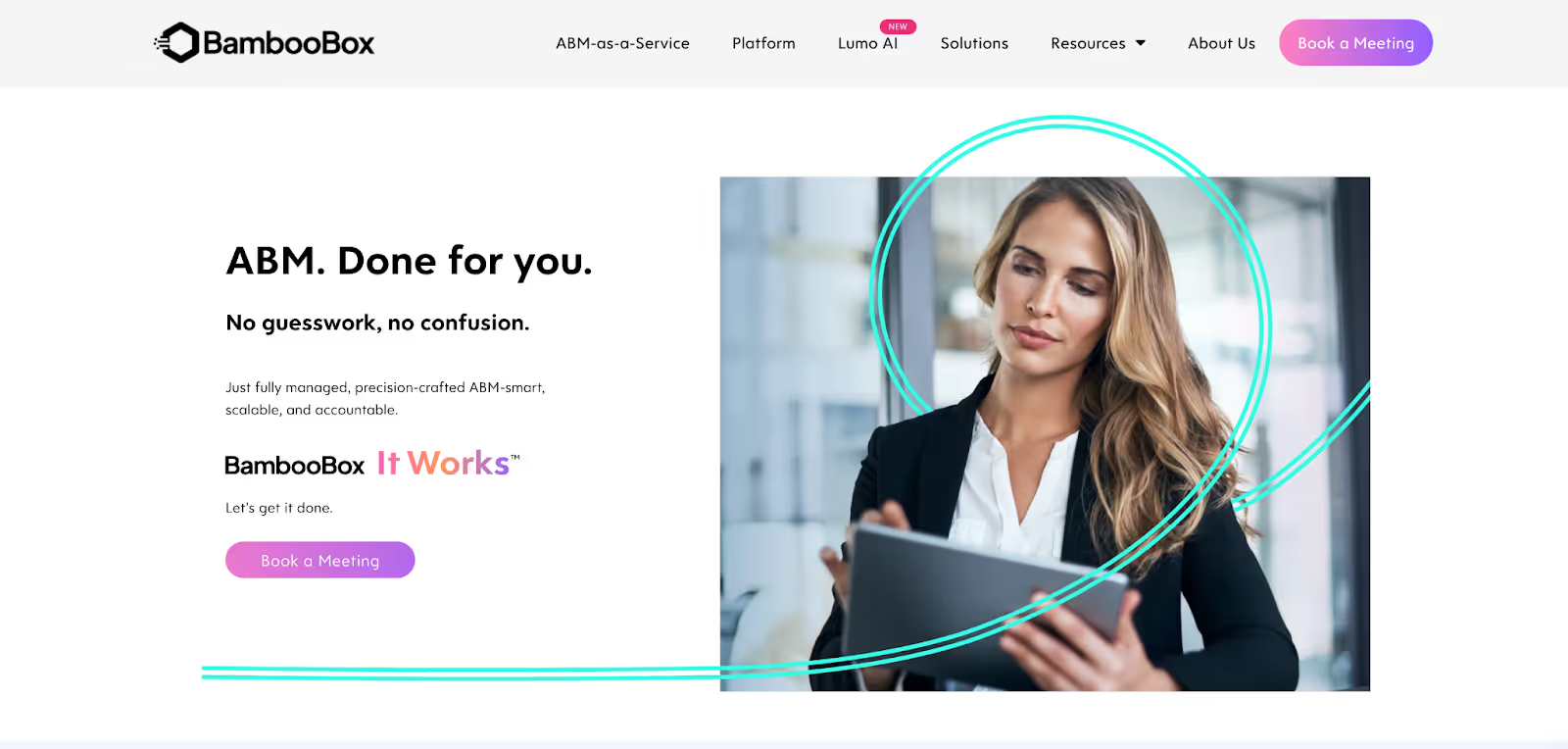
Factors vs BambooBox: Pricing
Pricing should be easy to forecast, scale with your usage and seats, and map cleanly to value, identified companies, activated audiences, and seller coverage. Here’s how both platforms approach it.
Factors Pricing
Free
- 200 companies identified/month
- Up to 3 seats
- Includes: company identification, customer journey timelines, starter dashboards, up to 5 segments, 20 custom reports, 1 month data retention
- Integrations: Slack, Microsoft Teams, website tracking
Basic
- 3,000 companies identified/month
- Up to 5 seats
- Includes Free, plus LinkedIn intent signals, CSV imports, advanced GTM dashboards, up to 10 segments, 50 custom reports, GTM workflows, email/helpdesk support
- Integrations: Ad platforms (Google, LinkedIn, Facebook, Bing), Google Search Console, HubSpot (contacts + deals), Salesforce (accounts + opportunities)
Growth (most popular)
- 8,000 companies identified/month
- Up to 10 seats
- Adds: ABM analytics, account scoring, LinkedIn attribution, G2 intent signals, workflow automations, 100 custom reports, dedicated CSM
- Integrations expand to: HubSpot (full), Salesforce (full), Marketo, G2, Drift
Enterprise
- Unlimited companies identified/month
- Up to 25 seats
- Adds: up to 50 segments, predictive account scoring, Google AdPilot (coming soon), LinkedIn AdPilot, journey milestones, white-glove onboarding, up to 300 custom reports
- Integrations expand to: Segment, RudderStack, and custom integrations
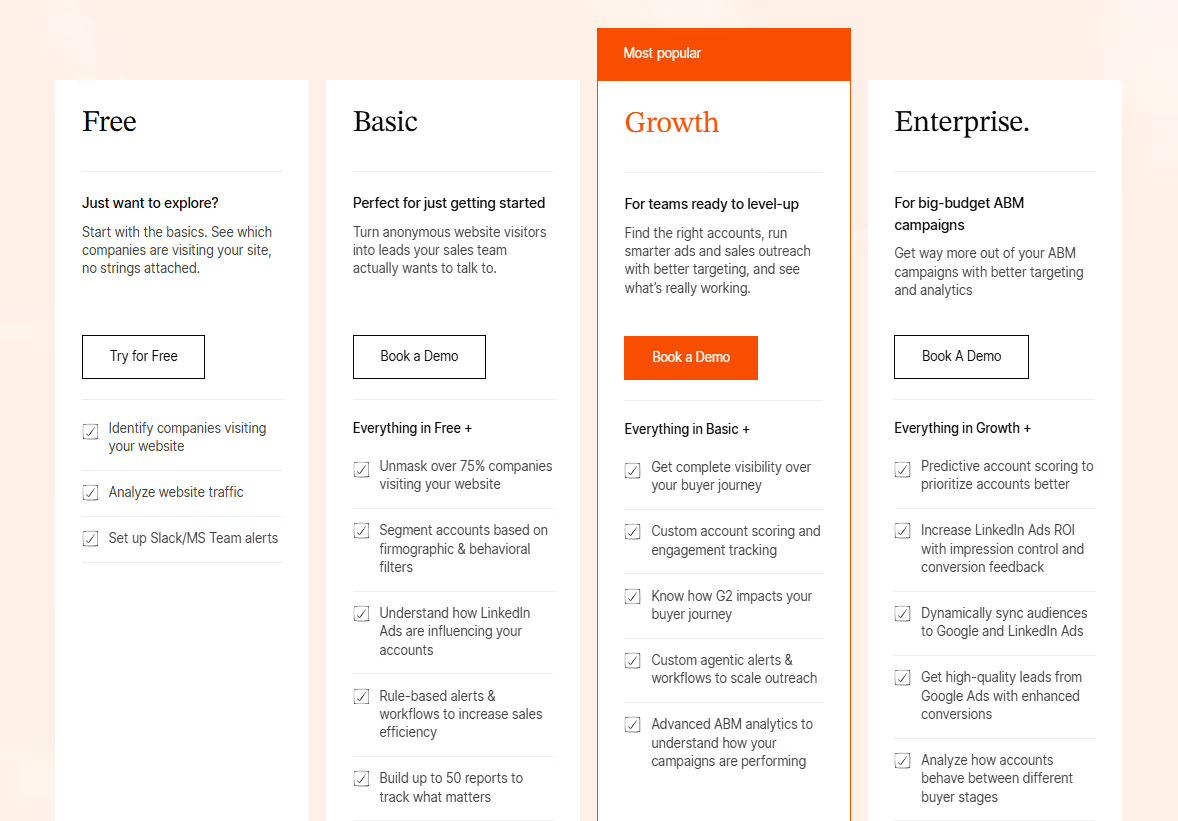
BambooBox Pricing
- Model: Quote-based pricing.
- Packaging: Aligned to ABM orchestration; specific caps (identified companies, seats, reports, segments) are not publicly listed.
- Budgeting note: Forecasting total cost typically requires a scoping call. Expect price to vary by traffic volume, users, integrations, and support level.

Factors vs BambooBox: Compliance & Security
You’re evaluating more than just features when you invest in platforms like Factors or BambooBox. You’re trusting a system with customer and go-to-market data. Look for proven audits and laws covered, transparent data handling, and admin controls that keep the right people in and everything else out.
Factors Compliance and Security
- Certifications, audits, and laws
- ISO 27001 certified information security program
- SOC 2 Type II attestation
- Alignment with GDPR and CCPA requirements, including a standard Data Processing Addendum on request
- Access and administration
- Role-based access control (RBAC) for marketing, sales, and admin roles
- Single Sign-On (SSO) options for enterprise teams
- Audit trails across key actions (segment changes, workflow edits, exports)
- Least-privilege defaults and periodic access reviews
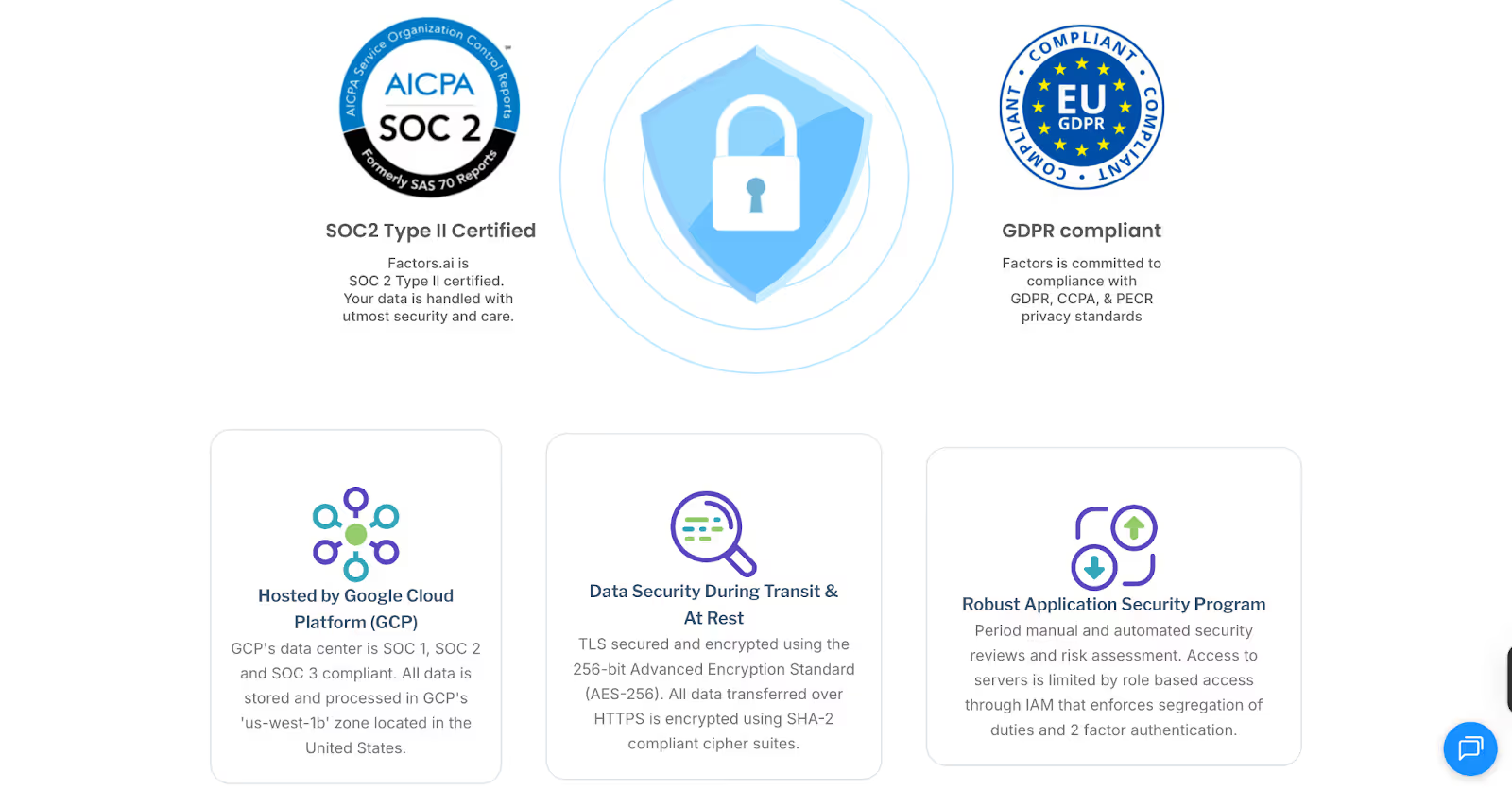
BambooBox Compliance and Security
Certifications, audits, and laws
- Public materials indicate GDPR alignment
- References to AICPA standards (typically the umbrella for SOC reports)
Data handling and governance
- Encryption expected in transit and at rest
- Data retention, subprocessor disclosures, and minimization settings are not publicly detailed
Access and administration
- RBAC and SSO are not publicly detailed
- Admin logs/audit trails are not specified in public materials
Customer commitments
- GDPR-aligned practices are indicated; scope and process specifics are not publicly detailed
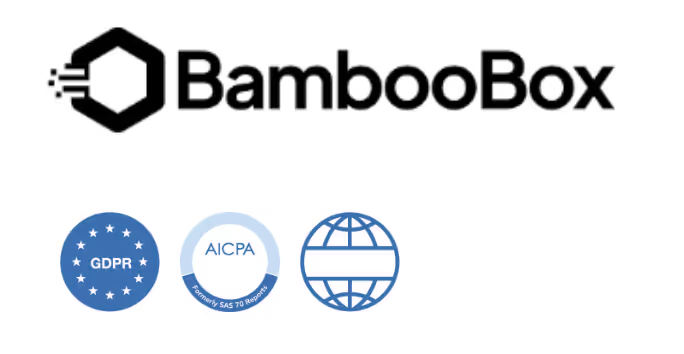
If you need to pass a vendor risk review quickly, Factors publishes more of the controls buyers ask for, audits, privacy coverage, admin guardrails, and documentation your security team can evaluate without guesswork.
Factors vs BambooBox: Onboarding and Support
You want fast lift without burning your RevOps time. Look for (a) who sets up the stack, (b) how your sellers get trained, and (c) what rhythm of check-ins keeps the system improving.
Factors Onboarding and Support
Onboarding program
- Data connections: guided setup for CRM/MAP (HubSpot, Salesforce, Marketo, etc.), ad platforms (LinkedIn, Google, Bing, Meta), G2 (if used), and data pipes (Segment/RudderStack on Enterprise).
- Tracking & enrichment: help installing website tracking and configuring multi-provider enrichment for higher match rates.
- Segmentation & scoring: ICP rules, buyer-stage segments, account/contact scoring, and buying-group settings.
- Workflows & alerts: Slack/MS Teams alerts for pricing page, form drop-offs, post-demo activity, geo-routing, and closed-lost reactivation.
- Ad activation: LinkedIn and Google audience syncs, stage-aware retargeting, frequency control, and suppression.
- Dashboards & milestones: ABM analytics, journey milestones, and “Account 360” timelines tailored to your funnel.
- Enablement: role-based training for SDRs/AEs/Marketing; office hours and recorded playbooks.
Support & success cadence
- Channels: shared Slack + email/helpdesk.
- People: a dedicated CSM from Growth tier upward, with weekly or bi-weekly reviews by plan.
- What gets reviewed: alert → meeting conversion, audience reach vs. impression skew, segment health, and pipeline attribution.
Optional GTM Engineering
- For teams that want hands-on lift, Factors can build and maintain agents, alerts, and playbooks (e.g., post-meeting tracking, no-show revival, geo-based owner routing), and tune ad activation. Useful when bandwidth is tight or you want Day-1 best practices.
BambooBox Onboarding and Support
Onboarding program
- Scope: connects CRM/MAP and ad platforms, sets up Bombora-based visitor ID, and enables buyer-journey views.
- Segmentation & scoring: engagement and journey reporting available; buying-group setup and contact tiering are not described in public materials.
- Ad activation: LinkedIn audience creation and ad-view attribution.
- Enablement: standard training and documentation are expected; public details are limited.
Support & success cadence
- Channels: their website mentions standard support; support tiers, CSM assignment, and review cadence aren’t publicly specified.
- Ongoing guidance: without published details, planning a recurring optimization rhythm typically requires scoping the program with their team.
Factors vs BambooBox: Analytics and Attribution
You need more than just good-looking graphs, right? Your analytics layer should answer three things:
- Which accounts are moving and why,
- Which channels and campaigns deserve more budget, and
- How activity turns into meetings, opportunities, and revenue.
Factors Analytics and Attribution
Funnel and stage analysis
- Milestones: Track movement from visitor → MQL → SQL → opportunity → closed, and see which pages, assets, and campaigns push accounts over each line.
- Stage conversion and velocity: Compare conversion rates and time-to-next-stage by segment (industry, company size, geo, tier).
Account-based attribution
- Account-level view: Roll up all people and touches for an account to show true impact on pipeline.
- Ad exposure + engagement: Tie LinkedIn ad views, clicks, and on-site behavior to the account’s journey; see pre-meeting influence, not just last-clicks.
- Assists and lift: Break out assisted impact so content and channels that warm accounts get credit.
Channel and campaign ROI
- Budget reallocation cues: Spot over-delivery to a handful of accounts and shift impressions or bids to under-reached yet high-fit segments.
- Segmented performance: Compare ROI by buying stage, industry, and intent level to decide where to double down.
- Report library: Build tailored views (lead source hygiene, stage-by-stage drop-off, paid social influence, search-to-social retargeting), with generous custom report limits by tier.
Journey timelines and diagnostics
- Customer Journey Timelines: A chronological view of ads, web, product, and sales touches, useful for win reviews and coaching.
- Drill-downs without exports: Click from a spike in a dashboard straight into the segment, accounts, and sessions behind it.
- Pathing: See typical sequences that lead to meetings or deals, then replicate those paths with audiences and alerts.

BambooBox Analytics and Attribution
Journey and engagement
- Buyer-journey reporting: View account engagement over time and track how audiences respond to programs.
- Ad connection: LinkedIn ad-view attribution links exposure to accounts to show whether target companies were reached.
Channel and attribution
- High-level reporting: Campaign and audience insights are available; detailed lift and assisted impact are not publicly documented.
Practical notes
- Teams often pair BambooBox journey reporting with separate BI or analytics tools to unpack assisted value, segment-level lift, and budget reallocation decisions.
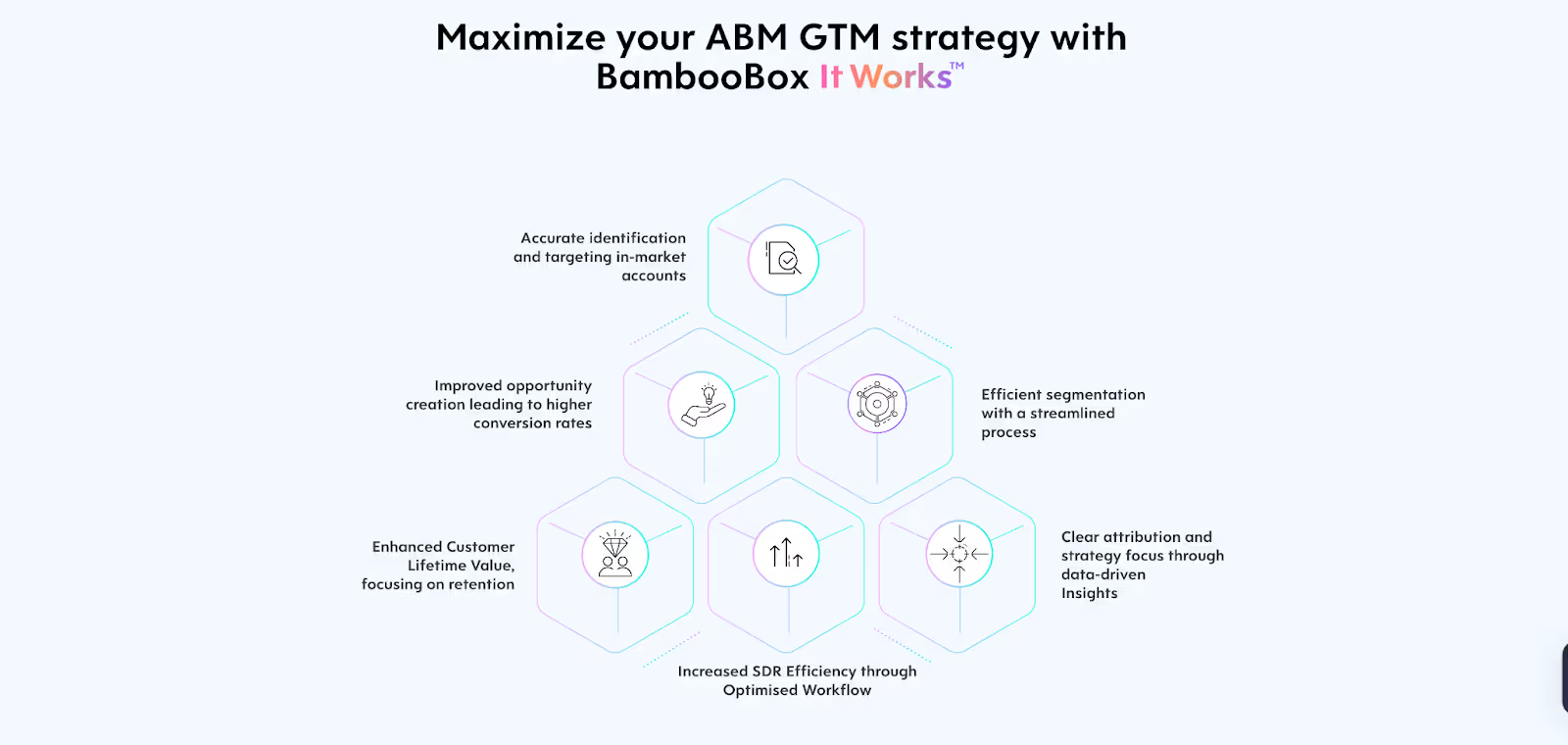
Factors vs BambooBox: Ad Activation and Retargeting
This is where signal turns into reach. You want audiences that refresh themselves, controls that stop waste, and feedback loops that teach the ad platforms who to find next. Below is how each product handles audience building, optimization, and measurement.
Factors Ad Activation and Retargeting
- Audience building & sync
- Dynamic Ad Activation: Build and auto-sync audiences to LinkedIn and Google Ads in real time based on ICP fit, intent intensity, buyer stage, recent pages viewed, campaign engagement, and CRM milestones.
- Google Audience Sync: Retarget high-fit accounts, suppress low-fit or active pipeline, and run stage-specific programs (e.g., post-demo nurture) with automated updates.
- Cross-channel retargeting: Create audiences on LinkedIn from search intent (keywords, pages, UTM patterns) captured on your site to follow up paid-search interest with targeted social.
- Optimization controls
- Frequency & impression pacing: Reduce skew by capping exposure per account and redistributing impressions to under-reached but qualified segments.
- Granular filters: Layer firmographics, geo, tech stack, intent score, and recency windows to keep budgets tight.
- Automatic suppression: Exclude current customers, open opps, and closed-lost with rules that update daily.
- Measurement & feedback loops
- LinkedIn attribution: See which accounts viewed, clicked, and later converted, then compare reach and cost by segment and stage.
- Google CAPI (server-side signals): Send richer conversion events back to Google, click-level details blended with firmographics and engagement scoring, to improve bidding and lower CPA over time.
- Journey lift: Tie ad exposure to milestone movement (e.g., MQL → SQL) so budget follows what actually progresses deals.
- Playbook examples
- Warm-up before SDR: If an account crosses a scoring threshold, add it to a low-frequency LinkedIn sequence for 7 days before sales touches.
- Post-meeting nurture: Auto-sync attendees + colleagues to a short, content-led sequence; suppress if they book a follow-up.
- Closed-lost revival: Re-add accounts when fresh intent reappears; cap frequency and stop as soon as sales re-engages.
- Search-to-social bridge: Anyone who hit solution pages from branded/non-branded search joins a LinkedIn audience mapped to that keyword theme.
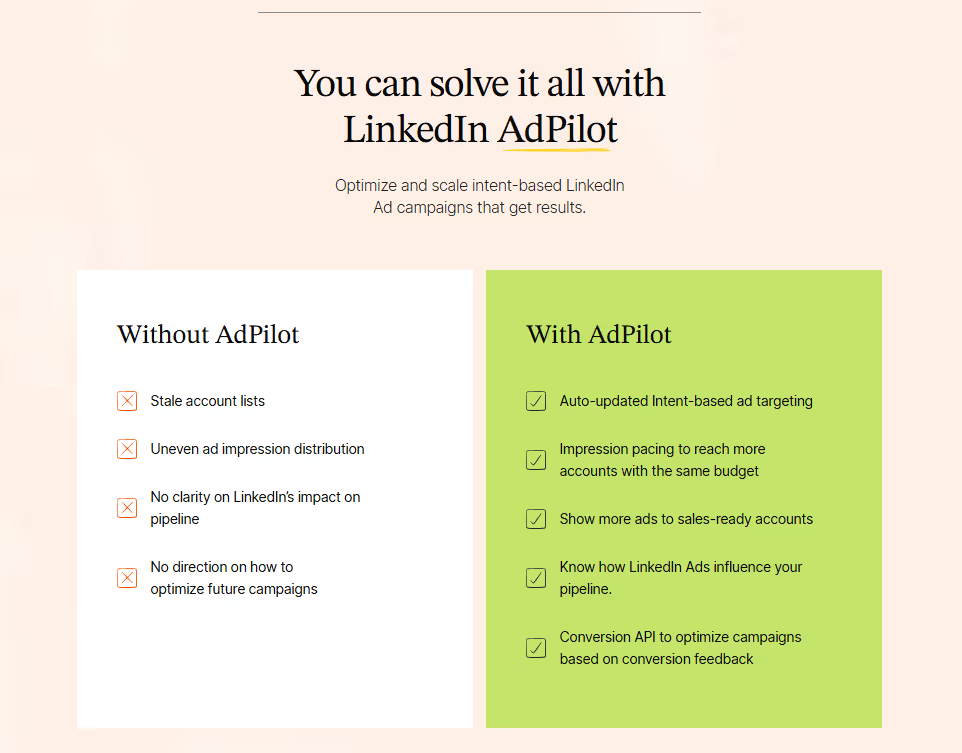
BambooBox Ad Activation and Retargeting
- Audience building & sync
- LinkedIn audiences: Build audiences based on account signals and target lists; the product supports ad-view attribution to confirm exposure among target companies.
- Optimization controls
- Suppression/frequency: Not widely detailed in public information.
- Measurement & feedback loops
- Ad-view attribution (LinkedIn): Connects account exposure to down-funnel engagement in the platform’s journey views.
- Search feedback loops: Not publicly detailed; Google-side optimization features are pending.
- Playbook examples
- Account list activation: Launch LinkedIn campaigns against strategic account lists and monitor exposure via ad-view attribution.
- Content follow-up: Use engagement signals to refresh audiences; deeper stage-based automations may require additional tooling.

Factors vs BambooBox: Which visitor tracking and GTM platform should you choose?
Both tools aim to turn buying signals into meetings and measurable revenue. Your pick should match how mature your GTM motion is today, and how quickly you want to scale identification, orchestration, and proof.
BambooBox
Pick BambooBox if you want a lighter ABM start with Bombora-based identification, G2 hooks, and LinkedIn audience building with ad-view attribution. It offers engagement and buyer-journey views and native AI email copy for personalization. Pricing is quote-based, and Google Ads ABM is marked as coming soon in public materials. If your team is early in ABM and primarily focused on LinkedIn activation, this can be a fit while you validate your motion.
What this feels like day-to-day: clear account lists to target on LinkedIn and high-level journey reporting; deeper sales alerting, buying-group mapping, and frequency controls may require extra tools or services.
Factors as a BambooBox Alternative
Choose Factors if you want one motion from coverage → activation → proof. It lifts account match rates with sequential enrichment, scores and routes accounts in real time, and gives sellers context through AI Agents and Account 360 timelines. Dynamic audience syncs to LinkedIn and Google keep budgets focused, while Milestones show which pages, ads, and touches push deals forward. Add GTM Engineering if you need hands-on setup and ongoing playbook tuning. The tiered, transparent pricing makes it easier to model payback against traffic and team size.
What this feels like day to day: fewer manual lists, faster hand-offs to the right rep, tighter ad targeting with less skew, and cleaner attribution when budget questions come up.
Ready to see how Factors turns signals into meetings?
If your team is juggling spreadsheets, stale audiences, or one-size-fits-all outreach, let’s fix that. Book a demo with Factors to see how you can:
- Identify up to 75% of high-fit visitors
- Sync real-time audiences to LinkedIn and Google
- Arm sellers with AI-powered contact picks and talking points
- Prove what’s actually moving deals, ad clicks, G2 views, or pricing page visits
Ditch the guesswork and endless list fatigue. And get faster handoffs and a cleaner pipeline.
FAQs for Factors vs Bamboobox
1. What’s the main difference between Factors and Bamboobox?
The key difference lies in depth and automation.
- Factors combines visitor identification, multi-source intent, CRM orchestration, ad activation, and analytics in one platform. It automates workflows and gives full-funnel visibility from first touch to closed deal.
- Bamboobox, on the other hand, focuses on early-stage ABM orchestration with Bombora-powered intent data and basic LinkedIn audience targeting.
If you’re running pilot ABM campaigns, Bamboobox is a good start. If you’re scaling pipeline and need precision, analytics, and automation, Factors fits better.
2. Which platform offers better visitor identification accuracy?
Factors identifies up to 75% of visiting accounts and can map 30% of person-level contacts through sequential enrichment using providers like 6sense, Clearbit, and Demandbase.
Bamboobox relies on Bombora for company-level identification, which is effective but less comprehensive for multi-source coverage and real-time enrichment.
3. How do Factors and Bamboobox handle ad activation and retargeting?
- Factors integrates directly with LinkedIn and Google Ads, syncing intent-based audiences in real time. It includes frequency control, suppression rules, and conversion feedback via Google CAPI and LinkedIn CAPI, helping teams optimize spend and track ROI at the account level.
- Bamboobox supports LinkedIn audience creation and ad-view attribution but does not yet offer Google Ads activation or advanced pacing controls.
4. Which tool offers stronger analytics and attribution capabilities?
Factors leads here with multi-touch attribution, funnel-stage analytics, and lift measurement. It connects ads, web, product, and CRM data to show how each touchpoint moves accounts toward revenue.
Bamboobox provides buyer-journey reporting and high-level campaign insights but doesn’t yet include assisted-impact analysis or stage-based ROI comparisons.
5. How do Factors and Bamboobox compare on pricing?
- Factors has transparent pricing starting at $399/month, with clear tiers (Free, Basic, Growth, Enterprise) and a 14-day trial. Each tier scales with identified accounts, users, and integrations.
- Bamboobox uses quote-based pricing, customized per client, with details not publicly available. Teams typically need a scoping call to estimate total cost.
6. Are Factors and Bamboobox compliant with data privacy and security standards?
Yes, both platforms follow major global standards, but the depth differs:
- Factors is SOC 2 Type II, ISO 27001, GDPR, and CCPA compliant, offering role-based access control, SSO, and detailed audit trails.
- Bamboobox lists ISO 27001 and GDPR alignment, but specifics on access control and audit reporting aren’t publicly documented.
7. How is onboarding and customer support different between the two?
- Factors offers white-glove onboarding, a dedicated CSM, shared Slack access, and ongoing reviews to optimize signals, audiences, and campaigns.
- Bamboobox provides standard onboarding, but details on support cadence, success reviews, or technical assistance aren’t publicly specified.
8. Which platform is better suited for scaling ABM programs?
If your goal is to scale ABM beyond pilot campaigns, Factors is the stronger choice. It unifies data across systems, automates sales and marketing handoffs, and provides actionable analytics for optimization.
Bamboobox works well for teams just starting out with LinkedIn-based ABM and looking for a simple orchestration layer.
9. Is Factors a good alternative to Bamboobox for enterprise teams?
Yes. Factors offers broader coverage, richer analytics, and deeper integrations across CRM, G2, LinkedIn, and Google Ads. It’s designed for mid-market and enterprise GTM teams that need predictable pricing, proven compliance, and measurable ROI.
.avif)
Factors vs HockeyStack: Which ABM platform wins?
Choosing the right intent data or ABM platform is never as straightforward as it seems. On the surface, tools often look alike: overlapping features, similar promises, familiar dashboards.
But if you’ve ever sat in a pipeline meeting, you know the real question is about momentum.
- How are the current channels contributing to lead generation?
- How seamlessly can they move from anonymous visitor to active opportunity?
- How confidently can they prove which efforts are driving the real pipeline?
That’s the lens through which we’ll look at HockeyStack and Factors. Two strong platforms, both aiming to give revenue teams more clarity and control. The details of how they help you get there, that’s where the difference reveals itself.
Factors vs HockeyStack: Features and Functionalities
When teams evaluate platforms like HockeyStack and Factors, the first question is always the same: Can this tool actually give me a complete picture of my accounts and how they buy? The strength of a GTM intelligence platform isn’t just about collecting data, but in how that data can be stitched together to tell a useful story.
Both HockeyStack and Factors deliver on the essentials: account identification, journey timelines, segmentation, and scoring, but the depth of what you can do with these capabilities is where things get interesting.
Factors Features and Functionalities
- Bundled account identification
No separate license needed, intent data is available out of the box. Makes it easier to get teams aligned without extra add-ons. - Richer data foundation
Goes beyond 1st and 3rd party signals by bringing in 2nd party data too. That additional layer means a fuller picture of the buying committee. - Advanced scoring with time-weighted signals
Allows you to not only score accounts, but weigh actions differently and define tiers (hot, warm, ice) across longer cycles, up to 180 days. Perfect for complex, enterprise sales where interest builds slowly. - Multi-touchpoint segmentation
Instead of just filtering based on actions, you can group accounts by the full range of interactions across channels. Makes it easier to answer questions like: “Which accounts engaged with both LinkedIn ads and webinar content before booking a demo?”
Why This Matters for Teams
- Marketing leaders can use these capabilities to understand which campaigns are shaping real opportunities, and prove it with journey timelines.
- SDRs and AEs can prioritize outreach based on weighted scores, so they don’t waste time chasing accounts that are cooling off.
- RevOps teams optimize spend and reallocate budget where intent is actually converting.
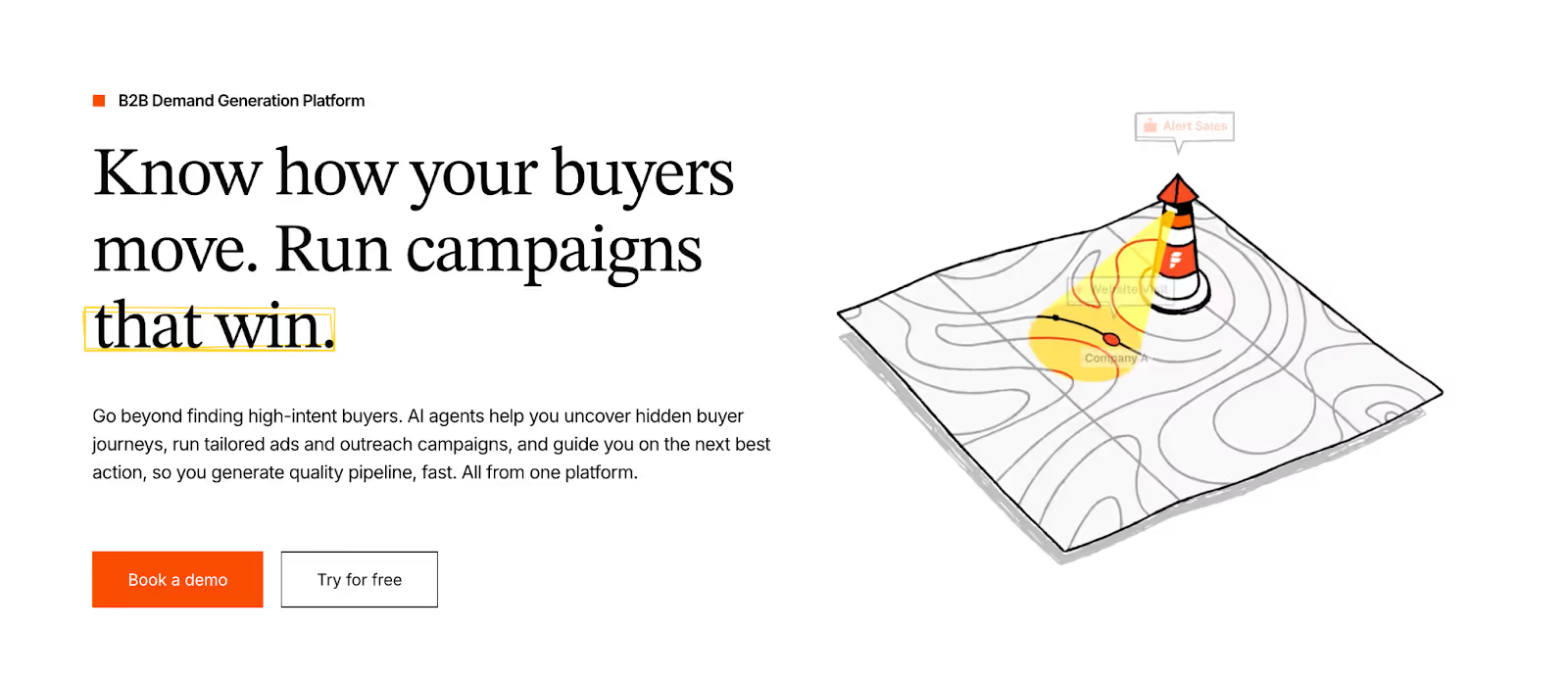
HockeyStack Features and Functionalities
- Account intelligence powered by 1st & 3rd party data
Gives GTM teams visibility into who’s engaging and from where. Great for building top-of-funnel awareness and spotting early intent. - Granular segmentation tools
Filters across dashboards, goals, and properties allow analysts to cut data in multiple ways. For a data-heavy team, this flexibility is powerful. - Custom scoring options
Lets you define what intent looks like by combining firmographic data with behavior signals. Ideal if you want a scoring model tailored to your ICP. - Journey timelines
Clear visual paths of how accounts interact across touchpoints. A good starting point for mapping patterns of buying behavior.
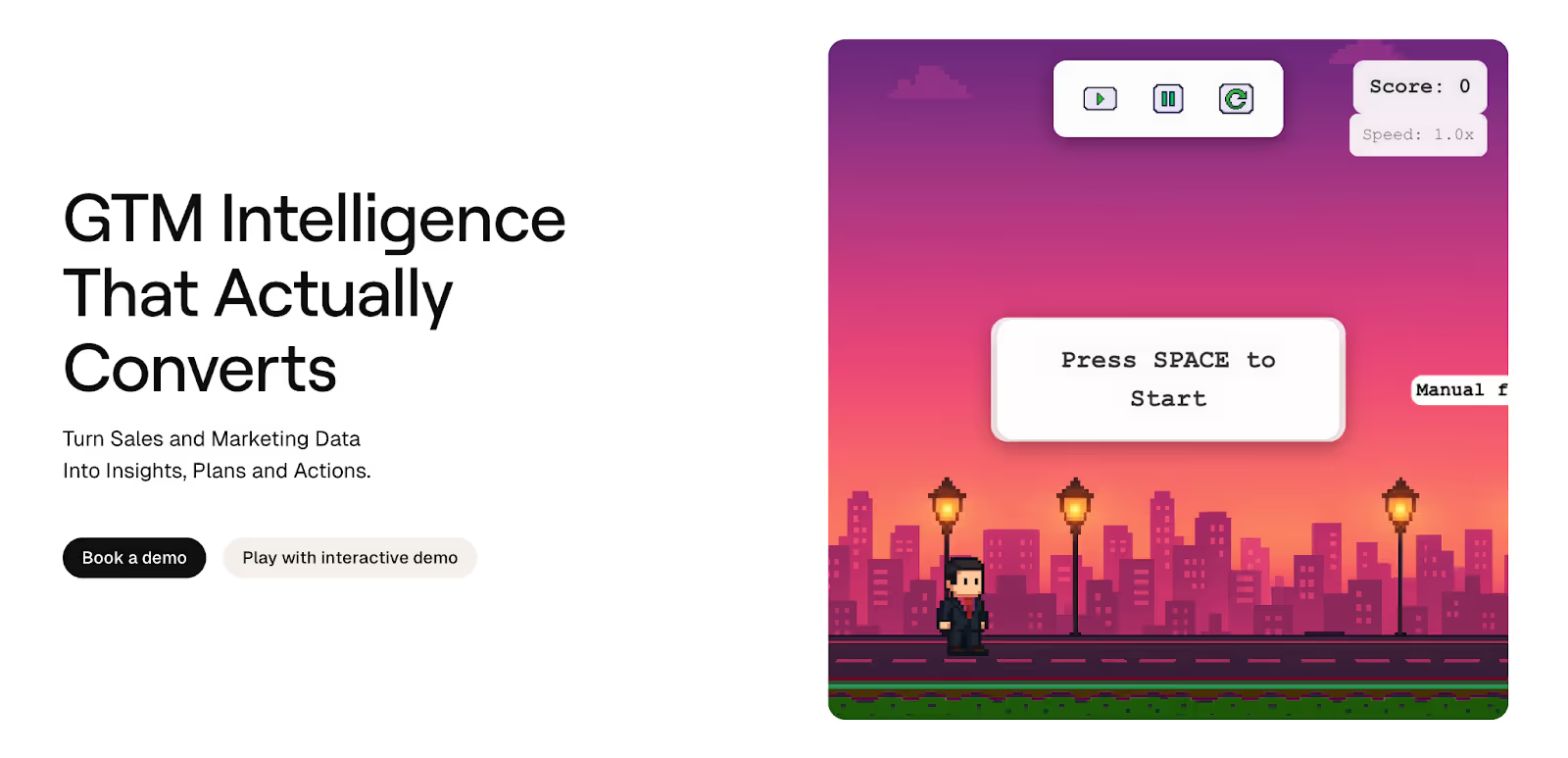
Factors vs HockeyStack: Pricing & Accessibility
Pricing is often one of the first things revenue teams evaluate when considering a GTM platform. Beyond cost, pricing structures reveal how well a tool scales with a team’s growth and usage needs. The right structure ensures that as your GTM operations expand, the platform continues to deliver value without creating friction.
Factors Pricing
Factors organizes its plans around usage, seats, and feature depth, letting teams start small and scale effectively:
- Free Plan
- Designed for exploration: start tracking which companies visit your website
- Analyze basic website traffic
- Set up Slack/MS Teams alerts
- Basic Plan
- Everything under Free, plus:
- Unmask over 75% of companies visiting your website
- Segment accounts using firmographic & behavioral filters
- Track how LinkedIn Ads influence accounts
- Rule-based alerts & workflows to improve sales efficiency
- Build up to 50 reports to monitor key metrics
- Sync data to your CRM
- Everything under Free, plus:
- Growth Plan
- Everything under Basic, plus:
- Complete visibility over the buyer journey
- Custom account scoring and engagement tracking
- Understand how G2 impacts the buyer journey
- Custom agentic alerts & workflows for scaled outreach
- Advanced ABM analytics to track campaign performance
- Everything under Basic, plus:
- Enterprise Plan
- Everything under Growth, plus:
- Predictive account scoring for prioritization
- Increase LinkedIn Ads ROI with impression control & conversion feedback
- Dynamically sync audiences to Google and LinkedIn Ads
- Get high-quality leads from Google Ads with enhanced conversions
- Analyze account behavior across different buyer stages
- Combine 1st, 2nd, and 3rd party data for richer intelligence
- Everything under Growth, plus:
This tiered setup allows teams to pick the plan that matches their current operations while keeping future scalability in mind.

HockeyStack Pricing
HockeyStack's pricing is more straightforward, but it lacks transparency in public disclosure. Based on G2:
- Starting price: ~$2,200/month
- No official breakdown of tiers, seats, or usage limits available on their website
While the starting price is visible, teams may need to contact HockeyStack for detailed quotes, making upfront budgeting less precise compared to Factors’s tiered, transparent model.
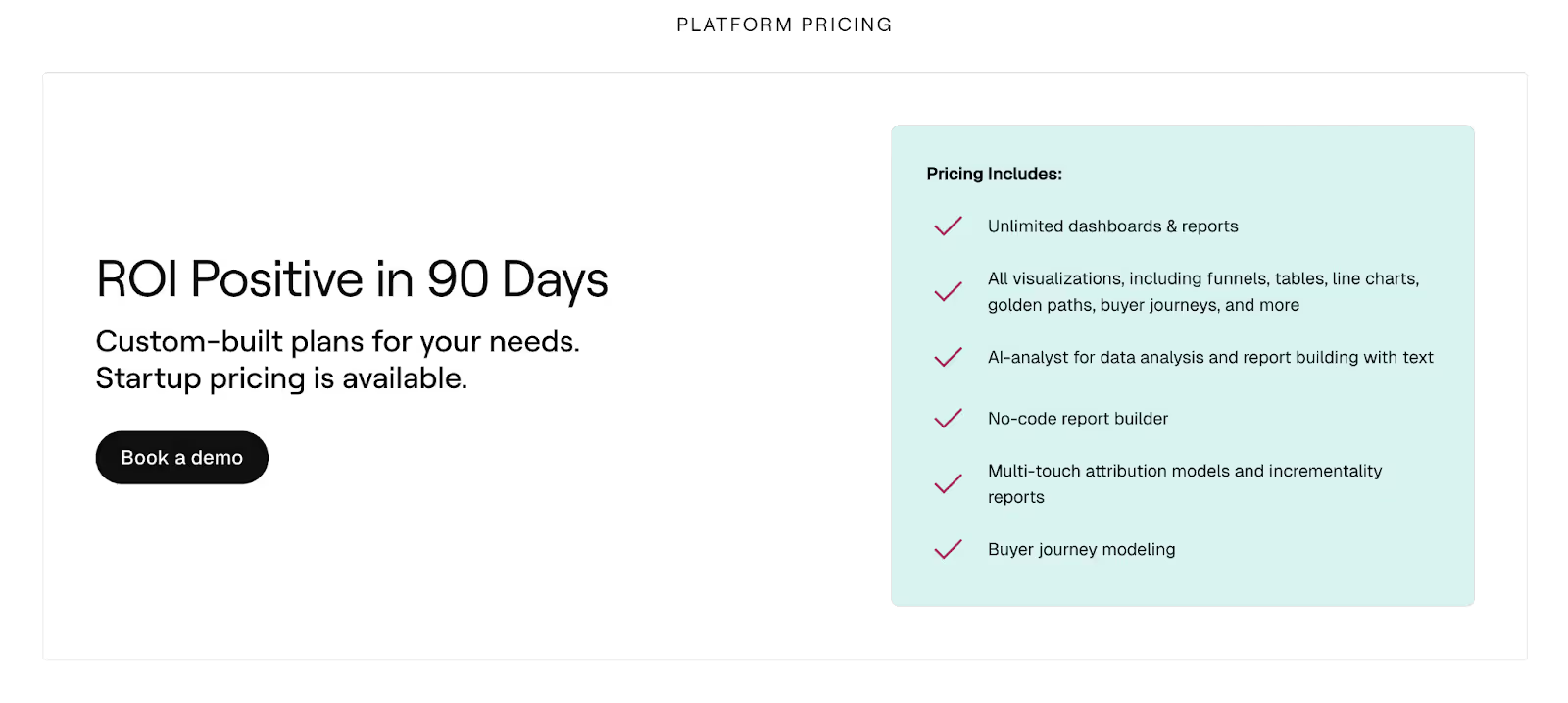
Key Takeaways
- Factors offers transparent, tiered pricing.
- HockeyStack has a clear starting cost, but limited publicly available detail makes future budgeting less predictable.
- Teams looking for scalable GTM features bundled with their plan may find Factors easier to plan around and grow with.
Factors vs HockeyStack: Analytics and Reporting
Revenue teams face a flood of data every day, but what really matters are the insights that guide action. Knowing which campaigns to invest in, spotting accounts that are ready to engage, and understanding where the pipeline is slipping through the cracks, these are the questions that drive results.
Both HockeyStack and Factors market themselves as highly customizable, but the way teams use those analytics is what makes the difference.
Factors Analytics and Reporting
- Completely customizable dashboards: Tailored to each team (demand gen, RevOps, sales), without feeling overly complex.
- Advanced segmentation: Goes beyond user-level to include account events, multi-touch journeys, and firmographics.
- Custom account scoring baked in: You’re not just reporting for the sake of it, you’re ranking accounts based on intent signals, CRM activity, and weighted scoring models (hot, warm, cold, etc).
- Multi-touch attribution made practical: Instead of just showing that ads or emails “influenced pipeline,” Factors can break down how much weight each touchpoint carried.
- Data retention & depth: Up to 180 days of signal history, giving marketers a longer look-back window to analyze nurture effectiveness.
Why This Matters for Teams
- RevOps can move from generic dashboards to actionable playbooks, e.g., “These 20 accounts just hit a hot score, route them to SDRs this week.”
- CMOs can defend budget allocation with segment-level comparisons: “Content syndication delivered twice the pipeline efficiency of paid search.”
- Sales leaders can view account timelines without needing an analyst to re-pull data weekly.
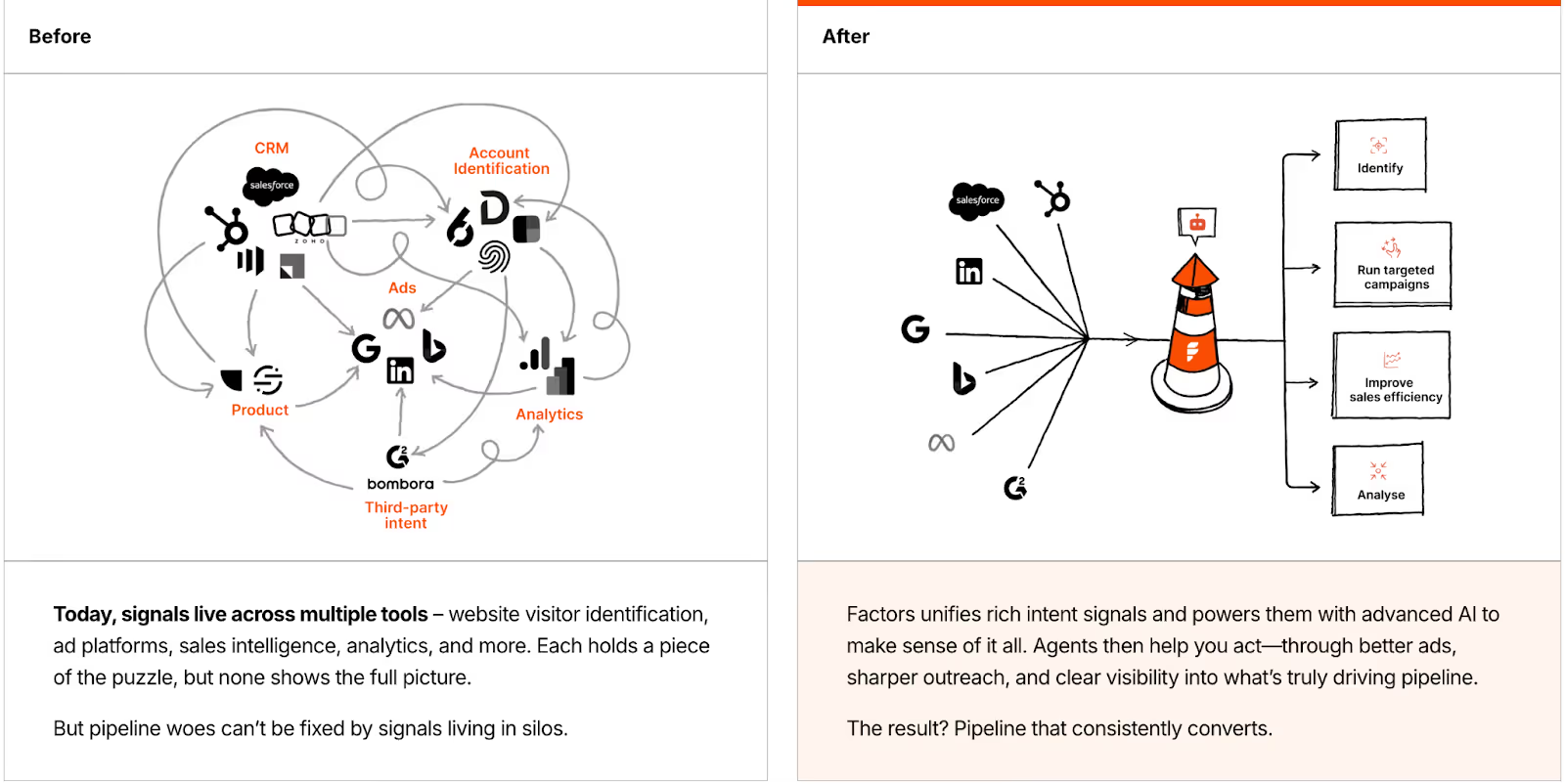
HockeyStack Analytics and Reporting
- Highly customizable views: Teams can configure dashboards and slice data however they like.
- Segmentation power: Multiple levels of filtering (global, column, breakdown, dashboard, and goal filters) allow deep dives into user actions and properties.
- Journey timelines: A visual way to see how accounts moved across touchpoints before reaching key milestones.
- ABM & funnel reporting: Useful for comparing channel and segment performance.
For data-savvy teams, HockeyStack analytics and reporting provides a wide canvas to work with. But this flexibility often means you need ops muscle to structure insights that are useful for sales and marketing leadership.
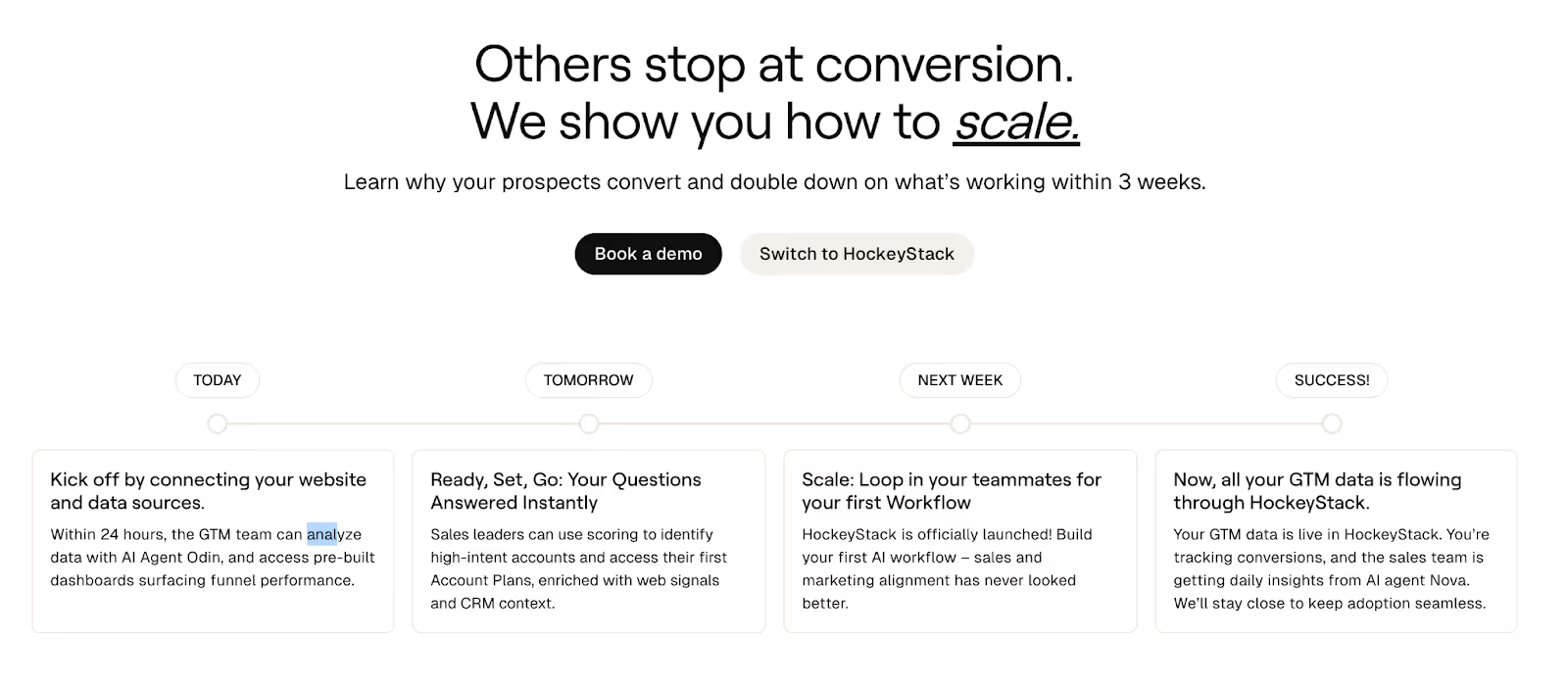
Factors vs HockeyStack: Workflows and Integrations
Dashboards and insights are only as good as the actions they drive. For GTM teams, that means one thing: the ability to operationalize insights inside the tools they already live in, Salesforce, HubSpot, Slack, LinkedIn, outreach platforms, and so on.
Both HockeyStack and Factors connect the dots here, but their approaches open up slightly different possibilities.
Factors Workflows and Integrations
- CRM contact and deal updates: Syncs with Salesforce and HubSpot just like HockeyStack.
- Built-in enrichment: Leverages Apollo to add context around accounts, so reps aren’t starting cold.
- Sales engagement integrations: Connects with HeyReach, SmartLead, and other outreach tools, moving beyond CRM into the sales execution layer.
- Custom workflows with webhooks: Teams can create automated triggers, e.g., “If an account score hits Hot, add them to a SmartLead sequence and notify the AE in Slack.”
- Multi-channel alerts: Notifications can go to Slack and Microsoft Teams, ensuring sales doesn’t miss signals.
Why This Matters for Teams
- Marketers can directly push audiences into ad platforms or nurture workflows instead of manually exporting CSVs.
- Sales teams get alerts where they already work (Slack, Teams) and can jump into action faster.
- RevOps gains the flexibility to stitch Factors into a broader stack without needing one-off connectors or custom dev time.
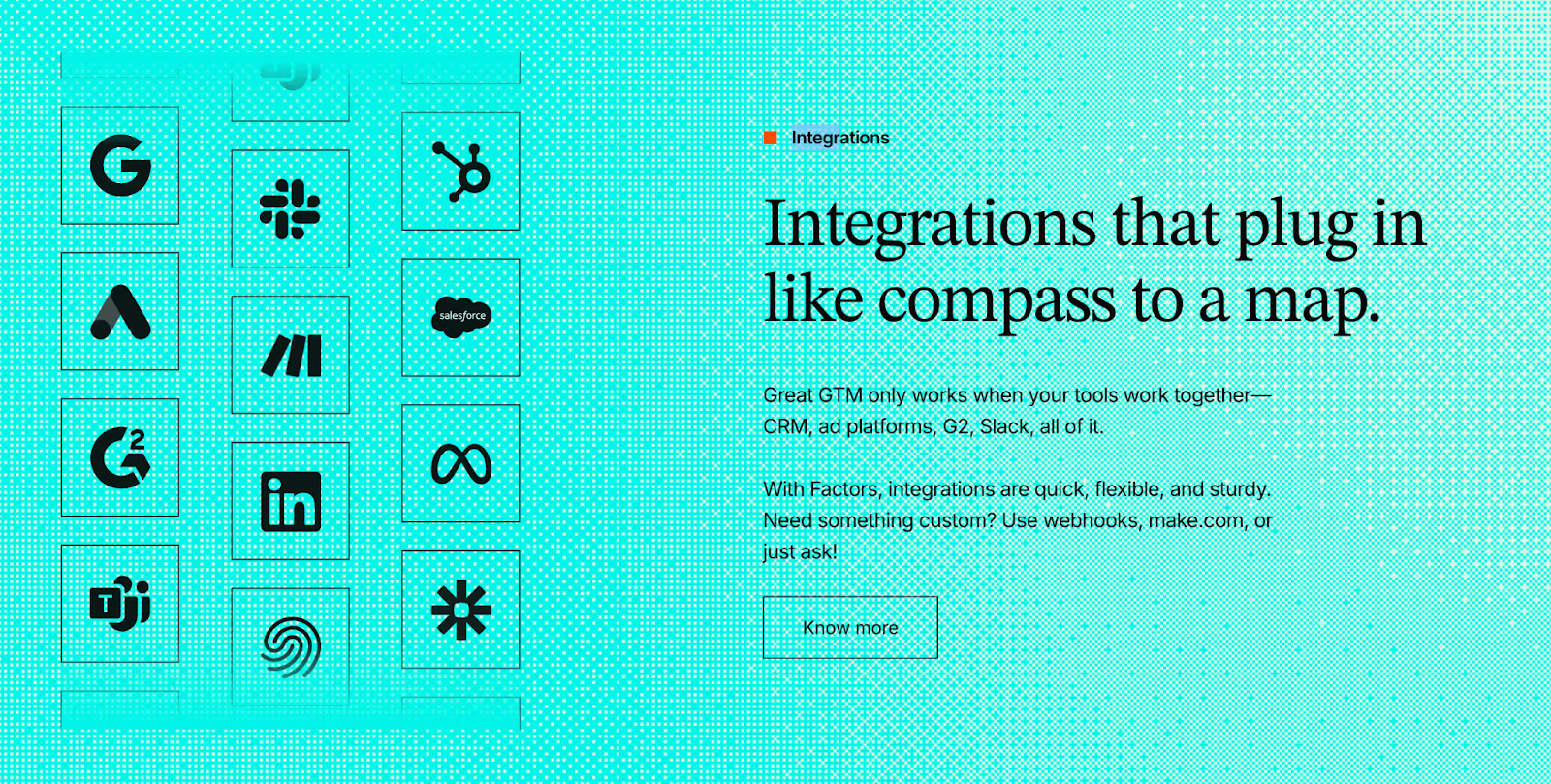
HockeyStack Workflows and Integrations
- CRM syncs: Updates contacts, companies, and deals directly inside HubSpot and Salesforce.
- Marketing automation hooks: Pulls form fills, campaign data, and meeting activity from HubSpot into reporting views.
- Sales data sync: Maps account, contact, lead, and deal objects to keep CRM clean and usable.
- Custom enrichment: Lets teams bring in firmographic and intent data for advanced segmentation.
For teams who rely heavily on Salesforce or HubSpot, HockeyStack does a solid job of bridging insights back into the CRM without requiring constant exports.
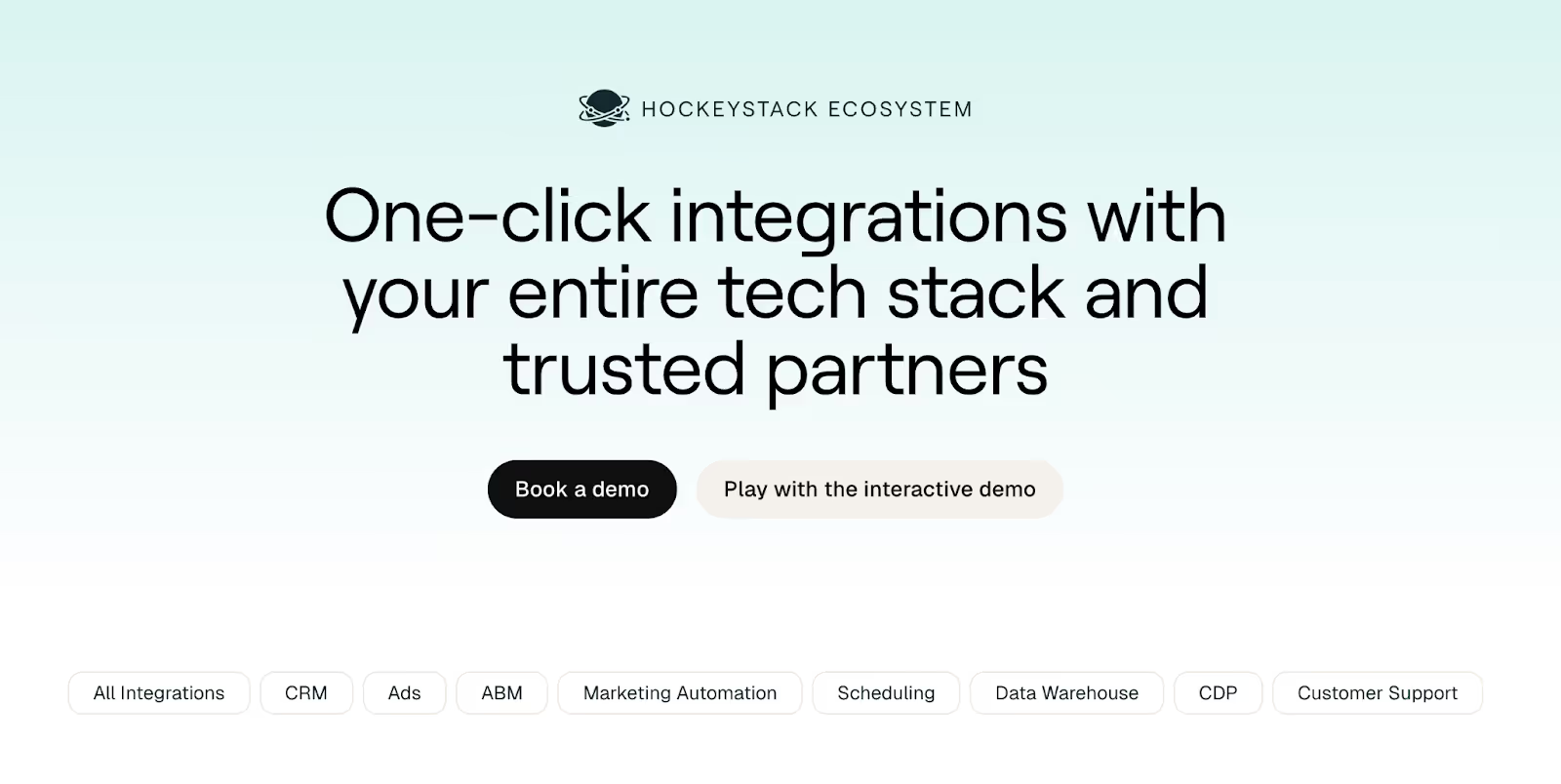
At this point, it’s clear: HockeyStack helps with CRM alignment, while Factors extends workflows into the broader GTM stack, including enrichment, outreach, and flexible automation.
Factors vs HockeyStack: AI & Automation
Every GTM team has more signals, more data, and more campaigns than they can realistically handle. That’s where AI enters: to actively help teams prioritize, plan, and execute. Both HockeyStack and Factors lean into AI, but the philosophy and scope of what you can automate are very different.
Factors’ AI & Automation
Where Factors pulls ahead is in pushing AI beyond analysis into execution. Its platform introduces AI Agents and GTM Engineering, programmable teammates that analyze signals and actively take action across the GTM motion.
Some real-world ways Factors’s AI helps teams:
- Account Research at Scale: Surfaces key contacts and buying group details automatically, instead of manual LinkedIn or Apollo searches.
- Signal-to-Action Routing: When a target account shows intent, an AI Agent enriches the data, scores it, and pushes it into outreach sequences via HeyReach or SmartLead.
- Custom Playbooks: Teams can build Agents to track specific conditions, e.g., “watch competitor-engaged accounts, pull key contacts, and send to SDR Slack channel.”
- Outreach Automation: Hot accounts can be auto-routed into cadences, ensuring no opportunity goes cold.
- Marketing Copilot (coming soon): A conversational assistant that answers questions like, “Which channels drove pipeline last quarter?” instantly.
GTM Engineering takes this even further by combining AI Agents with GTM services:
- AI-powered alerts notify reps in real-time when an account is ready to talk.
- They enrich buying groups and multi-thread deals automatically.
- They revive closed-lost opportunities and track post-meeting engagement to guide follow-ups.
Together, AI Agents and GTM Engineering position Factors not just as a co-pilot, but as an operator that actively drives deals forward.
Why This Matters for Teams
- Marketing teams save hours by letting AI handle enrichment, scoring, and activation, instead of manually curating lists or analyzing reports.
- Sales teams get proactive guidance on which accounts to chase and why, with timely nudges for outreach and follow-ups.
- Leadership gains visibility into which AI-driven activities are actually driving pipeline, without requiring analysts to crunch numbers every week.
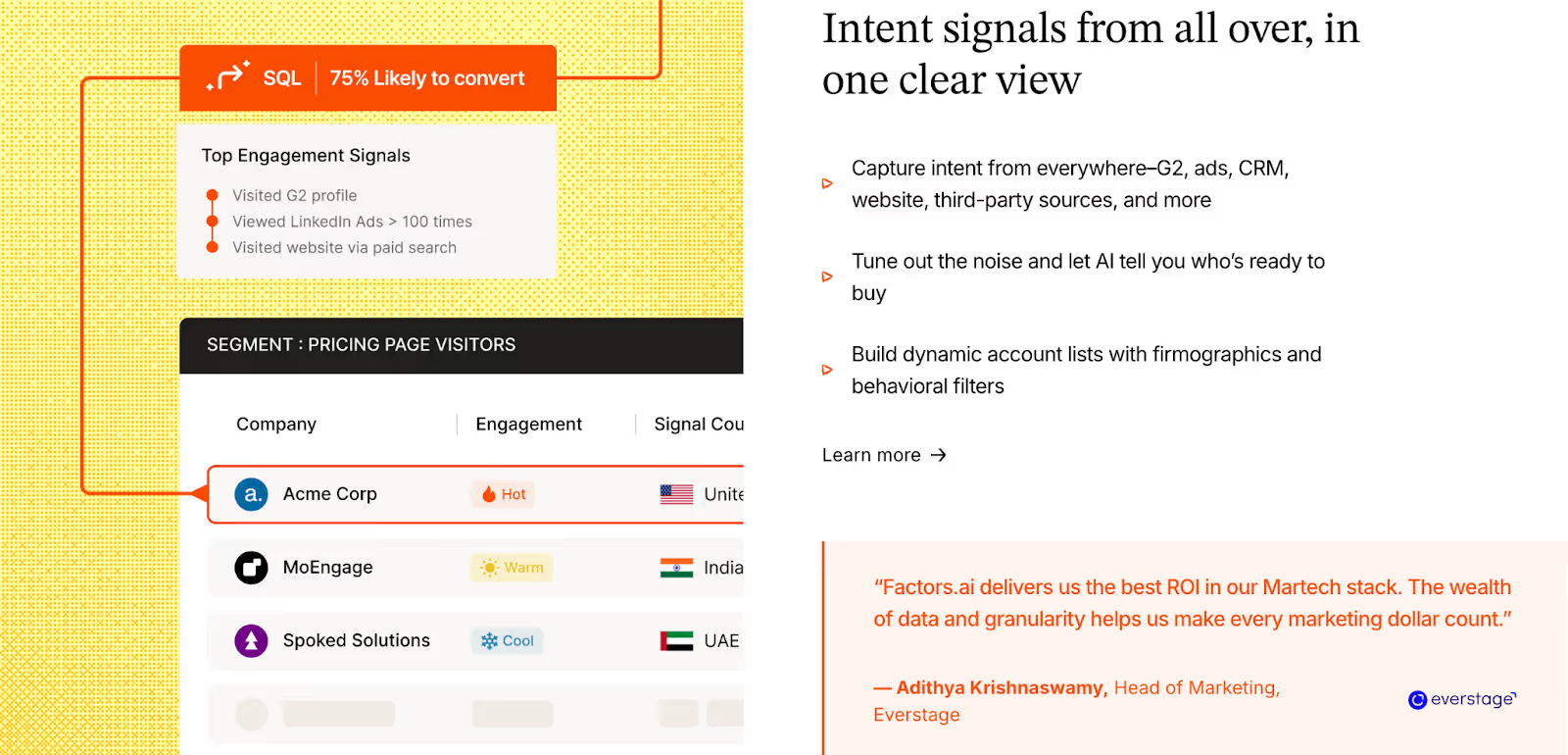
HockeyStack’s AI & Automation
HockeyStack introduces Odin, its AI analyst, designed to make insights faster and more accessible. Odin sits closer to the analysis layer, giving revenue teams quicker answers without needing to through dashboards.
Here’s how Odin helps:
- Campaign Diagnostics: Summarizes which channels are performing well and where conversions are lagging.
- Performance Recommendations: Offers suggestions on targeting, bidding, and budget allocation based on historical campaign performance.
- Faster Reporting: Condenses key takeaways into digestible insights for marketers and sales leaders who don’t want to build complex reports.
For marketers, this reduces dependency on manual reporting. For non-technical users, it lowers the barrier to accessing campaign insights.

In short: HockeyStack helps you see smarter, surfacing insights and recommendations, while Factors helps you act faster, with AI-driven automation and GTM Engineering that turn intent into revenue.
Factors vs HockeyStack: Ads Activation
B2B marketing is about making sure every dollar spent is moving real accounts closer to pipeline. Attribution, syncing, and activation are the levers that decide whether campaigns are just impressions, or actual revenue drivers. Both HockeyStack and Factors recognize this, but the level of depth and orchestration sets them apart.
Factors’ Ad Activation
Factors positions itself as the platform where ad spend directly connects to pipeline, with broader channel coverage and tighter orchestration.
Key capabilities:
- LinkedIn AdPilot: Ad Intelligence for B2B Marketers
Through LinkedIn AdPilot, marketers can orchestrate ads with precision using:- Conversion API (CAPI): Captures server-side and offline conversions that typically slip through native tracking, giving you a complete and accurate view of ROI.
- Impression & Frequency Control: Automatically balances ad delivery across your top accounts so no single account gets overserved, reducing fatigue and wasted spend.
Together, these capabilities help GTM teams move beyond CTRs and optimize for pipeline impact, not just clicks.
💡See how Hey Digital increased their LinkedIn Ads ROI by 35% with AdPilot
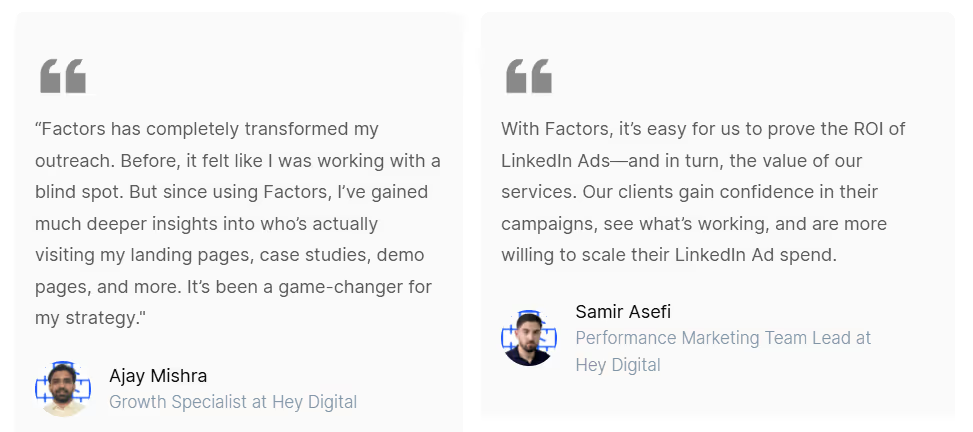
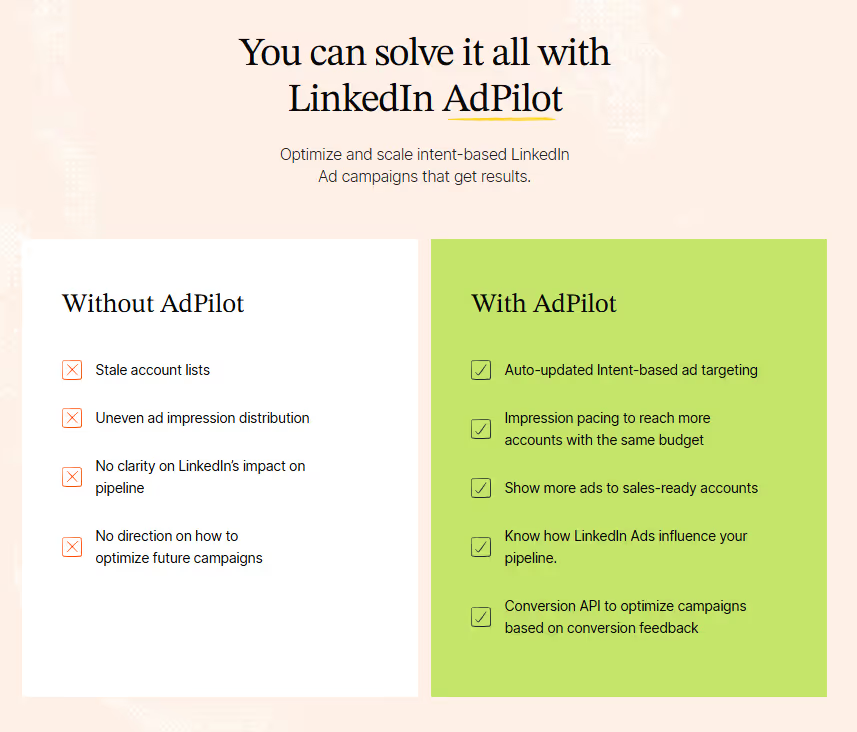
- Google AdPilot
The same intelligence is being extended to Google Ads, bringing B2B precision to the world’s largest ad network.- Audience Sync: Push high-intent accounts from Factors directly into Google Ads for laser-focused targeting.
- Google CAPI Integration: Feed conversion and pipeline data back into Google’s algorithm to train it on what actually drives revenue.
Once live, this will enable full-funnel orchestration across LinkedIn and Google, giving marketers a single, connected view of ad performance and pipeline influence.

- Cross-Channel Orchestration
Factors connects ad interactions with every other engagement signal, webinar attendance, SDR outreach, content engagement, website visits, giving teams a unified view of account journeys.
You can finally see how ad exposure, sales touchpoints, and content interactions compound to move an account from awareness to revenue. - Pipeline Attribution, Not Vanity Metrics
Factors ties every ad campaign to pipeline and revenue outcomes, not surface-level metrics.
- Each ad’s influence is mapped across MQLs, SQLs, opportunities, and closed deals, giving GTM and RevOps teams a clear view into which campaigns accelerate revenue and which ones just drive noise.
- Because it sits on top of account-level intelligence, every ad decision is backed by buying-group behavior, not guesswork.
Why This Matters for Teams
- Demand Gen Managers: Can prove ROI by tying spend directly to influenced pipeline, not just impressions.
- Campaign Ops: Control ad exposure and budget efficiency with tools like frequency pacing.
- RevOps & CMOs: Confidently connect ad spend across LinkedIn and Google to revenue outcomes.
HockeyStack’s Ad Activation
HockeyStack brings ad performance into the GTM picture with a clear focus on LinkedIn.
Key strengths:
- LinkedIn Audience Sync: Retarget the right accounts to keep buying committees warm.
- Offline Conversions → LinkedIn: Push CRM or offline signals back into LinkedIn for better campaign optimization.
- View-Through Attribution: See which ads influenced accounts even without direct clicks.
- Google Ads Activation (coming soon): Expansion is on the horizon, but currently not live.
For teams heavily dependent on LinkedIn, HockeyStack covers the essentials. But beyond LinkedIn, orchestration still feels limited.

TL;DR: HockeyStack gets you started with LinkedIn-focused ad measurement and syncs. Factors extends into true multi-channel orchestration, with deeper LinkedIn controls, pipeline-linked reporting, and Google Ads integrations on the horizon.
Factors vs HockeyStack: GTM Workflows & Automation
Collecting insights is only half the battle. The real power lies in how quickly those insights can be acted upon across your GTM stack. This is where automation makes or breaks efficiency.
Factors’ GTM Workflows & Automation
- CRM Integration: Syncs contacts and deals with HubSpot and Salesforce, but also adds Apollo-based account enrichment for deeper firmographic context.
- Sales Engagement Workflows: Goes beyond CRM, with connections to HeyReach, SmartLead, and similar tools, allowing outreach automation directly from insights.
- Custom Workflows with Webhooks: Offers flexibility to push insights into any tool in your stack, not just the big CRMs.
- Account Prioritization: Uses intent signals and custom scoring to automatically route accounts into the right sequences or cadences.
Why This Matters for Teams
- Marketing Ops: Reduce the burden of manual list uploads and sync mismatches.
- Sales Teams: Get enriched account views and ready-to-action outreach flows without toggling across systems.
- Revenue Leaders: Ensure every high-intent account is engaged quickly and consistently.
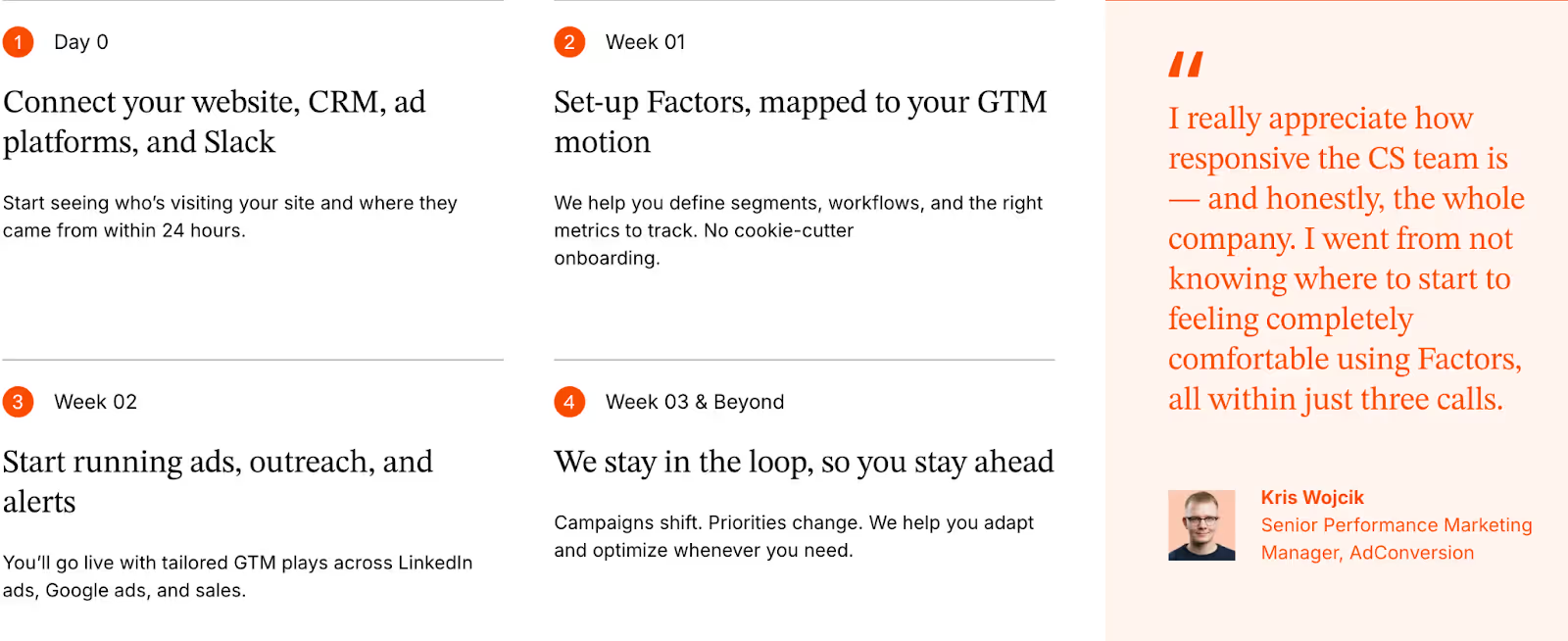
HockeyStack’s GTM Workflows & Automation
- CRM Updates: Automatically updates HubSpot and Salesforce with contact, company, and deal-level information.
- Data Enrichment: Pulls in marketing automation data like forms, meetings, and campaigns to enrich records.
- Custom Segmentation: Supports segmentation with CRM properties, which makes it easier to prioritize accounts.
- Cross-object Sync: Can sync sales data across Accounts, Contacts, Leads, and Deals, keeping revenue data clean.
HockeyStack ensures your CRM stays up to date. Factors extends that foundation, letting you automate the entire GTM motion, from enriched account insights to immediate outreach.
Factors vs HockeyStack: Security and Compliance
When evaluating GTM platforms, flashy features and AI capabilities usually grab the spotlight. But for enterprise teams, the conversation often circles back to a quieter, yet non-negotiable topic: trust. With sensitive customer data flowing through these platforms, security and compliance standards can make or break vendor selection.
Factors’ Security and Compliance
Factors has certifications and practices that resonate with larger organizations, especially those with global footprints.
Here’s what stands out:
- ISO 27001 Certification: A gold standard in information security management, recognized globally and often required by enterprises.
- SOC 2 Type 2: Like HockeyStack, Factors is independently audited for security, availability, and confidentiality.
- CCPA and GDPR: Full compliance with international and regional privacy frameworks.
- Enterprise-grade Governance: Security isn’t just a certification badge, Factors backs it with processes like continuous monitoring, documented policies, and dedicated security reviews for clients.
For companies where IT, legal, and procurement teams scrutinize every vendor, this level of security posture isn’t just a formality, it smooths the buying process and builds long-term confidence.

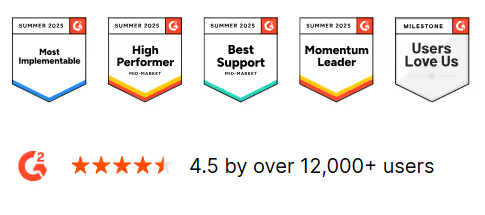
HockeyStack’s Security and Compliance
HockeyStack takes care of core compliance frameworks expected by most SaaS buyers:
- SOC 2 Type 2 Certification: Ensures controls around security, availability, and confidentiality are audited and validated.
- GDPR, CPRA, and CCPA: Compliance with major privacy regulations in the EU and California, covering data rights and consent management.
- Operational Safeguards: Includes processes for data handling, breach management, and regular audits.
For teams that want baseline enterprise security and proof of regulatory alignment, HockeyStack checks the right boxes.
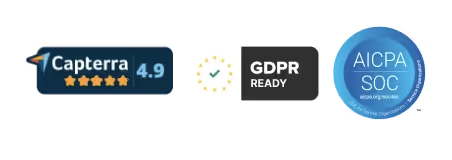
Factors vs HockeyStack: Onboarding and Support
Success with a GTM platform comes from how quickly your team can put its features to work and the quality of support you have along the way. A platform that looks powerful on paper but takes months to implement, or leaves you stranded after sign-up, will never deliver its promised ROI.
Factors’ Onboarding and Support
Factors takes a different tack, leaning into deeply guided onboarding and ongoing support. For growing SaaS and enterprise teams, this often feels less like “buying a tool” and more like bringing in a partner. Their approach includes:
- White-glove onboarding: A dedicated Customer Success Manager (CSM) works closely with your team to configure integrations, map workflows, and ensure data is flowing correctly.
- Dedicated Slack channel: Direct line of communication with the Factors team, ensuring quick responses and real-time collaboration.
- Weekly meetings: Regular check-ins to align progress, answer questions, and adjust strategies.
- Long-term partnership: Beyond initial setup, Factors positions itself as an extension of your GTM team, proactively suggesting improvements and helping scale use cases.
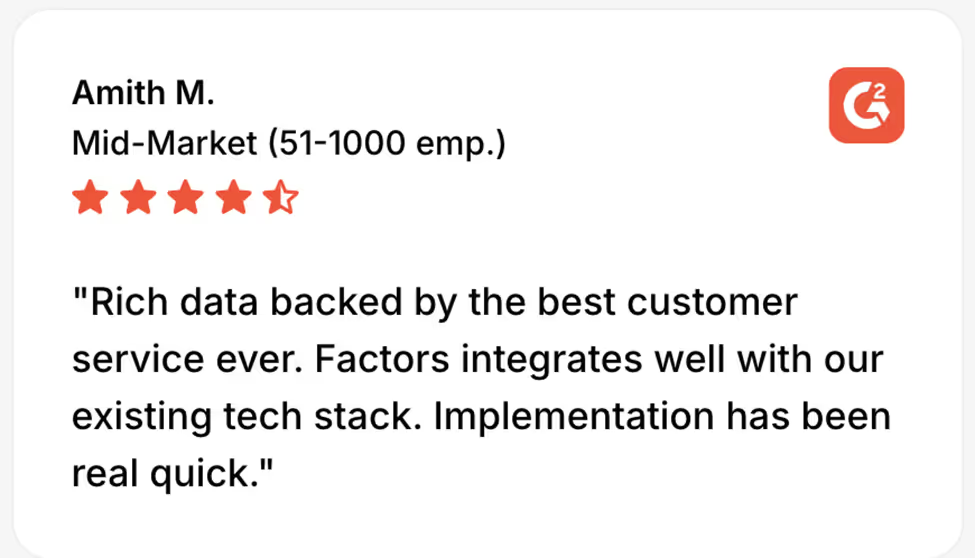
For companies where internal resources are stretched thin, or where the stakes of data-driven GTM are high, this level of hands-on involvement reduces the friction of adoption and speeds up time-to-value.
HockeyStack’s Onboarding and Support
HockeyStack positions itself as relatively straightforward to set up. Their onboarding is built around:
- Self-serve setup with documentation and product guidance.
- Assisted guidance from the HockeyStack team for customers who need help beyond self-service.
- Ongoing support to troubleshoot or advise when teams hit roadblocks.
This model works well for companies with in-house technical resources who prefer to configure and test tools themselves. It also gives autonomy to GTM teams that want to move quickly without waiting on vendor-driven timelines.
Factors vs HockeyStack: Which tool should you choose?
Choosing between HockeyStack and Factors ultimately comes down to the depth of your GTM motion and how your team plans to scale.
Factors is designed for teams that want to go beyond measurement and actively drive pipeline. The platform not only consolidates multi-touch data and offers deeper intelligence with 1st, 2nd, and 3rd party signals, but also bundles account identification natively, automates workflows across CRM and sales engagement tools, and introduces AI Agents and GTM Engineering to turn insights into action. Its tiered pricing, from Free to Enterprise, makes it easy to start small and scale predictably, while white-glove onboarding ensures adoption happens quickly and smoothly.
HockeyStack, on the other hand, is a solid platform for teams focused on analytics, journey views, and actionable insights within a familiar CRM environment. It’s relatively straightforward to adopt and works well for smaller teams or those with strong internal ops resources. The starting price of ~$2,200/month gives clarity on upfront costs, but future scaling may require direct consultation with the HockeyStack team.
Where HockeyStack helps teams see, Factors helps them act, all while providing transparency and flexibility in both functionality and cost.
So, if your priority is…
So, basically...
Choosing Factors as a HockeyStack alternative is about enabling real pipeline impact. Both platforms offer GTM analytics, segmentation, and journey mapping. However, their core philosophies diverge sharply: HockeyStack centers on flexible data views and CRM alignment, while Factors pushes beyond analysis to orchestrate outreach, ad activation, and automated GTM workflows.
Factors comes bundled with account identification, tiered pricing, and integrated AI Agents that trigger actions, not just reports. It combines 1st, 2nd, and 3rd party data with time-weighted scoring and offers native support for LinkedIn and Google ad orchestration. With a built-in enrichment layer and deep integrations into sales engagement tools, Factors turns GTM signals into scalable motion.
By contrast, HockeyStack excels for teams that prefer a self-directed, analytics-heavy setup. Its dashboards and segmentation are highly customizable, though deeper actions often require manual effort or internal ops bandwidth. Pricing starts higher, and expansion paths are less transparent.
In short, if your goal is to activate, not just analyze, your GTM data, Factors provides the tooling, automation, and scalability to execute with clarity and control.
.avif)
Top 7 GTM Engineering Tools
If you’ve been anywhere near B2B marketing or revenue ops lately, you’ve probably heard the term GTM Engineering being thrown around a lot.
And if you’re anything like me, you’ve wondered,
“Is this just another fancy way of saying automation?”
Not quite.
The truth is, GTM engineering is quietly becoming the backbone of modern growth teams, the part that connects data, systems, and strategy into one seamless motion.
And while the role of a GTM engineer is still evolving, the tools behind them are already reshaping how revenue teams operate.
From intent data orchestration to workflow automation to AI-powered buyer mapping, GTM engineering tools are the new growth stack every RevOps and marketing leader needs to know about.
Let’s break it all down, what GTM engineering really means, why it matters, and which platforms are setting the standard.
TL;DR
- GTM engineering is the next evolution of growth. It connects your entire revenue stack, so data, signals, and actions flow seamlessly instead of living in silos.
- A strong GTM platform becomes the command center for your go-to-market motion: it identifies who’s showing intent, enriches that data, prioritizes the right accounts, and triggers timely, personalized outreach.
- Tools like Factors.ai, along with Clay, Apollo, Warmly, N8N, Jason AI, and Make, each solve a piece of that puzzle, from account identification and enrichment to orchestration and automation.
- Together, they turn intent into action: your teams respond faster, outreach becomes more relevant, and your revenue motion scales without adding more headcount.
- This guide breaks down how these platforms work, how to choose the right mix for your team, and how to design GTM workflows that are faster, smarter, and built to grow.
Read on for the full breakdown, tool comparisons, and practical frameworks you can start using today.
What is GTM Engineering (and why everyone’s talking about it)
At its simplest, GTM (Go-To-Market) engineering is the art (and science) of connecting your growth stack so your marketing, sales, and product data actually talk to each other.
It’s what happens when your Google Ads, LinkedIn, CRM, and product analytics stop behaving like separate universes and start functioning like a single ecosystem.
If marketing automation gave us ‘if this, then that,’
GTM engineering gives us:
“If this exact ICP account did this action on our site, send this message through Slack, sync this data to Salesforce, and adjust this campaign on LinkedIn.”
It’s smarter, faster, and infinitely more contextual.
A GTM engineer is the operator behind that curtain, the person who builds, automates, and optimizes those connections so nothing slips through the cracks.
They’re automating busywork while turning data into real revenue motion.
Why you need a GTM Engineering platform
Every growth team hits the same wall at some point.
You have great data AND great tools. But none of it feels connected.
You’ve basically built a tech stack that looks like a group chat where everyone’s talking, but no one’s listening.
- Your LinkedIn ads generate clicks, but sales never sees them.
- Your CRM is overflowing with contacts, but no one knows who’s actually ready to buy.
- Your intent signals look great in dashboards, but there’s no system to trigger real action.
That’s where a GTM engineering platform comes in.
Think of it as the central hub where every part of your GTM stack finally works together..
When done right, it gives your entire revenue team:
- Speed: instant alerts, faster follow-ups
- Visibility: unified funnel and journey analytics
- Precision: real intent data guiding campaigns
- Scalability: one logic powering every motion
Or in simpler terms:
A GTM engineering platform helps your tech stack operate with more intelligence and purpose.
Want to see how intent-driven platforms beat traditional lead generation? Read here: Intent Data Platforms vs Traditional Lead Generation
The tool everyone’s talking about: Factors
Let’s start with the one that’s quietly setting a new benchmark for GTM orchestration.
1. Factors.ai
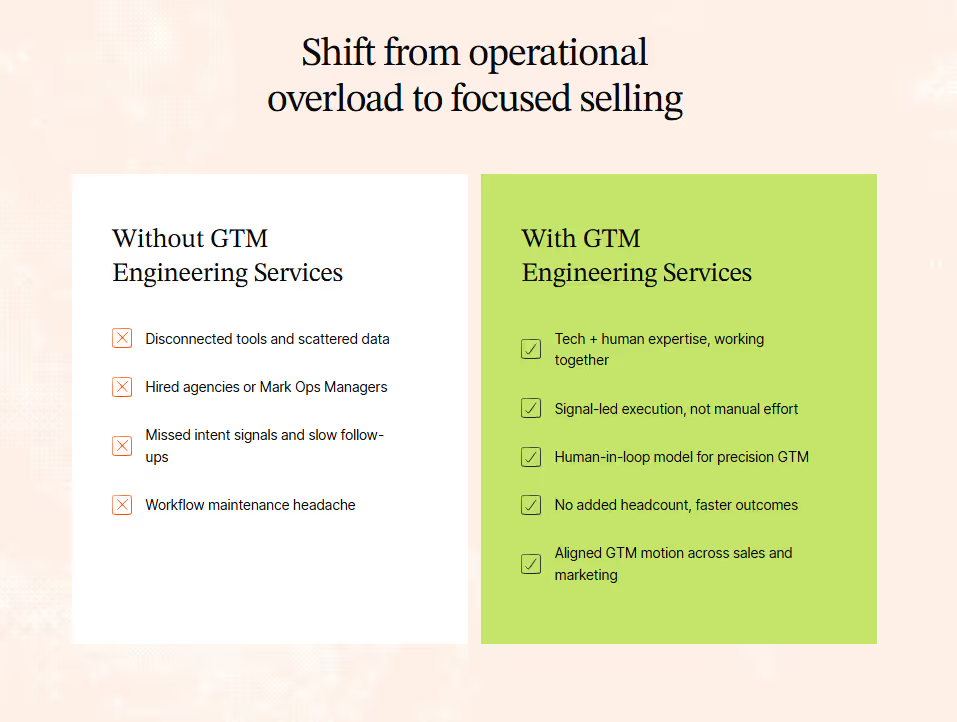
Most teams already have intent data. You’re tracking site visits, ad clicks, G2 activity, it’s all there. But knowing who’s showing intent is only step one. Acting on it fast, smart, and at scale, is where the dough really starts rolling in.
Here’s how it works
- Identify ICP Accounts Instantly
Factors identifies up to 75% of website visitors (vs. the usual 8–10%) using a waterfall enrichment model that pulls from multiple data vendors.
It combines first-party signals (website visits, CRM data, ad clicks) with external intent from G2, LinkedIn, and product usage, giving you a single source of truth on who’s ready to buy. - Pinpoint the Right Contacts
Using geo + role triangulation, Factors surfaces the actual decision-makers inside those companies, the ones most likely visiting your site.
You’ll know who to reach, why they’re relevant, and what they care about, without another round of guesswork. - Automate the Follow-Up (Without the Chaos)
This is where GTM engineering truly comes to life, when insights turn into action.
Factors doesn’t stop at sending alerts; it executes follow-up sequences across your GTM stack with precision.
- Sends real-time Slack or Teams alerts when high-intent accounts engage
- Auto-enriches contacts through Clay and Apollo.io, updating your CRM instantly
- Prioritizes accounts with tiering logic based on job changes, funding, and ICP fit
- Triggers context-based outreach via email, LinkedIn, or ads at the right time
- Keep Humans in the Loop
Every alert includes context that matters, the account journey, pages viewed, contacts to reach, and suggested openers.
No more playing 20 questions with alerts like: ‘someone from a ‘company of interest’ visited.’
Instead, you get detailed alerts like this:

That’s exactly what Factors.ai does.
It’s a GTM engineering platform that turns your intent signals into instant, contextual action across your funnel, from detection to outreach to follow-up (just like a private detective).
Meet Your GTM Engineering Agents: Factors’ AI Agents
Each “agent” inside Factors automates a piece of your go-to-market puzzle:
Agent
What It Does
Outcome
Website Visitor Identification Agent
Detects companies visiting your site and infers likely users
Real-time visibility into ICP engagement
Contact Relevance Agent
Surfaces the right people within buying committees
Context-rich contacts, ranked by relevance
Account Tiering Agent
Scores and classifies accounts using external signals (hiring, funding, job changes, etc.)
Smart prioritization
Advanced Enrichment (Clay/Bitscale)
Cleans and validates contact data before writing to CRM
Reliable, high-accuracy data
Account Map Agent
Identifies the buying committee and maps relationships
Multi-threaded outreach
Meeting Assist Agent
Tracks post-meeting engagement and next best actions
Contextual sales follow-up
Closed-Lost Account Alert
Detects when old deals resurface on your site
Re-engagement opportunities
Together, these agents run autonomously, enriching, prioritizing, and activating leads so your reps spend time where it actually counts.
Here’s why growth teams choose factors
- Contact-Level Precision: Go beyond account ID; find who’s behind the visit with person-level identification (up to 30%) using geo + role inference
- Custom Workflows: Built for your SDR motion, tech stack, and AI-curated messaging based on buyer stage, role, and company context
- Fully Managed Setup: Done-for-you GTM engineering; no ops bandwidth needed.
- Higher Coverage: Identify up to 75% of accounts vs. the 10% industry average.
- Tool-Agnostic Integration: Works with your existing CRM, ad stack, and orchestration tools (HubSpot, Salesforce, Clay, Smartlead, HeyReach, Trigify, etc.).
- Real-time account alerts in Slack or CRM
- Cross-platform audience syncs (LinkedIn + Google)
- Full-funnel journey analytics tying campaigns to revenue
Whether you want a done-for-you setup or a done-with-you model, Factors helps you bring structure to your GTM motion, so your sales process finally runs on intent, not instinct.
If you’re a demand-gen leader trying to align marketing and sales, this is the stack you wish existed five years ago.
💡Want to see how Apollo integrate with Factors.ai? Check out our guide: How to integrate Apollo with Factors
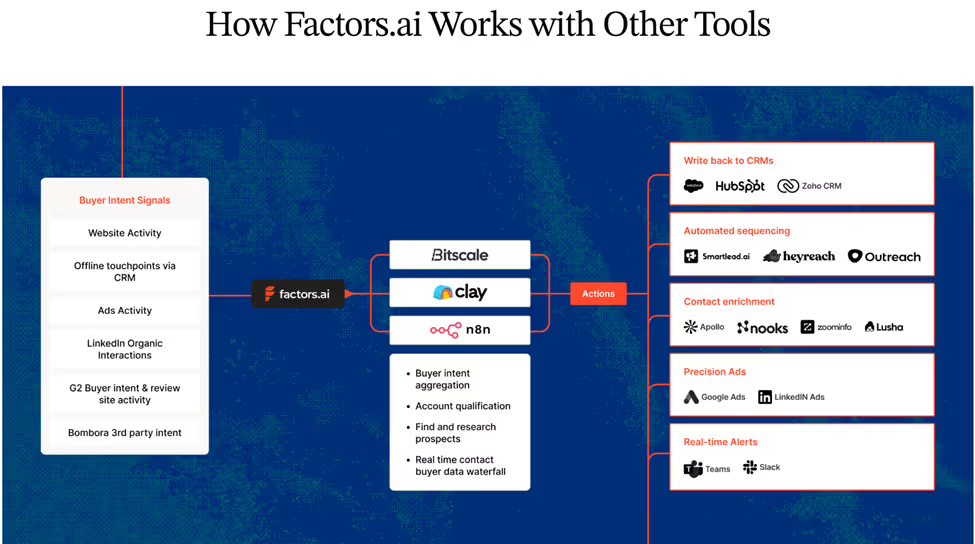
Other top GTM Engineering tools
Now let’s look at the broader GTM engineering ecosystem, the tools that GTM engineers, RevOps leaders, and growth teams are relying on to automate, orchestrate, and personalize their motions.
2. Clay
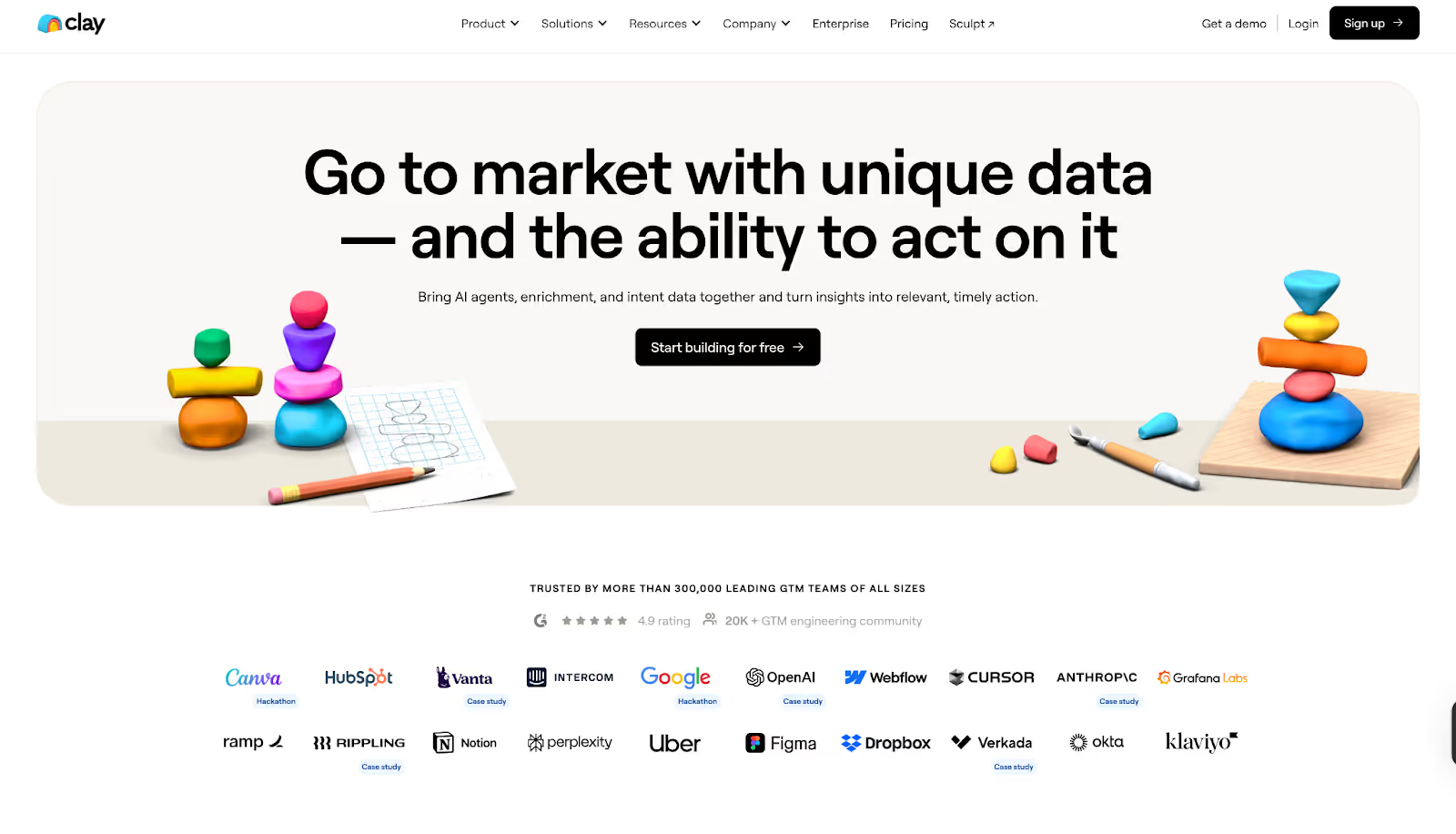
Clay is the platform that first put GTM engineering on the map.
It’s like having a data scientist, automation builder, and API whisperer all rolled into one sleek UI.
With Clay, you can build custom data enrichment workflows that pull, clean, and connect data from hundreds of sources, automatically.
Best for
Teams that need hyper-personalized prospecting or data-driven outbound workflows.
Why it’s powerful
- Enrich data from 150+ sources in real-time
- Visual workflow builder (no-code + API-level depth)
- Integrates with HubSpot and Apollo
- Ideal for “growth engineers” who live in Airtable and Notion but want more horsepower
If your GTM engine is powered by data enrichment and personalization, Clay is your control tower.
(Curious how Clay stacks up against other tools? Check out our post: Top 5 Clay Alternatives to Improve Sales Outbound)
3. N8N
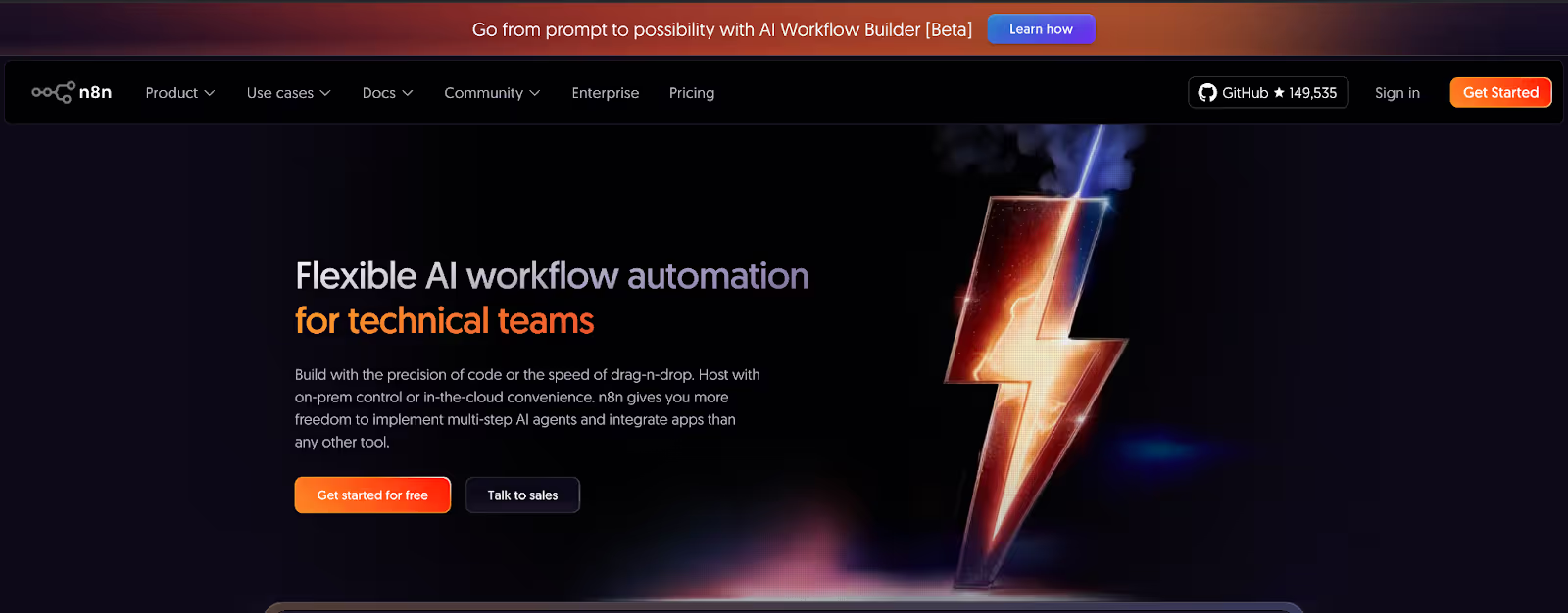
For technical GTM engineers who want absolute control, N8N is the open-source orchestration tool of choice.
It lets you design deeply complex, multi-step workflows that can connect virtually anything with an API, and customize every trigger, condition, and loop.
Best for
Technical GTM teams and RevOps engineers building custom automations at scale.
Why it’s great
- 400+ integrations (Salesforce, HubSpot, Slack, Google Ads, you name it)
- Self-hostable (ideal for teams that care about data privacy)
N8N is the kind of tool that rewards creativity. It’s not plug-and-play; it’s build-and-own.
4. Apollo.io

Apollo is the perfect blend of data + delivery.
It’s one of the few platforms that lets GTM teams access millions of verified contacts, run automated sequences, and analyze performance, all in one place.
Best for
Outbound sales, SDR, and RevOps teams looking for integrated engagement and enrichment.
Why it works
- Massive contact database with verified data
- Integrated email and LinkedIn sequencing
- Enrichment APIs for custom GTM workflows
- Strong fit with other GTM orchestration tools like Factors and Clay
For many GTM engineers, Apollo is the source of truth for people data, the starting point of every automated workflow.
5. Madkudu
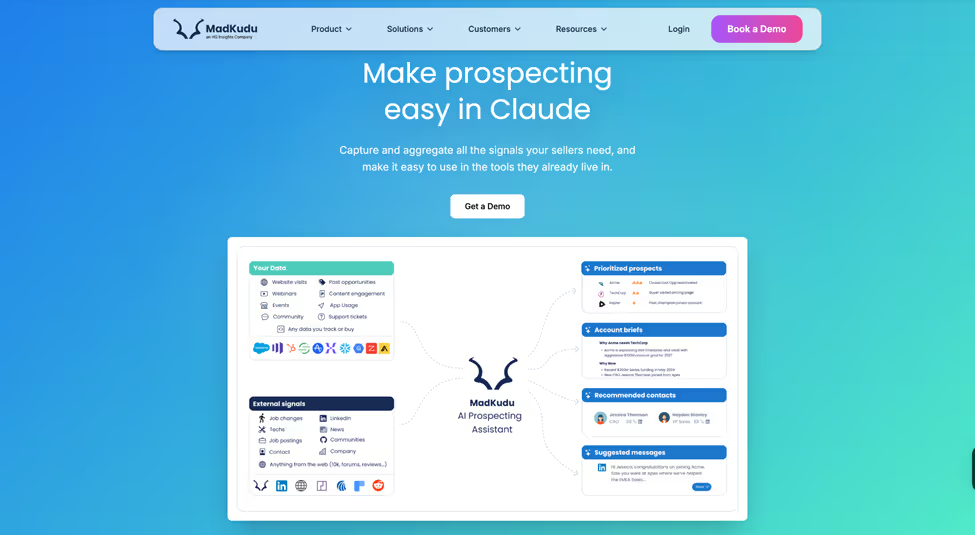
MadKudu helps GTM teams turn data signals into smarter prospecting. It combines firmographic, behavioural, intent and product-usage signals to surface which leads and accounts are most likely to convert. The platform integrates with tools like Salesforce, Gong, Outreach and others so sellers and RevOps can act on prioritised prospects and accounts within their existing workflows.
Best for
Sales, RevOps and GTM teams that want to focus on high-conversion prospects and accounts using AI-driven scoring.
Why it works
- Unifies fit (e.g., firmographics) and intent/usage (e.g., website visits, product activity) data into dynamic lead/account profiles.
- Uses AI to build predictive models based on your past conversion and revenue history, so sellers see which leads/accounts matter most.
- Surfaces that intelligence directly in CRM or sales engagement platforms, enabling faster, more meaningful outreach.
Things to keep in mind
- Works best when your underlying data is clean and well-structured.
- Setup (including modelling, testing and integration) can take time, especially for complex GTM motions.
- Pricing is enterprise-oriented, varying by seats, scoring models and usage.
6. Jason AI SDR (Reply.io)

Think of Jason as your AI-powered GTM assistant.
Built by Reply.io, this tool learns from your outreach patterns and automatically builds and optimizes your multi-channel cadences.
Best for
Teams running scaled personalization across email and LinkedIn.
Why it’s unique
- AI-generated sequences that adapt to buyer behavior
- Auto-optimization of timing, tone, and follow-up
- Integrates with CRMs and GTM orchestration tools for real-time triggers
- Saves SDRs hours of manual follow-up
The magic here is personalization at scale, something that’s been “impossible” until now.
7. Make (Integromat)
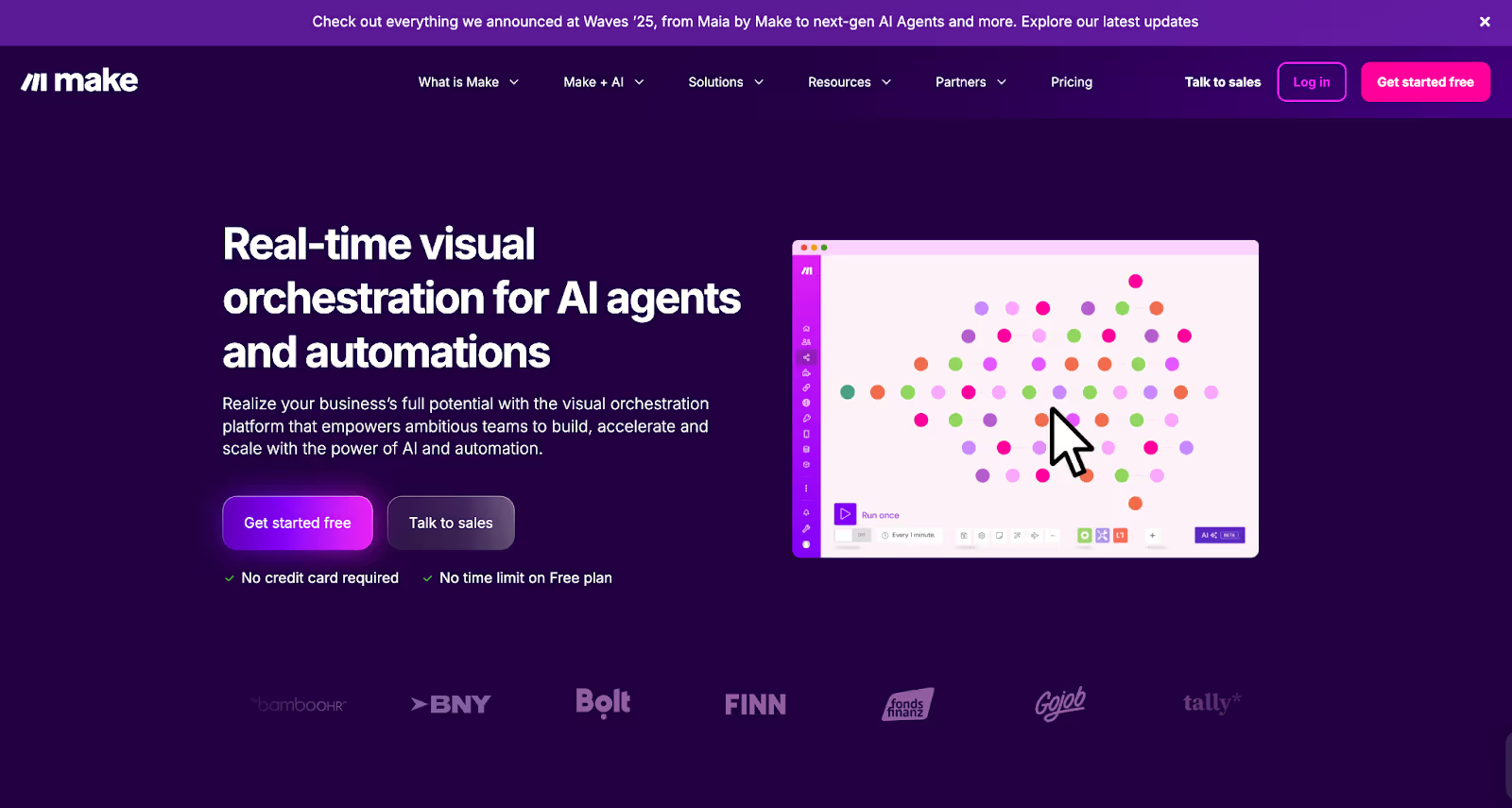
Make (previously Integromat) is a visual automation builder that gives non-technical GTM teams the power to connect and automate across platforms without a single line of code.
Best for
Startups and SMBs building flexible GTM stacks without engineering dependency.
Why it’s useful
- Intuitive drag-and-drop workflow builder
- Pre-built GTM templates (e.g., lead routing, lead scoring, lead enrichment)
- Integrates with almost all major CRMs, ad platforms, and analytics tools
- Great for teams that need speed over complexity
It’s the friendly, lightweight cousin to N8N, perfect for smaller teams who still want orchestration superpowers.
The magic comes when you turn intent signals into outreach automatically.
(Read more in: The Step-by-Step Guide to Turning Signals into Sales Conversations)
Compare Best GTM Engineering Tools For SaaS and RevOps teams
How to choose the right GTM Engineering tool
If you’re reading this thinking, “Okay, but where do I even start?”, here’s the simple answer:
- Start with your pain point.
- Struggling to unify data? → Go with Factors or Clay.
- Too many manual handoffs? → Try N8N or Make.
- Need to activate intent data fast? → Combine Warmly + Factors.
- Scaling outreach? → Add Apollo or Jason AI SDR.
- Then map your workflow.
Sketch out what you want to happen from the moment an account shows intent to when sales takes action.
Your GTM tool should fit that flow, not the other way around.
And finally, don’t aim for perfection on day one.
Start small, automate one motion, measure the impact, and scale from there.
Best practices for GTM Engineering implementation
Implementing GTM tools is about designing for flow.
Here’s what works in the real world that’s powered by two large espresso shots:
- Start with impact, not complexity. Automate high-ROI motions first (like inbound routing or deal alerts).
- Build transparency. Document every workflow and make sure sales and marketing teams understand it.
- Monitor constantly. Add error alerts, dashboards, and rollback logic.
- Don’t skip data hygiene. Even the smartest automation fails on messy inputs.
- Iterate monthly. Treat your GTM stack like a product, improve it every sprint.
Future trends in GTM Engineering Tools
Here’s what’s next for GTM engineering:
- AI-generated workflows - Describe your intent (‘Alert me when a CMO from ICP Tier 1 engages on LinkedIn’), and the system builds the logic automatically
- Self-healing automation - Workflows that fix themselves when an API fails or a field changes.
- Cross-channel attribution baked in - True end-to-end visibility across web, ads, and CRM.
- Natural language builders - Create entire GTM flows by chatting with your tool.
- Hybrid human + AI orchestration - The engineer becomes the strategist, the AI runs the ops.
The next wave is about the intelligent connection between tools that matter.
In a nutshell…
GTM engineering is how modern revenue teams will operate, blending data, intent, and automation into one fluid system.
And honestly? It’s about time.
Because the problem was never a lack of data, it was a lack of connection. The right GTM engineering tools bring speed, clarity, and cohesion to your entire go-to-market plan.
If you’re leading marketing, RevOps, or growth, this is your cue:
Stop fighting your stack, start orchestrating it.
FAQs on GTM Engineering Tools
Q1. What are GTM engineering tools?
A. They’re platforms that connect marketing, sales, and product systems through data, automation, and workflows, enabling faster, smarter revenue motions.
Q2. Do GTM engineering tools replace RevOps or sales ops?
A. No. They augment them. RevOps typically builds stable infrastructure; GTM engineers build the growth experiments, workflows, and iteration layer.
Q3. Are they different from RevOps tools?
A. Yes. RevOps organizes. GTM engineering builds and automates.
Q4. Do you need engineers for GTM engineering?
A. Not always. Tools like Factors are designed for non-technical ops and marketing users.
Q5. How long does it take to adopt a GTM engineering tool?
A. Small workflows can launch in days or weeks; full-stack rollout may take months, depending on complexity.
Q6. What’s the ideal GTM tool stack?
A. A mix of Factors (orchestration), Clay (enrichment), Warmly (intent), and Apollo.io (engagement), optionally supported by N8N or Make for custom automations.
Q7. What qualifies as a ‘GTM engineering tool’?
A. Any platform or software that enables you to design, orchestrate, trigger, branch, and monitor growth workflows that bridge marketing, sales, and product.
Q8. What’s a ballpark budget for these tools?
A. Depends on users, workflow volumes, data operations, ranges from low 5-figure USD annually to mid 6-figure for enterprise.
Q9. Can I build my own vs buy a commercial tool?
A. Building gives flexibility but demands maintenance and time. Buying gives support, updates, and often better UI/UX. The tradeoffs depend on your team’s capacity.
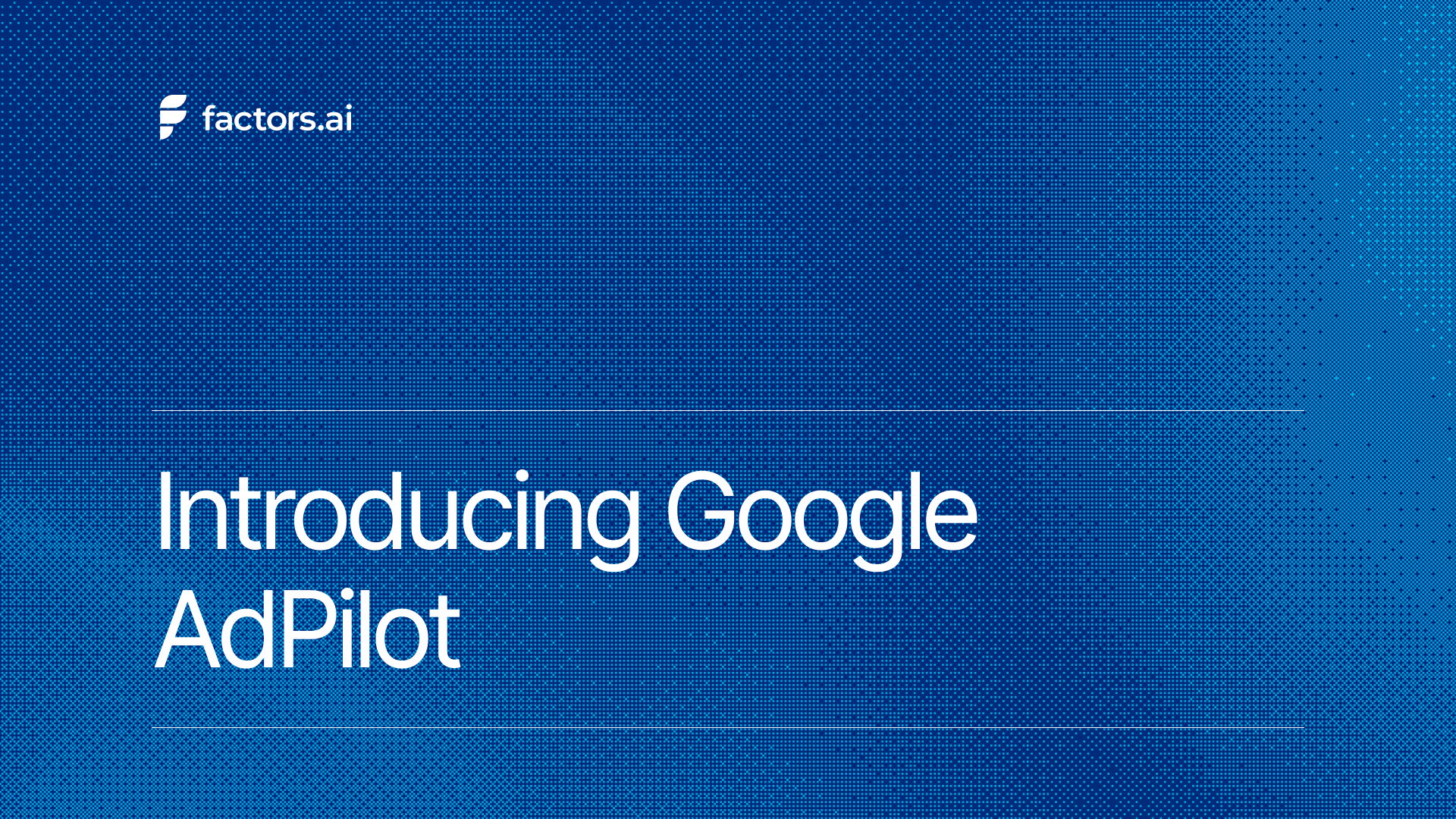
Introducing Google AdPilot: Smarter, ABM-Ready Google Ads for B2B
If you’ve been running Google Ads for a while, you’ve probably felt the shift.
Campaigns that used to feel predictable now behave like living, breathing teenagers.
CPCs spike without warning. Performance fluctuates. And your sales team keeps saying, “These leads aren’t our ICP.”
That’s because Google Ads itself is changing fast.
The age of AI-driven advertising is here, and it’s reshaping how campaigns learn, optimize, and measure success.
Today, Google is pushing marketers toward three big shifts:
- AI automation everywhere: Smart Bidding, Performance Max, AI placements, and machine-driven optimization.
- Privacy-first measurement: where enhanced conversions and server-side feedback (CAPI) now power the signal loop.
- Intent-based audiences: where reaching the right buyer depends on how well you define and feed your ICP.
It’s powerful, but it also means marketers are losing some control.
Google’s AI can only optimize based on the signals you give it. If your data isn’t clean, rich, and value-weighted, it learns the wrong things and targets the wrong people.
That’s why now is the moment to rethink how you run Google Ads.
Enter Google AdPilot by Factors.ai, built for the new AI era.
AdPilot helps you align with where Google Ads is headed: it lets you target only ICP-fit accounts, train Google’s AI with richer conversion feedback, and track how every ad drives actual pipeline, not just clicks.
Because in an AI-first ad world, the marketer who controls the signal wins.
TL;DR
Most marketers scale Google Ads but lose efficiency. They target too broadly, send incomplete data, and can’t connect ads to pipeline.
Google AdPilot fixes that by letting you:
- Target only ICP-fit accounts
- Train Google’s AI with up to 3× more conversion feedback
- Assign values to conversions based on deal quality
- See how every ad, keyword, and channel drives revenue
What’s Google AdPilot?
AdPilot helps marketers skip wasted spend and random leads.
It lets you target the right accounts, train Google’s algorithm to optimize for ICP-fit conversions, and track how ads actually influence pipeline, so every click counts.
In short: it brings precision, efficiency, and visibility to one of the most powerful ad platforms you already use.
Why Scaling Google Ads Gets Harder
Scaling Google Ads is easy. Scaling it efficiently? Not so much.
Here’s what typically happens:
- Broad keywords attract irrelevant traffic.
- Google’s AI learns from incomplete or low-quality conversion data.
- You have no clear visibility into how ads influence revenue.
You end up optimizing for volume of conversions instead of value, sending incomplete conversion feedback, remarketing to everyone who visits your website, and relying on surface-level analytics that never show what’s truly driving pipeline.
How Google AdPilot Fixes It
Google AdPilot helps you take back control of your Google Ads, across targeting, training, and tracking. Here’s how each pillar works.
1. Audience Sync: Smarter Targeting, Lower Waste
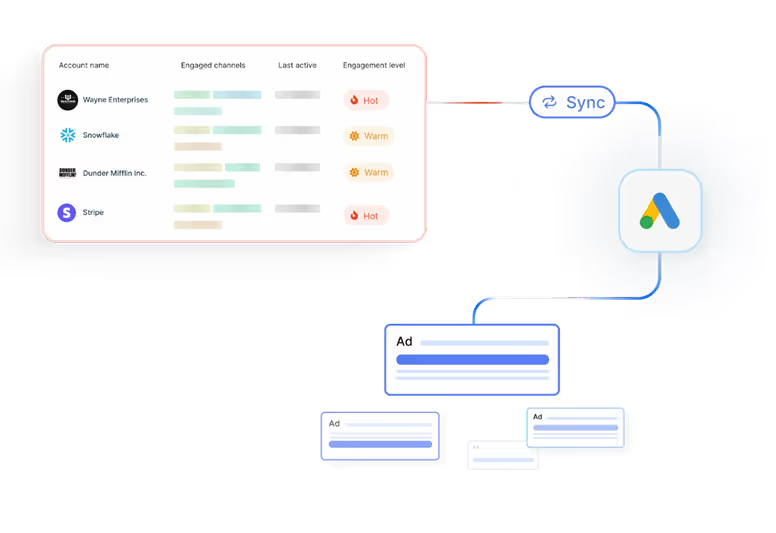
Scaling Google Ads without wasting spend starts with who you target.
- Precision Re-marketing
If you’re re-marketing to everyone, you’re wasting half your budget on visitors who’ll never convert.
With Audience Sync, you can retarget only ICP-fit accounts and high-intent visitors, using account-level firmographic and behavioral data.
Your ads show up for real buyers, not random browsers.
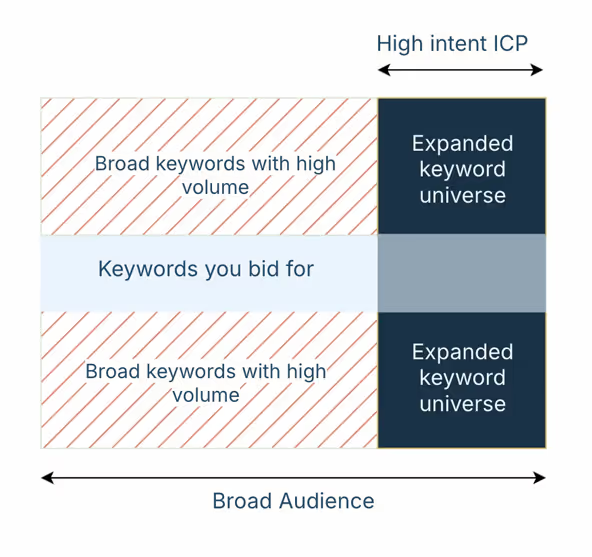
- Keyword Expansion with Audience Control
Broad keywords like ‘CRM’ or ‘helpdesk’ are powerful, but risky and costly. Normally, they attract irrelevant traffic and burn through budget.
With Google AdPilot, you can safely remarket to your best-fit accounts with broad keywords. You can finally expand your reach without compromising efficiency.
- Exclusion Audiences That Save Budget
Competitors, job seekers, and existing customers still click your ads.
With Audience Sync, you can automatically create and sync exclusion lists directly to Google Ads, cutting off those low-value clicks before they drain spend.
- Buyer-Stage Targeting
Google Ads isn’t just a top-of-funnel play.
With Google AdPilot, you can identify where each account is in the buyer journey and run stage-specific campaigns, tailoring messaging across Search, GDN, and YouTube.
It’s precision ABM, delivered at Google scale.
- Always-On Audiences
Manual uploads are slow and outdated.
With Google AdPilot, your audiences refresh daily based on live engagement signals, no CSVs, no lag. You get always-accurate targeting that scales with your funnel.
2. Conversion Feedback: Train Google’s AI to be smarter
Google’s AI is only as good as the data you feed it
Most marketers send incomplete or low-quality conversion data, so Google learns from the wrong signals.
- Enhanced Conversions (CAPI)
Powered by Google’s Enhanced Conversions, AdPilot goes beyond just tracking more conversions, it teaches Google which conversions actually matter.
Instead of sending every form fill the same value, AdPilot assigns differential weights based on ICP fit, deal size, and buyer stage. A $50K enterprise opportunity doesn’t look the same as a $2K trial signup, and now, Google knows that too.
By feeding Google value-based feedback, AdPilot helps its algorithm recognize high-quality clicks, prioritize high-value accounts, and optimize bidding toward revenue, not just volume. So every signal you send back tells Google, “Find more of these.”
- Up to 3× More Conversion Signals
Most marketers only send about half of their actual conversions back to Google, because traditional setups credit only the user who fills a form and ignore everyone else involved in the buying journey.
Google AdPilot fixes that.
It captures every GCLID (Google Click Identifier) from ad clicks, even when no form is submitted. Then, it maps those clicks back to the right account using account-level identifiers and reverse-IP enrichment.
That means if three decision-makers from the same company visit your site, one fills a form, two just browse pricing, Google now sees all three as part of the same conversion journey.
By capturing and feeding these multi-touch, account-level conversions back through Google’s Enhanced Conversions (CAPI), AdPilot sends up to 3× more accurate signals than a standard setup. The result: Google learns faster, optimizes better, and focuses your ad budget on accounts that actually move the pipeline, not on one-off clicks that never convert.
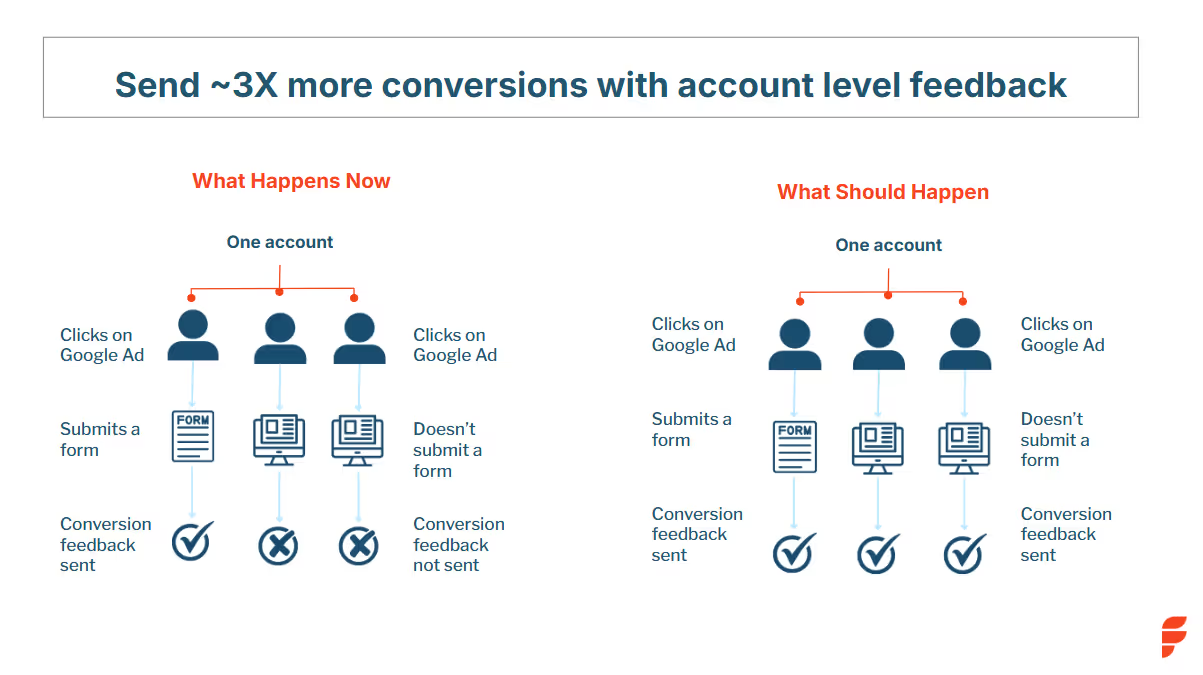
- Differential Conversion Values
Not all leads are equal.
An enterprise deal shouldn’t carry the same weight as a small trial signup.
AdPilot assigns value-weighted conversions based on ICP fit, stage, and potential deal size.
This enables smarter bidding strategies like Max Conversion Value or Target ROAS, ensuring Google optimizes for revenue, not volume.
- Click-Level Feedback
Not every click is created equal, and Google’s algorithm doesn’t know that unless you tell it.
With Click-Level Feedback, AdPilot evaluates each click based on who it came from and how likely that account is to move forward in the buying journey.
It looks at factors like ICP fit, engagement depth, and predictive scoring to assign every click a weighted value.
If a click comes from an enterprise account that matches your ICP and spends time on your pricing page, it’s assigned a higher value. If it’s from a low-fit SMB or a short bounce, it’s weighted down.
This way, Google’s AI starts recognizing the quality behind each click, not just the quantity. Your bids, budgets, and optimizations all start pointing toward the kind of traffic that actually turns into deals.
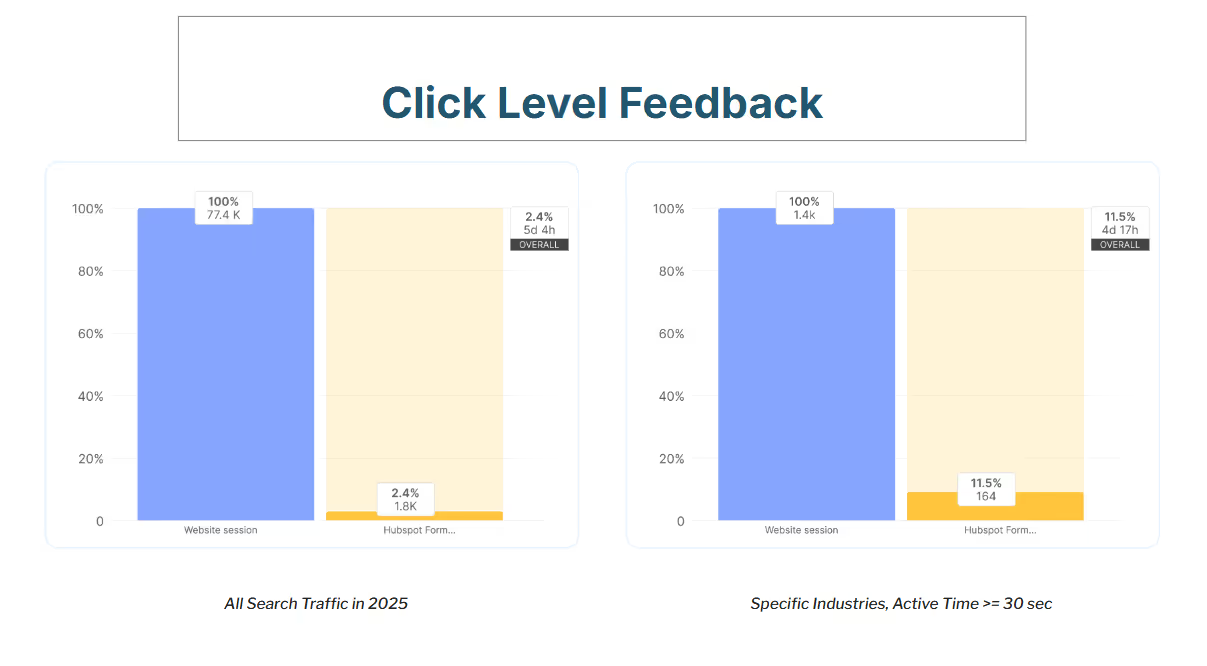
3. Analytics: Visibility beyond clicks
For years, Google Ads reporting has revolved around surface metrics, impressions, clicks, CPCs, and conversions. Useful? Sure. But not enough for modern B2B marketers.
Because in reality, a click doesn’t always equal a conversation. And a form fill doesn’t always mean pipeline.
With Google AdPilot, you finally see what happens after the click. It gives you full-funnel visibility, from impression to opportunity, so you can connect every ad, keyword, and visitor back to real business impact.
- See Which Accounts Paid Search Brings In
Most marketers can’t tell which companies actually land on their site from paid search if they don’t fill a form.
AdPilot changes that.
It identifies the exact accounts visiting through your Google Ads, even if no one fills out a form.
You get firmographic details, intent data, and engagement metrics that your sales team can act on immediately. Instead of “somebody from Google Ads visited,” you know who, how often, and how ready they are to buy.
- Know What Your Buyers Search For
Clicks are just the starting point. AdPilot shows you the actual search terms your ICP accounts use before visiting your site, not just aggregated keywords.
It helps you tie those searches directly to pipeline influence, revealing what high-value buyers are genuinely looking for. So you can prioritize the terms, messages, and offers that drive revenue, not just traffic.
- Understand Paid Ads in the Bigger Picture
Paid search rarely works in isolation. A Google ad might spark awareness that later converts through organic, direct, or referral channels.
AdPilot’s analytics show you those cross-channel patterns, how ads influence website behavior, what pages accounts explore before converting, and where they finally take action. You start to see how your ads move buyers through the journey, not just whether they do.
- Real-Time Dashboards Built for Marketers
AdPilot brings all your paid search performance, audience insights, and conversion data together, in one clean, visual dashboard.
You get the clarity to make faster, more confident decisions: which campaigns to scale, which audiences to prioritize, and which keywords to retire.
💡In short:
Audience Sync ensures you only target ICPs.
Conversion Feedback (CAPI) trains Google with richer, value-weighted signals.
Analytics gives you the visibility to connect every keyword and ad to real revenue.
Together, they turn Google Ads into a true ABM engine, efficient, measurable, and built for scale.
Reporting Live: From the dashboards
Teams using AdPilot have reported:
- Up to 3× more conversion feedback sent to Google
- Higher share of spend going to ICP-fit accounts
- Lower cost per qualified meeting
- Clearer attribution from ads to deals
“Before AdPilot, nearly 50% of our Google Ads spend went to non-ICP accounts. That meant wasted budget and poor conversion signals back to Google. With AdPilot, we can focus only on ICP accounts and feed Google the right data to optimize for high-value deals.”
- Mansi Peswani, Demand Generation Lead, Factors.ai
Fast, secure, and compliant setup
Google AdPilot connects to your existing setup in under an hour.
- Sync audiences directly to Google Ads. With Audience Sync, those lists stay continuously updated, so your campaigns never waste impressions on outdated or irrelevant audiences.
- Automate daily audience refreshes (no CSVs)
- Use Google’s Enhanced Conversion APIs (CAPI ensures every conversion event, from clicks to deals, is captured and shared securely with Google, enhancing attribution accuracy without compromising privacy.)
- Stay compliant with SOC 2, ISO 27001, and GDPR
Scale smarter, spend better and win bigger.
Google Ads will always be a marketer’s workhorse. But without precision targeting and smarter feedback, it starts galloping straight into wasted spend.
Google AdPilot by Factors.ai helps you take back control:
- Target high-fit accounts only
- Train Google’s AI with richer conversion data
- Track every keyword and ad to real pipeline
Because scaling ads should mean scaling revenue.
See it in action, Book a Demo
FAQs for Google AdPilot
1. What is Google AdPilot by Factors.ai?
Google AdPilot is a suite of features that transforms Google Ads into an ABM engine. It helps you target high-fit accounts, train Google with richer conversion feedback, and connect ad performance directly to pipeline.
2. How long does it take to set up Google AdPilot?
You can connect your CRM and Google Ads Platform to Factors with one click integrations. No complex setup or coding required.
3. Is Google AdPilot secure and compliant?
Yes. Google AdPilot is SOC 2, ISO 27001, and GDPR compliant. It uses Google-approved Enhanced Conversion APIs to ensure safe and compliant data handling.
4. Can I run Google AdPilot on top of my existing Google Ads setup?
Yes. AdPilot plugs right into your current campaigns. You can even A/B test it against your existing setup to see the difference in efficiency and ROI.

Best Keyword Tracker Tools (Free & Paid)
If you’ve spent any time doing keyword research, you know that ‘SEO position’ is a phrase everyone always throws around (and sometimes panics about). A web page’s ‘SEO position’ indicates how valuable it is for search engines, i.e., the rank it page holds in search results for relevant keywords.
SEO rankings dictate your page's visibility to search engines and readers.
So let’s say someone Googles ‘best marketing tools’ and your article on the topic appears third on Google, your SEO position for that keyword is #3. As the article moves up and down keyword positions, you'll see thousands of clicks gained or lost…and this can be the linchpin for your entire marketing strategy.
TL;DR
- Keyword tracking is the backbone of modern SEO. It measures a webpage’s true visibility and reveals rank volatility across devices and regions.
- Keyword rankings also help set performance benchmarks against competitors.
- Free tools like Google Search Console show basic positions, but pro suites such as SEMrush, AccuRanker, and SE Ranking offer deeper insights.
- Track keywords weekly for stability, daily for volatility, and regionally.
- Keyword tracking improves decision-making by showing what’s working and what’s declining.
- You can link SEO to content strategy to find new opportunities for engagement and conversions.
- Industry best SEO practices will define clear metrics for clients or leadership on organic growth, support algorithm-resilient SEO, and build accountability on ROI.
Why a Keyword Research Tool is Key to SEO Position Tracking
Spend two weeks in an SEO-first role, and you'll see that keyword rankings are as volatile as it gets. SEO positions and associated search volume can fluctuate because of:
- Discrepancy between mobile and desktop results,
- Missing location-specific keywords,
- Non-optimization of SERP features like maps, featured snippets, videos, and “People Also Ask” boxes,
- Inadequate personalization, which means Google will not showcase the article to many users based on their history, preferences, and behavior.
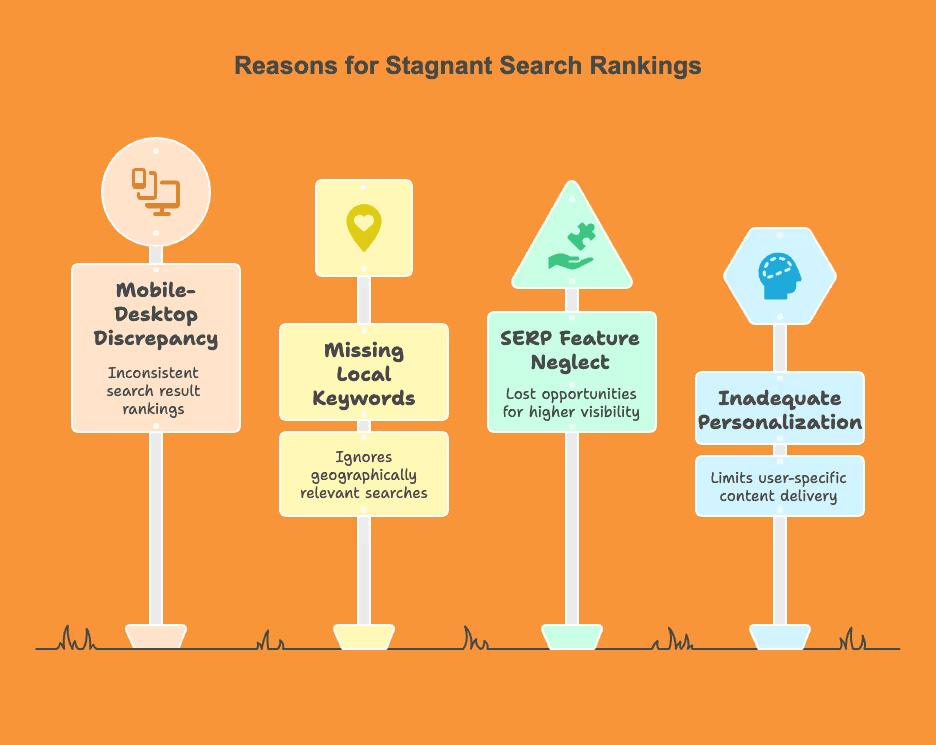
As a page climbs up and down the ranks for a given keyword, its visibility and click-through rate are directly affected. You’ll have to track target keywords' performance on major search engines consistently for any chance at continued success (yes, we know, you already have a lot on your plate).
No matter what anyone told you, sporadic, ad-hoc checks are not enough. There are no shortcuts to success, and believe me, we looked.
Whatever the industry, you’ll need long-term keyword data and search volume data to find trends, opportunities, and first-person advantages in a cutthroat business ecosystem.
How to Check Organic Rankings and Related Keywords
When choosing a keyword ranking tool, your choices lie between a free keyword rank checker and its paid counterparts… though honestly it’s not much of a choice in the long term.
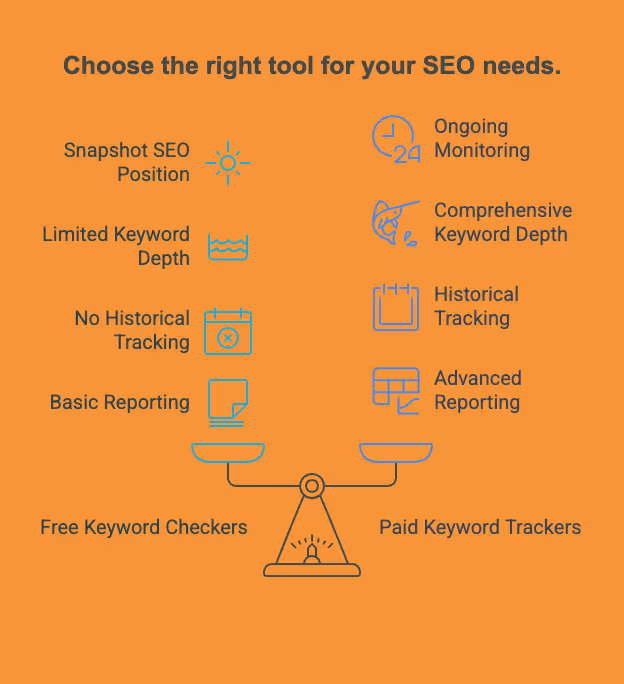
Free, one-off checks:
For a quick check on a webpage's current SEO position and rank, completely free tools like
Google’s incognito search or free rank checkers work fine. You can also use https://usearchfrom.com/
They offer a snapshot of the page's current SEO position, but can be bogged down by daily query caps, limited keyword depth, and often lack historical tracking.
Ongoing monitoring:
You won’t be able to put in the required SEO efforts without keyword tracking software that automatically monitors keyword rankings over time. You’ll get daily or weekly updates, competitive benchmarking, alerts for volatility, and trend visualizations.
Pro-Tip: Use free checks for spot audits, and paid trackers for reporting, multi-location, and collaboration.
Read More: B2B Marketing Solutions: A Complete Guide to Strategy & Implementation
Feature Checklist to Choose Keyword Tracking Software
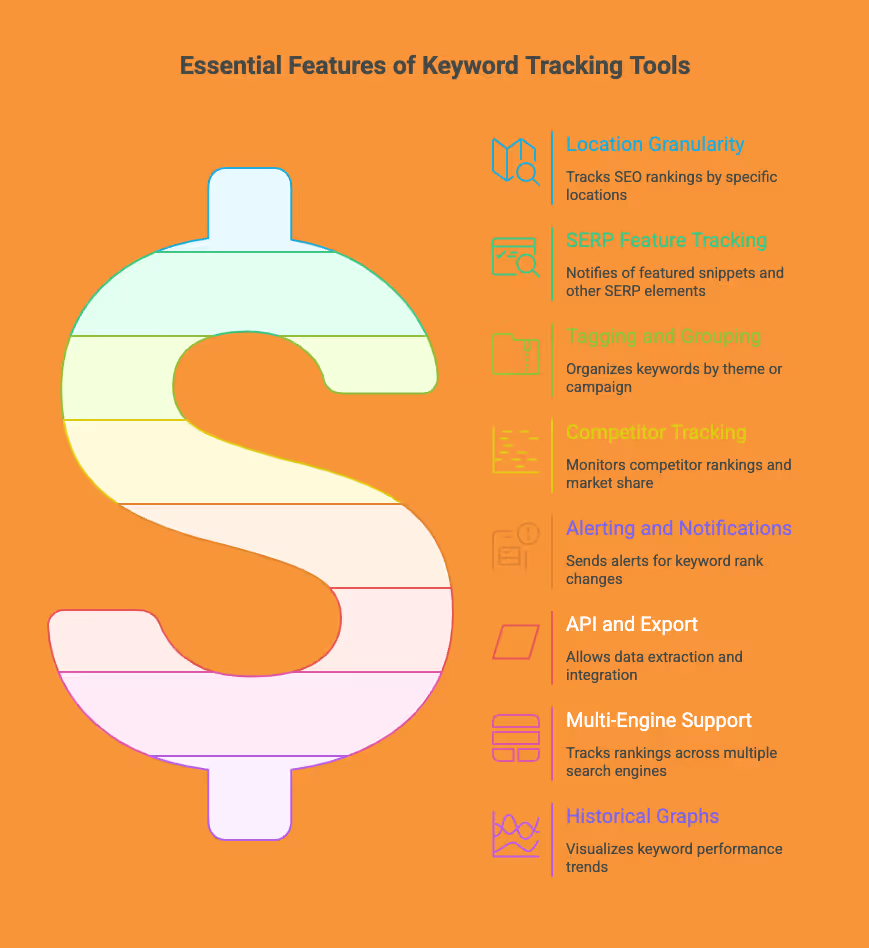
Every keyword tracking tool worth the investment (money and/or effort) must offer the following features:
- Location / Device Granularity: The tool should be able to track SEO rankings by location: country, city, ZIP code, etc. It should also be able to filter results by mobile and desktop (SERPs and rankings depend on device).
- SERP Feature Tracking: Can the tool notify teams when keywords trigger featured snippets, People Also Ask, videos, or local packs?
- Tagging / Folders / Keyword Grouping: Teams should be able to see keywords by theme, funnel stage, campaign, or product. This includes analysis of topic clusters or content silos.
- Competitor Tracking: How are other domains ranking for your keywords? Can you see rising competitors, market share shifts, SERP volatility? Can you use it for benchmarking and spotlighting strategy gaps?
- Alerting / Notifications: Will it send alerts if a keyword drops or rises in rank? Can it help predict keyword volatility?
- API / Export Capabilities: Can it extract data from your existing dashboards, spreadsheets, or intelligence tools? Does it support CSV, Excel, or JSON exports?
- Multi-Engine Support: Does the tool track keyword rankings across multiple search engines, like Yahoo and Bing? Or even region-specific search engines used in specific countries?
- Historical Graphs / Trend Analysis: Does the platform store historical data for every keyword? Can it visualize performance shifts, algorithm changes, and campaign effects?
Best Keyword Ranking Tools
1. SEMrush
Ideal for: SEO team requiring 360-degree coverage.
Stands out for: Offers comprehensive daily updates. Known for robust SERP feature detection, competitor comparisons, and location-based segmentation.
Caveat: For small teams, this tool can become expensive, especially as operations expand.
2. AccuRanker
Ideal for: Agencies, teams, or individuals who require quick yet precise rank data with clear client reporting.
Stands out for: Delivers real-time updates, keyword and SERP filtering, white-label reporting, as well as API access.
Caveat: Users of this tool will have to pay premium prices and also ensure a steep learning curve if they intend to use all features.
3. SE Ranking
Ideal for: Teams, agencies, and consultants that need to balance tool capabilities with cost.
Stands out for: Delivering comprehensive white-label reports, detailed client dashboards, and expansive competitor analysis and tracking.
Caveat: Necessary to pay more to unlock some advanced features.
4. ProRankTracker
Ideal for: Individual SEO professionals, early-stage startup teams, and/or marketing projects running on lean budgets.
Stands out for: Robust SEO rank tracking across multiple devices (desktop and mobile) across locations at an affordable price.
Caveat: Features to analyze UI and content optimization capabilities are basic, compared to enterprise solutions.
5. Google Search Console (GSC)
Ideal for: Anyone starting out with SEO. Use it to set foundational truths about a site's SEO value.
Stands out for: Being a relatively comprehensive tool at no cost, it delivers solid data on average position, impressions, clicks, and CTR per query/page.
Caveat: Doesn't go too in-depth on competitor data or deep SERP-feature context.
Our Recommendations:
- Best overall “organic rank tracker”: SEMRush
- Best for agencies/reporting: Factors.ai
- Best budget: ProRankTracker
- Best local/regional: SE Ranking
- Best free keyword ranking tool: Google Search Console
Read More: Top 9 Intent-Based Marketing Tools for B2B Companies
How Factors.ai helps connect SEO and Intent Data
Ideal for: Marketing and SEO teams seeking unified visibility across intent, content, and SEO performance in real time.
Stands out for: Blending account-level intent signals with SEO tracking and content analytics. For instance, users of Google Analytics can transition to Factors to surface deeper insights into metrics they now only view at the surface level.
Caveat: Factors is not a dedicated rank tracker (it offers a plethora of associate features that enrich marketing reports). Rather, it works together with multiple SEO tools to help you derive better insights about performance and spot opportunities early. Teams looking for granular depth when studying SERP features may need to supplement this tool with another.
Track Keywords Regionally & for Local SEO
The SEO expert’s work is never really over, as they also have to keep regional priorities in mind.
Keywords don't rank the same across all locations on the globe. After extensive efforts, you might find that your page ranks #1 for one keyword in Sydney but is completely absent from search results in Philadelphia. On top of that, results on mobile devices differ widely from those on desktops.
To ensure that said efforts don’t go in vain, you need SEO insight at a city, ZIP code, and device-level specificity. Pick modern keyword tracking tools that can simulate searches from specific locations to see what users are really looking for. You’ll also see how high competitors rank in local SERPs, and find missed opportunities for engagement.
Ideally, keyword tracking suites should focus on:
- City- or ZIP-level targeting to pinpoint performance in individual markets.
- Mobile vs. desktop tracking to get accurate usage patterns of SERPs and click behavior across devices.
- SERP feature flags to notify if a page appears or drops off Map Packs, snippets, or “People Also Ask” boxes.
- Scheduling controls to automate periodic checks for consistent local trend data.
Once you have these in place, you have what you need to get a real-world picture of keyword visibility where it matters most: the exact cities, devices, and search experiences your customers are actually using.
Nice (not necessary) to Have Features
You can certainly do without these features, but if a tool within your budget offers one or more of these, give it a second look.
- Visibility Index / Score: Does the tool showcase overall keyword visibility or “share of SERP" for your keywords? This is needed for executive dashboards and top-line reporting.
- Shareable Links / Public Dashboards: Reports and dashboards (read-only links) should be shareable, but with access guarded by role-based logins.
- Annotations / Notes: Can you mark specific dates, like content launches or updates to Google's ranking policies? Can it derive insight from raw data for easy reporting?
- White-Label Reporting: Will the platform remove its branding from reports? Can it add visual refinement to deliverables?
- Unlimited Users / Team Access: Does it cost per user per seat? That's a cost sink. Are features built to encourage collaboration and role-based visibility?
Quick Setup: From Zero to Your First 100 Tracked Keywords
Note: It’s possible that your B2B marketing strategy might need a complete solution overhaul. Here’s how you know.
If you're just starting out, consider this simple process to track your first 100 keywords.
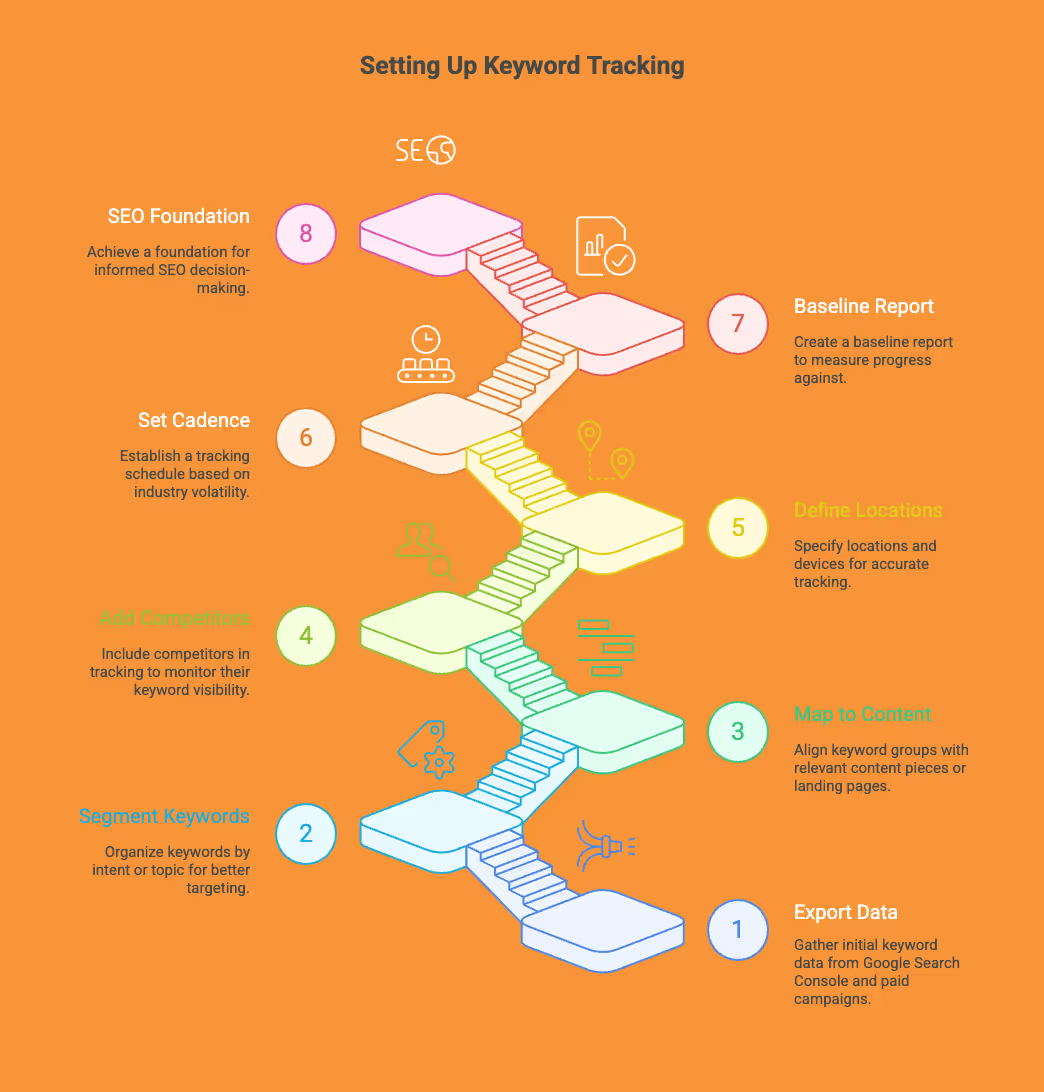
- Start with data you already own. Export the top queries from Google Search Console, as well as high-converting keywords from all your paid search campaigns. This is your "seed set,"i.e., keywords already driving impressions or conversions.
- Segment these keywords by intent or topic. For example, informational searches asking "how to?" are different from transactional searches looking for "pricing" or "demo".
- Map each keyword group to a content piece (like a blog post) or a landing page that addresses the search term as precisely as possible.
- Add key competitors to your tracking tool. It will monitor keyword visibility over time and let you know who is gaining better traction on which keyword.
- Don't forget to define locations and devices for each keyword group. Track results from desktop and mobile search, at the city and ZIP-level, if possible.
- Set up a daily cadence for active campaigns or volatile industries. Weekly ones will do for steady-state monitoring.
- Generate an initial baseline report to define your “starting line” on record. Configure alerts to highlight any significant rise or fall in rankings.
All done? Give it a week and you should be able to see should take a week to see trend lines, competitive context, and a foundation for meaningful SEO decision-making emerge from raw datasets.
Free Workflow: Check Google Ranking of a Website Today
Use Google Search Console (GSC) to find queries and average positions
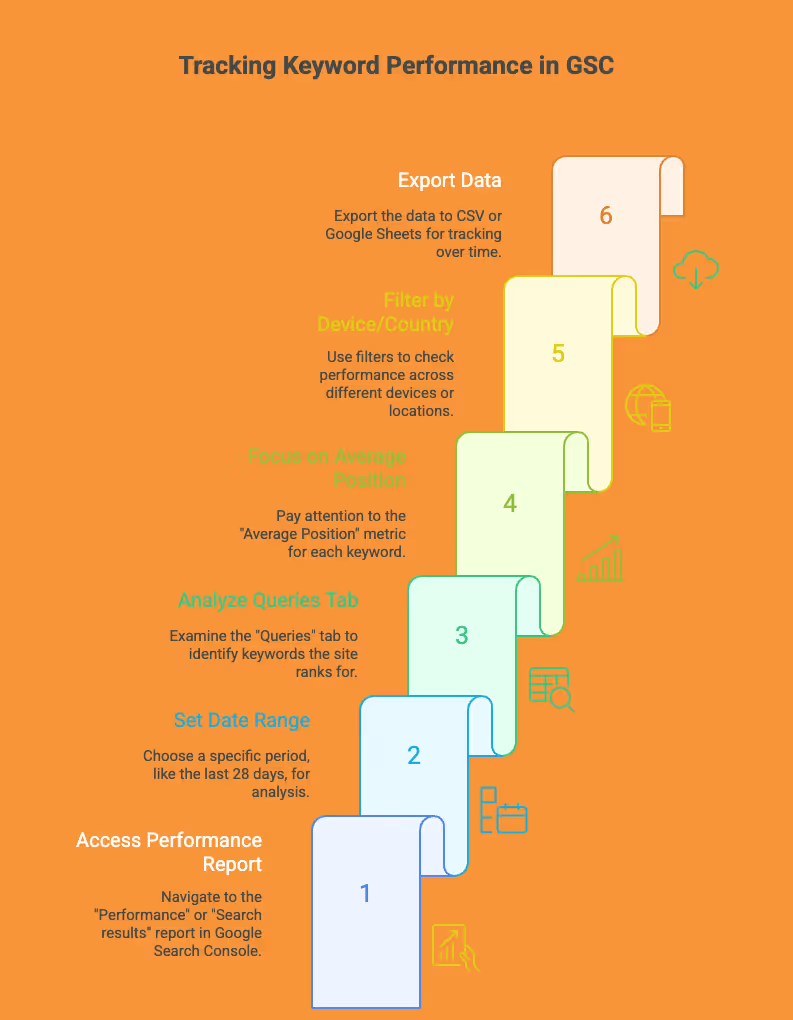
Step 1: In GSC, go to the “Performance” (or “Search results”) report to view how a site currently ranks in Google Search.
Step 2: Set a date range (e.g., last 28 days).
Step 3: Look at the Queries tab to see the keywords the site is ranking for.
Step 4: Focus on the “Average Position” metric for each query: a web page’s mean rank for a specific keyword.
Step 5: Filter by “Device” or “Country” to check site performance across mobile/desktop or in different locations.
Step 6: Export the data (CSV or Google Sheets) to log these baseline values and track over time.
Run a free rank check for a neutral, location-specific snapshot

- Use a free online rank checker tool (like usearchfrom or Ahrefs Free Rank Checker) to see how a specific keyword ranks right now, from a neutral IP/location.
- When running the check, set the keyword, target domain (your site), and specify location (country/city) if the tool supports it.
- Record the result for a live, real-world snapshot of the ranking position at that moment.
Note: Free checkers typically don’t handle historical data or multiple keywords at scale.
Log the baseline + decide whether you need advanced tools
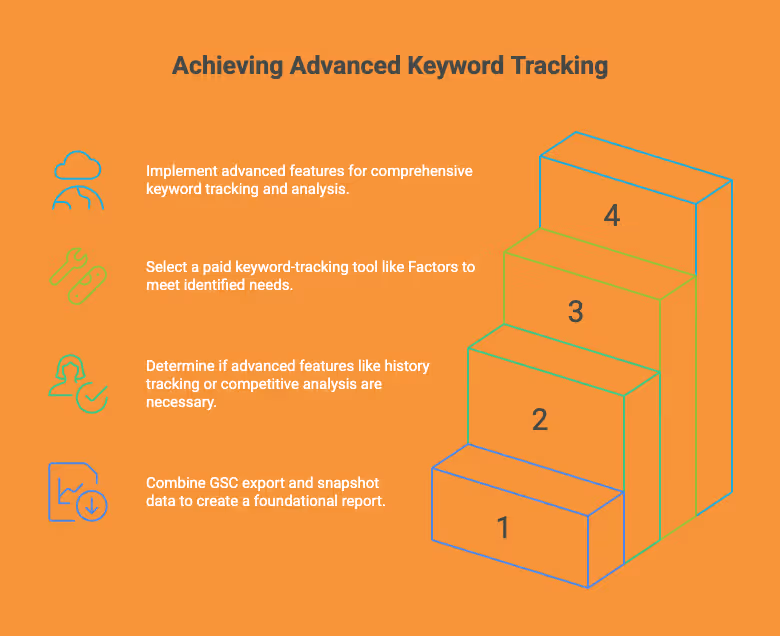
- Combine the GSC export from Step 1 and the snapshot from Step 2 into a baseline report (e.g., date, keyword, average position, live rank check).
- If you need history tracking, daily alerts, geo/device splits, competitive tracking, or SERP-feature monitoring, that’s the moment to graduate to a paid keyword-tracking tool like Factors. It will map intent signals, highlight touchpoints in the buyer journey and generate comprehensive reports.
- This forms the baseline, off which marketers can spot trends, rise and fall in keyword ranks and changes by device/location.
In a nutshell…
Keyword tracking reveals how your site performs across Google’s ever-changing search landscape. Your SEO position (the rank your page holds for a given keyword) can vary by device, location, and SERP features like snippets or maps. Regular monitoring connects visibility to traffic and helps identify early ranking changes before they impact results.
Start with free checks in Google Search Console for average position data. For trend lines, competitor insights, and multi-location reporting, upgrade to professional trackers. Weekly tracking balances clarity and efficiency. In competitive or news-sensitive niches, use daily monitoring for timely reactions.
Tools with city/ZIP simulation and mobile/desktop splits show how your visibility changes across local markets.The ideal tools will offer, as features,location/device granularity, SERP feature tracking, competitor benchmarking, alerts/API, and white-label reporting.
FAQs on the Best Keyword Tracker
Q. What is ‘SEO position meaning’?
SEO position means the rank a web page holds in results for search engines like Google, Yahoo or Bing, when users type in specific keywords. For example, if your blog appears third on Google for “best running shoes,” your SEO position for that keyword is #3.
The higher a page ranks, the more likely it is to get higher visibility and more clicks.
Q. How often should I check organic rankings?
Ideally, you should check rankings weekly to keep up with trends and get accurate reports. In case you're tracking competitive keywords, fresh pages, or campaign launches, it's important to check ranking daily.
Following this routine keeps keyword volatility at a minimum. It also helps SEO teams respond to any drop in ranking progress before it impacts traffic too closely.
Q. Can I track keywords regionally?
Yes, it is entirely possible to track keywords regionally as long as you choose tools offering city or ZIP code-level granularity. Such tools also tend to show keyword rankings as they are coming in from different devices.
Regional tracking is especially important for local SEO or service-area businesses where search intent depends on proximity (e.g., “dentist near me” in Chicago vs. Dallas).
Q. What’s the best free way to check rankings?
Work with Google Search Console (GSC) + a free live rank checker.
GSC will show any verified site’s average positions, clicks, and impressions. Combine that with Ahrefs’ free checker, and you'll see approximate public search results. But don't forget that these free tools do have query limits and no historical data. At best, they work for spot checks rather than long term monitoring.
Q. Rank tracking vs keyword research, what’s the difference?
Tracking monitors performance; research discovers opportunities.
Rank tracking observes how existing keywords are performing over time. Keyword research surfaces new keywords the audience might be searching for, which opens up new opportunities for engagement and conversion.
Q. Do I need daily tracking?
Daily keyword tracking is most required when keyword rankings change quickly. For instance, in competitive industries like certain eCommerce niches, daily tracking is essential to map the impact of content and campaigns.
It's best to track keyword rankings daily when:
- You’re optimizing new pages or product launches.
- You work in volatile niches (e.g., finance, health, tech) where keyword rankings shift with every update.
- You need to respond quickly to algorithm changes or competitor pushes.

From Website Visitor to Warm Outbound Play: How to Use GTM Engineering Services for Intent-Driven Outreach
TL;DR
- Visitor ID + Intent Data = Real Pipeline: Identify ICP-fit companies visiting your site using reverse IP and intent filters, even if they don’t fill out a form.
- GTM Engineering Automates Everything: From enrichment to outbound handoff, custom workflows eliminate manual busywork and trigger timely outreach.
- Prioritization Drives Focus: Accounts are tiered by fit and intent, allowing reps to focus efforts where they matter most, not just on who clicks first.
- Human Touch, AI Assist: AI-generated summaries and contact bundles give reps the context they need to personalize without guesswork or delay.
Let’s be honest: traffic and MQLs don’t pay the bills. Pipeline and revenue do.
Here’s the truth: your best prospects are probably already on your website. They’re comparing features, peeking at pricing, and reading that one blog you’re weirdly proud of. But only ~3% of visitors fill out a form. The other 97%? Anonymous..unless you can identify the company, recognize buying intent, and trigger smart outreach automatically.
This article shows you how to do exactly that with website visitor identification, intent data, and a layer of GTM engineering that turns signals into ready-to-send outbound and, ultimately, qualified conversations.
We’ll keep it practical, human, and zero-fluff. (Coffee optional. Results, not.)
And yes, we’ll show how Factors does the heavy lifting, tooling, data, and workflows included.
TL;DR: This is the fastest way to build pipeline without ballooning ad budgets or headcount.
But first, the basics.
What is intent data?
Intent data is any signal that shows a buyer might be researching your category or solution. There are four types of intent data:
- Zero-party: They tell you directly (e.g., a demo form).
- First-party: You observe it on your assets (e.g., web sessions, page views, clicks).
- Second-party: Another company’s first-party data (e.g., G2 page visits, LinkedIn Ads views).
- Third-party: Aggregated across many sites (e.g., Bombora-type data).

Why it matters: Studies suggest buyers are ~57% through their journey before they talk to sales. You need to engage earlier, when intent shows up, not when a form arrives.
What is website visitor identification?
It’s how you de-anonymize company-level traffic on your site (without personal PII). Tools like Factors.ai use industry-leading reverse IP technology and enrichment to reveal who’s on your site (company, industry, size, tech, etc.) and what they’re doing (pages, sessions, engagement depth).
Factors.ai offers best-in-class coverage for website visitor identification. It identifies more than 75% of anonymous website visitors using sequential waterfall enrichment.
What is GTM engineering?
GTM engineering is the missing link between knowing who’s interested and acting on it in real time. It’s the setup of automated workflows (with AI where helpful) that connect your data sources, website, ad platforms, CRM, Apollo, Slack, and more, to trigger instant, contextual outbound plays.
With Factors’ GTM Engineering services, you don’t just get software; you get a managed system that:
- Detects intent signals in real time
- Identifies which companies are visiting your site
- Enriches contact data automatically via Clay and Apollo
- Scores and prioritizes accounts (AI-enabled predictive scoring included)
- Sends ready-to-act Slack alerts and email drafts to SDRs/Sales in minutes (not next Tuesday).
- Automate outreach via LinkedIn InMails, calls, and emails
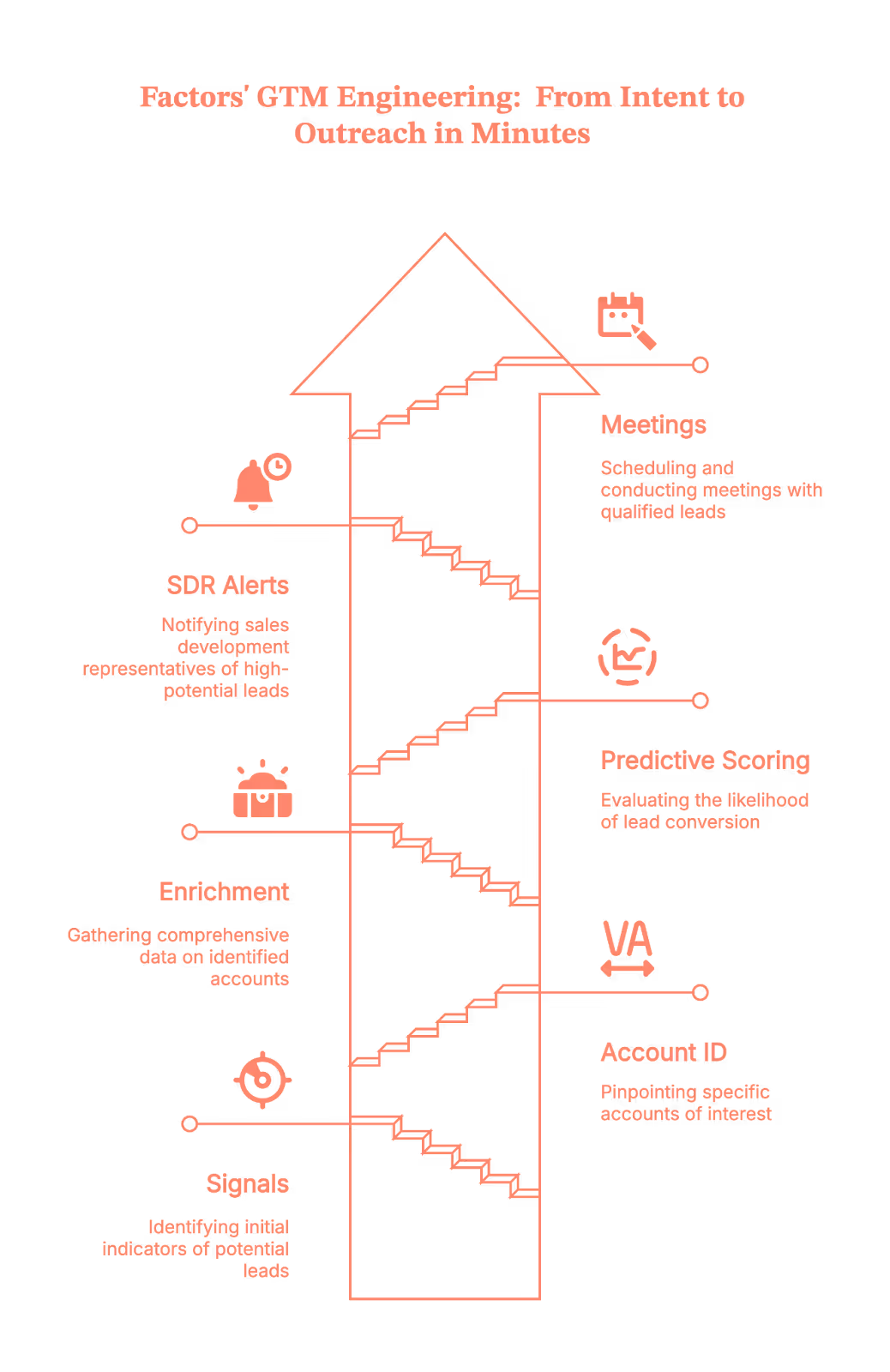
Okay, but why does this matter now? Because everyone’s doing it (Just kidding)
- Speed wins. Buyers do a lot of research before talking to sales. If you reach out first (and with context), you're more likely to make the shortlist.
- Efficiency is everything. Ad budgets are tight; headcount isn’t infinite. Intent + automation = more meetings per rep, with less chaos.
- Sales teams need clarity, not ‘heads-up’ pings. A good alert says who, why now, who to contact, and what to say. (Not ‘someone from Acme visited lol.’)
The 5-Step Playbook to Turn Visitors into Warm Outbound Play (Run this today)
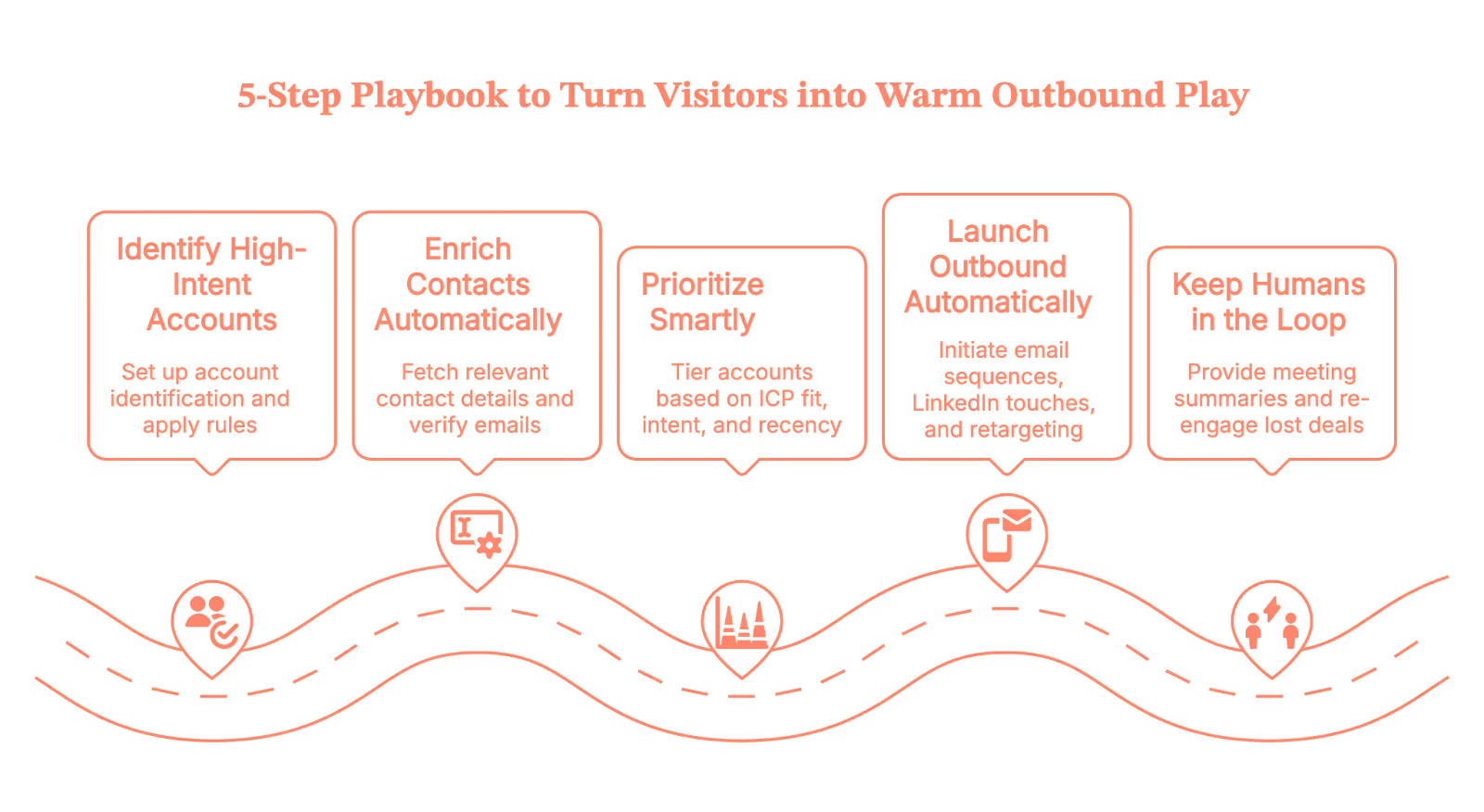
1) Identify high-intent accounts (with Factors)
Set up account identification on your site so you see company, industry, size, location, and what they did (pricing page, comparison page, sessions, etc.). Then add simple rules:
- ICP fit: e.g., Software/IT/Education, US/Canada, 50–500 employees
- Intent filters: e.g., ‘viewed pricing or product pages for ≥60 seconds,’ ‘multiple sessions in 24 hours,’ or ‘visited competitor comparison’
Pro tip: Start with two high-yield streams:
- High-intent ICP (net-new)
- Closed-lost/churned revisits (exclude super-recent losses so you don’t look clingy)
When an account matches, Factors fires real-time alerts and links directly to the account’s journey (so reps see context in one click).
(Because ‘context switching across 12 tabs’ isn’t a growth strategy.)
2) Enrich contacts automatically (this is where GTM engineering shines)
Identifying the company is half the job. The other half is finding the right people with verified emails, without sending SDRs on a copy-paste safari.
Here’s the flow your GTM engineering layer runs behind the scenes:
- Trigger: A Factors alert hits your orchestration tool (Make.com, Zapier, or Clay).
- Journey pull: Fetch last-30-day activity from Factors (pages, sessions, ad touches) into a working sheet.
- Apollo enrichment: Call Apollo to fetch relevant titles/regions/seniority; capture work emails and verification status.
- CRM hygiene: Check HubSpot/Salesforce for duplicates; tag new/existing; write updates.
- Prep the alert: Bundle the journey + top contacts so Slack shows reps who to email first (and why).
Net result: Your team gets verified contacts from the right account, in minutes, without manual chasing.
3) Prioritize smartly (so reps take the next best action)
Not every account deserves a same-day call. Use lightweight tiering so your team focuses on impact, not volume:
- ICP Fit: Expected ACV, win rate, segment (SMB/MM/ENT)
- Intent: Page depth, frequency, topics (pricing/competitor pages > ‘what is’ blogs)
- Recency: Last activity (fresh beats stale)
- Engagement: Channels and content they cared about (ad → landing page ≠ casual blog skim)
Factors’ Account Tiering and Contact Relevance agents do this automatically, grouping buying committees, ranking contacts, and even generating ‘why this person’ reasons.
Tier 1 goes to Sales now; Tier 2 gets Sales + Marketing; Tier 3 goes into the nurture phase.
(Think of it as ‘do the clever things first.’)
4) Launch outbound automatically (without being creepy)
Once you have account + contacts + context, GTM engineering fires multichannel plays:
- Email sequences (via Apollo or Smartlead), personalized to the topic/page cluster
- LinkedIn touches (connection requests and light interactions via tools like HeyReach/Trigify)
- Precision retargeting (show the right creative to live ICP visitors)
- Slack alerts so reps can jump in when Tier 1 accounts are active
Messaging rule of thumb: reference adjacent, observable signals (‘teams like yours comparing X/Y often ask about…’) instead of ‘we saw you on the pricing page at 3:17 pm.’(Because… yikes.)
5) Keep humans in the loop, then measure like a hawk
Automation should tee up great conversations, not replace them.
- Meeting Assist: AEs get pre-meeting summaries (firmographics, interest areas, pre/post-visit pages) for tailored follow-ups.
- Closed-lost re-engage: If a lost deal resurfaces, reps get the journey + refreshed contacts (and a reason to re-open the thread).
- Daily digest: Leadership sees which regions and tiers are heating up.
Track the entire intent funnel, not just opens:
- Identified → ICP → Enriched → Assigned → Contacted → Replied → SQL → Demo → Opp → Closed-Won/Lost
- Compare tiers, personas, channels, and sequences. Tweak filters (who we target) and copy (what we say) each week.
A 3-minute micro-play (to show how this feels)
Let’s say a closed-lost account, ‘Acme Corp’, revisits your pricing page (You feel that little heartbeat spike, right?)
Here’s how that moment turns into a meeting, automatically:
- Trigger (instant): Factors spots the visit and tags it as a Closed-Lost Revisit, no manual digging, no delays.
- Collect & Enrich (under the hood): Make.com flow pulls the last 30 days of journey data from Factors, then calls Apollo to fetch role-relevant, verified marketing and sales contacts. Duplicates get checked against your CRM, so records stay clean.
- AI Assist (context you can use): OpenAI summarizes the journey (top pages, themes) and prioritizes contacts by geo, title, and seniority, so reps know exactly who to hit first.
- Slack Handoff (minutes later): Your SDR receives a ready-to-act card with the next best step already included.
- Action (human, fast): The rep tweaks a line or two and hits send. Warm, informed, and perfectly timed.
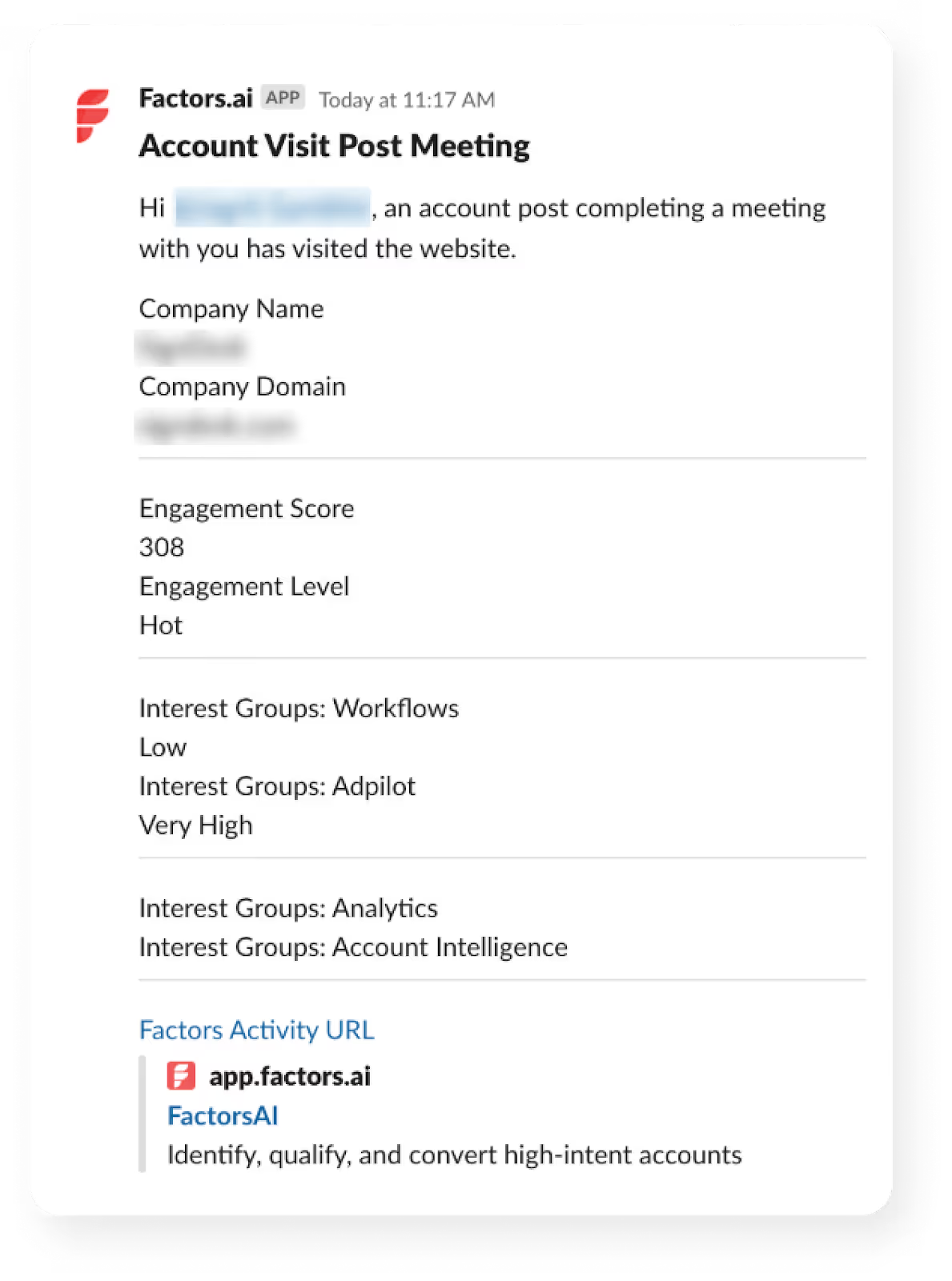
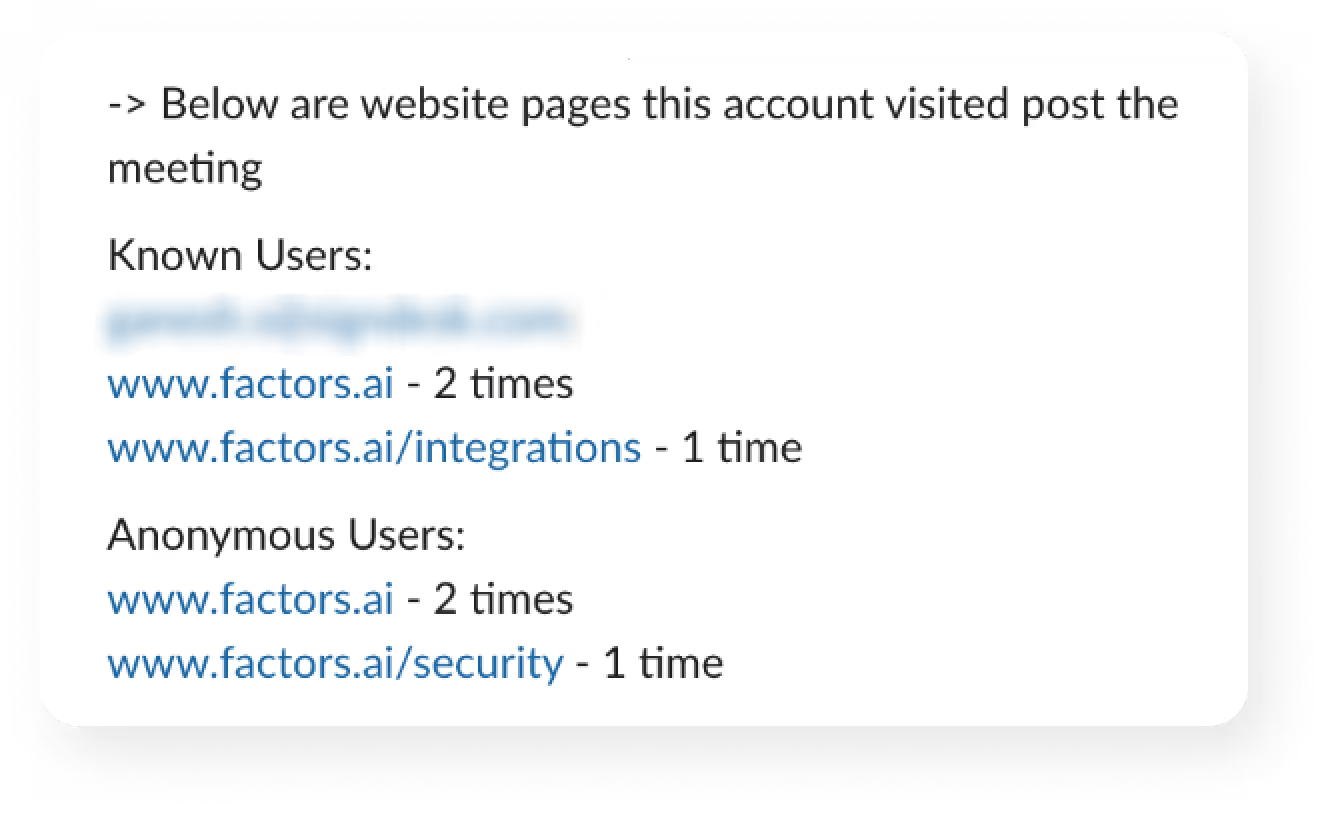
Ready to catch the next one?
Why teams pick Factors.ai for intent-driven outbound
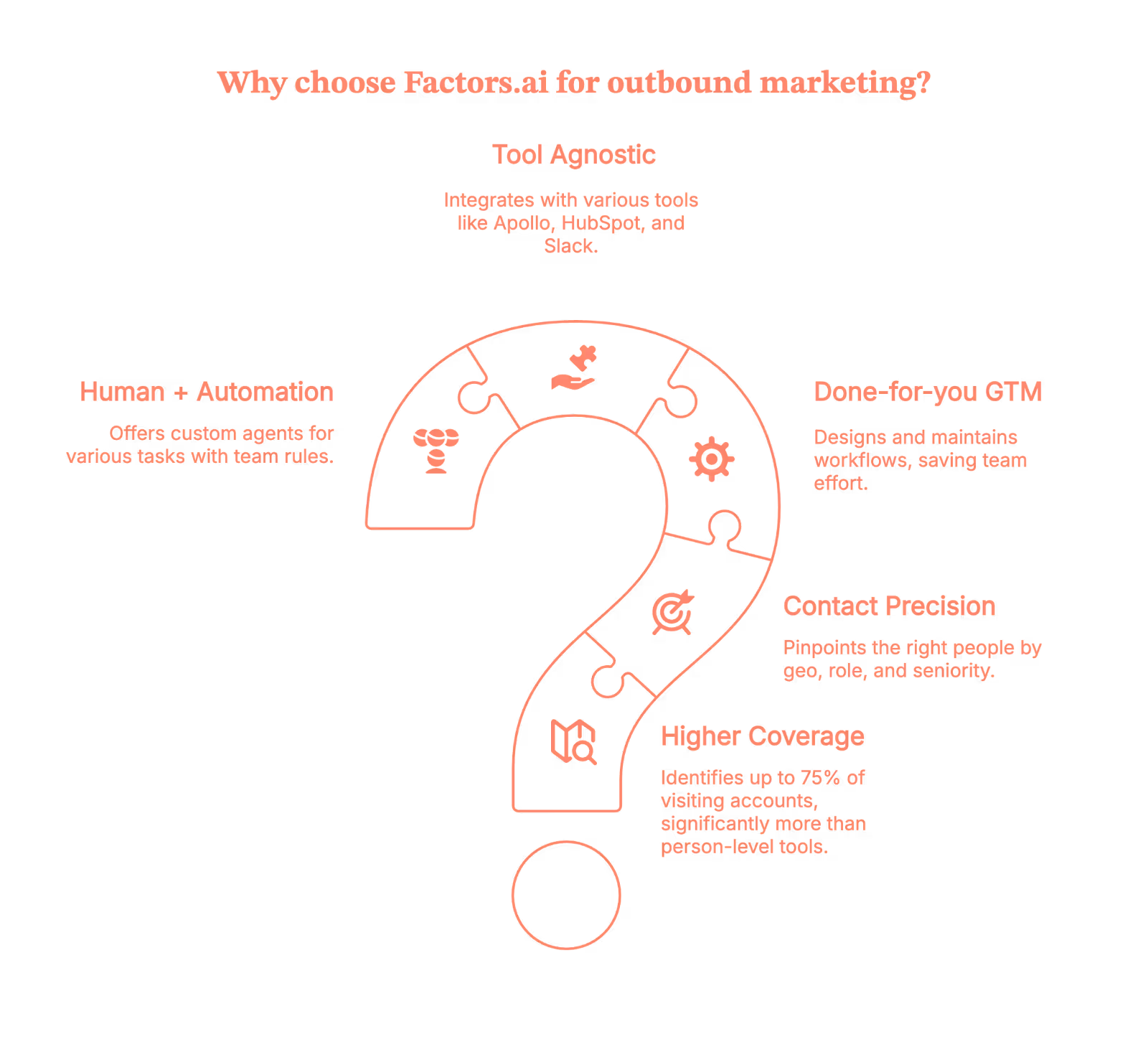
- Higher coverage: Identify up to 75% of visiting accounts (vs 8–10% person-level tools).
- Contact-level precision: Pinpoint the right people by geo, role, seniority, and buying group using user geo + job title triangulation.
- Done-for-you GTM engineering: We design, build, and maintain the workflows, so you don’t.
- Tool-agnostic, outcome-first: Use Factors with Apollo, HubSpot/Salesforce, Slack, Make/Zapier/Clay, Google Sheets, and your ad stack.
- Human + automation: Custom agents for Account Qualification, Contact Relevance, Account Tiering, Account Mapping, Meeting Assist, and Closed-Lost Alerts, with your team’s rules baked in.
(Short version: fewer ‘busywork’ pings, more booked meetings.)
Now, your move
If you’ve got traffic but not enough conversations, you don’t need ‘more leads.’ You need to activate the intent you already have, and do it automatically.
Factors identifies who’s on your site, uses GTM engineering to enrich and prioritize accounts, and delivers ready-to-send outreach to your reps in minutes.
Book a demo, and we’ll show you your high-intent accounts, the exact contacts to reach, and the workflows that make outbound feel (almost) effortless.
You’re closer to your next best deal than you think. Let’s go get it.
Quick FAQ on GTM engineering services from Factors.ai (because your team will ask)
Q. Will this spam Slack?
A. No, alerts are filtered by ICP + intent + tier. Everything else goes to a digest.
Q. Are the emails any good?
A. We use context from buyer journeys and your rules to generate short, human drafts. Reps keep the voice; automation kills the busywork.
Q. What if our ops team is small?
A. That’s why GTM engineering services exist. We build and maintain the flows; you enjoy the pipeline.
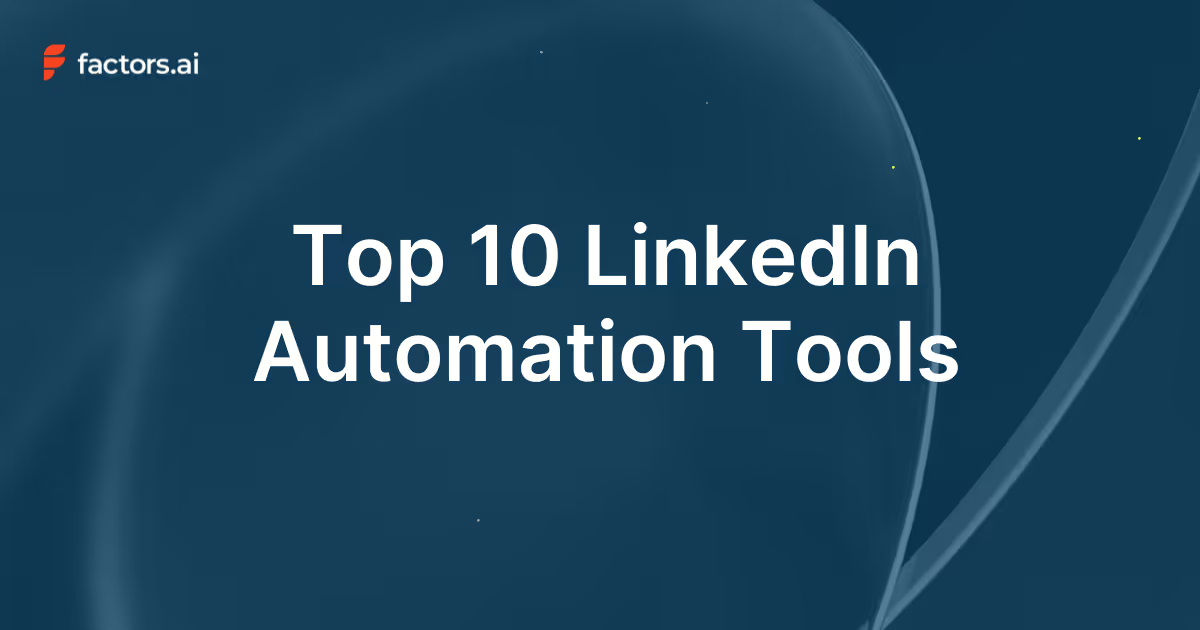
Top 10 LinkedIn Automation Tools
If you’ve clicked on this blog, chances are you’ve already fallen into the LinkedIn automation rabbit hole. Good move. You’ve taken a step in the right direction, and you’re definitely not alone. 89% of B2B marketers use LinkedIn for lead generation, and 62% say it actually delivers. LinkedIn is now the backbone of B2B marketing, with over a billion users across 200 countries.
Let's be honest, manual outreach (I call it the fax machine of marketing) at scale is a one-way ticket to burnout. Used smartly, automation doesn’t replace the human touch. It amplifies it. This guide cuts through the noise and helps you spot the 10 best LinkedIn automation tools that are actually worth your time.
💡Also read: Top 22 Account-Based Marketing (ABM) Tools
TL;DR
- LinkedIn automation tools help B2B marketers and sales teams scale outreach, generate leads, and close meaningful deals.
- Top tools like Factors, Expandi, Dripify, HeyReach and Waalaxy simplify LinkedIn outreach with smart automation and built-in analytics.
- Automation enhances efficiency in areas such as sending personalized messages, nurturing leads, and tracking engagement automatically.
- Choose ethical LinkedIn automation tools that ensure safety, CRM integration, and measurable ROI.
- The right automation tools help you reach more decision-makers, personalize at scale, and track what drives results.
- Factors’ AdPilot connects LinkedIn Ads with revenue insights, showing how every impression drives B2B pipeline growth.
Understanding LinkedIn Automation Tools
What are LinkedIn Automation Tools?
LinkedIn automation tools handle the stuff that eats up your day. Think of them as your behind-the-scenes assistant sending connection requests, following up with leads, nurturing prospects through sequences, and tracking who's engaging and who's ghosting you. They never forget a follow-up, never get tired, and never let a hot lead go cold because you were stuck in back-to-back meetings.
When used right, no lead slips through the cracks, every move gets tracked, and you know exactly what's working. You can then double down on wins, spot what's not working out, and figure out how to turn those losses around before you waste another week on the wrong message.
Why they matter:
- Connect with decision-makers without stalking their LinkedIn all day
- Follow up smart, charm your leads, skip the awkward vibes
- Spot who’s just window-shopping, who’s curious, and who’s ready to sign on the dotted line
- Build pipelines that don’t ghost you, with repeatable, data-backed systems.
- Run personalized campaigns at scale and still sound human (because yes, people notice)
- Stop wasting time on dead ends and double down on the leads that actually move
- Escape the copy-paste hamster wheel and spend your energy on real conversations that close deals

Top 10 LinkedIn Automation Tools
1. Factors
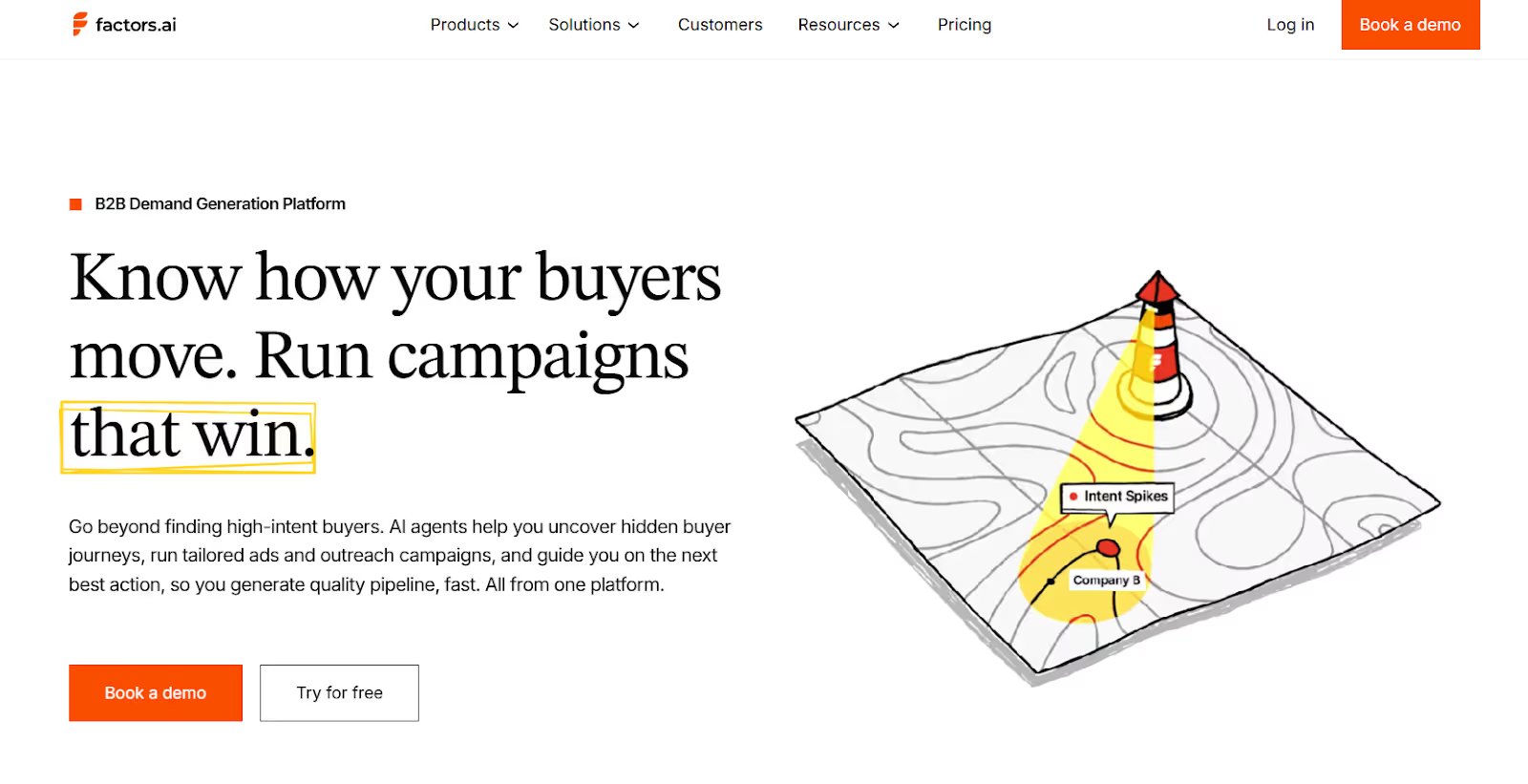
Overview:
Factors is an AI-powered B2B account intelligence platform. It integrates with LinkedIn to track engagement signals like profile visits, content interactions, and ad activity to show which accounts are most ready to engage. With its AdPilot feature GTM and demand generation teams can prioritize high-intent accounts, build dynamic lists using firmographics and behavioral filters, and optimize LinkedIn campaigns for better engagement and conversions.
In essence, Factors transforms LinkedIn automation from a siloed activity into a part of a unified revenue engine. By combining analytics, attribution, and outreach, it empowers teams to prioritize high-intent accounts and personalize outreach at scale.
Key Features:
- Captures high-intent leads by tracking LinkedIn activity, website visits, CRM data, and third-party signals in one place.
- Automatically syncs these high-value audiences to LinkedIn for laser-focused ad targeting and smarter campaign optimization.
- Helps gain a unified view of each account with a 360-degree timeline of buyer activity, including organic LinkedIn engagement.
- Prioritizes outreach effortlessly using AI-driven account scoring and segmentation based on engagement and firmographics.
- AI-powered analytics handle reporting, delivering actionable insights to boost LinkedIn ad performance and conversions
Pros:
- Real-time account insights enable timely, relevant outreach.
- Multi-touch attribution links marketing directly to pipeline results.
- Predictive analytics helps anticipate account engagement and prioritize high-intent targets.
Cons:
Lacks user-level data without a third-party enrichment integration.
Pricing: Custom; based on usage and integrations.
2. Expandi

Overview:
Expandi is a cloud-based LinkedIn automation platform for scaling lead generation and outreach. It automates personalized connection requests, follow-ups, and event invites while staying compliant with LinkedIn’s activity limits. With A/B testing, dynamic personalization, and CRM integrations, it helps B2B teams manage outreach efficiently across multiple accounts from one dashboard.
Key Features:
- A/B testing for message optimization.
- Dual-channel outreach via LinkedIn and email.
- Integrations with Hyperise, Pipedrive, and Zapier.
Pros:
- Simple setup and fast campaign deployment.
- Personalization at scale with multimedia support.
- Centralized campaign management with Workspaces.
Cons:
- Limited native CRM integrations.
- Interface can feel clunky for new users.
Pricing: $99/month per seat with 7 day free trial
3. Dripify
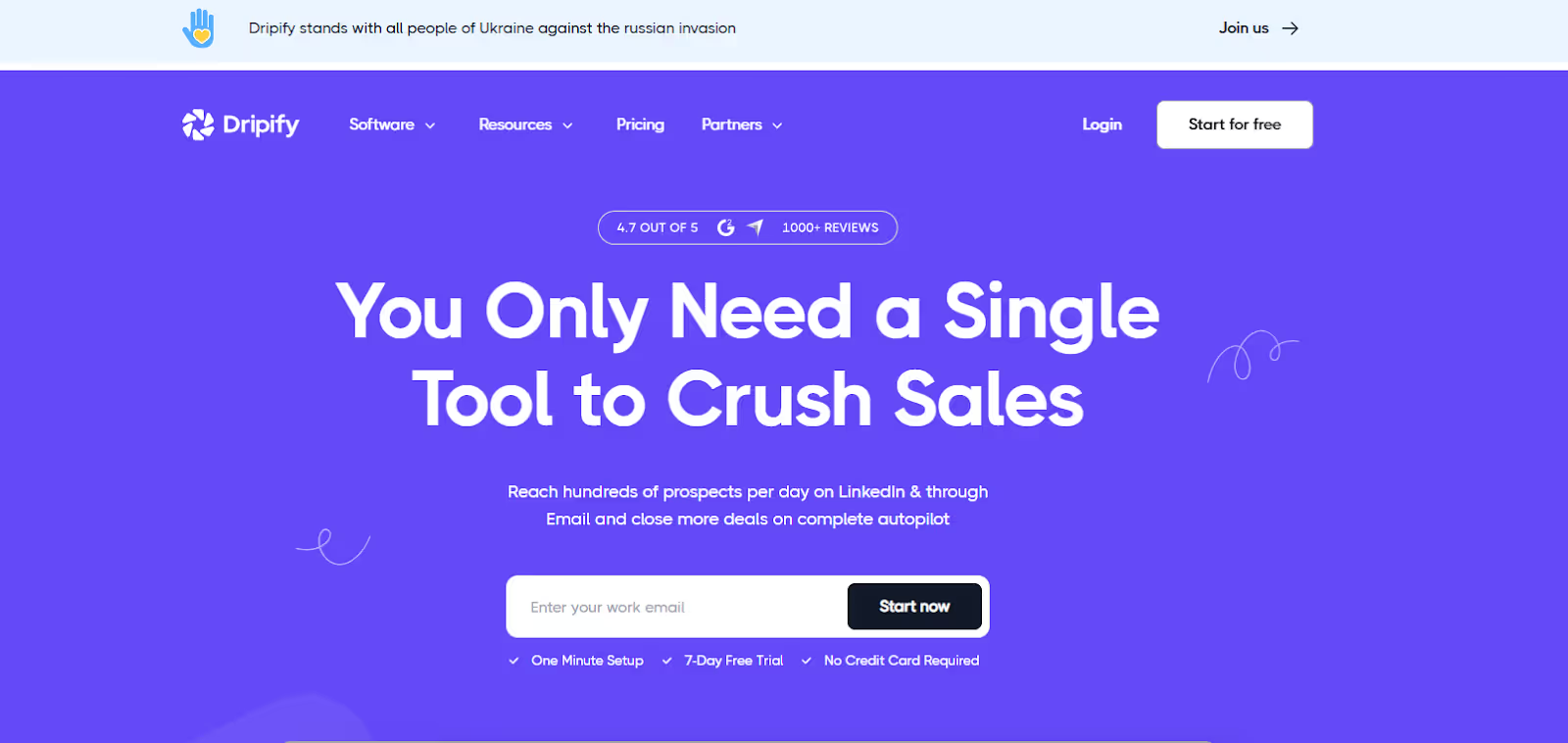
Dripify focuses on simplified, data-driven outreach automation for LinkedIn. Its clean interface allows users to set up drip campaigns that replicate real, human-like sequences, ideal for nurturing B2B leads over time. Dripify integrates with CRMs like HubSpot and Salesforce through Zapier, helping teams align marketing and sales data.
Key Features:
- Automate personalized follow-ups with multi-step drip campaigns
- Track engagement and manage conversations in one place with analytics and smart inbox
- Sync leads seamlessly with HubSpot, Salesforce, or Zoho
Pros:
- Simplified LinkedIn outreach with an intuitive, easy-to-use interface
- Automation with strong personalization for better engagement
- Efficient lead extraction while remaining affordable
Cons:
- No custom API for tailored integrations
- Limited customization restricts outreach flexibility
Pricing: Starts at $59/month per user, with advanced plans up to $99/month
4. PhantomBuster
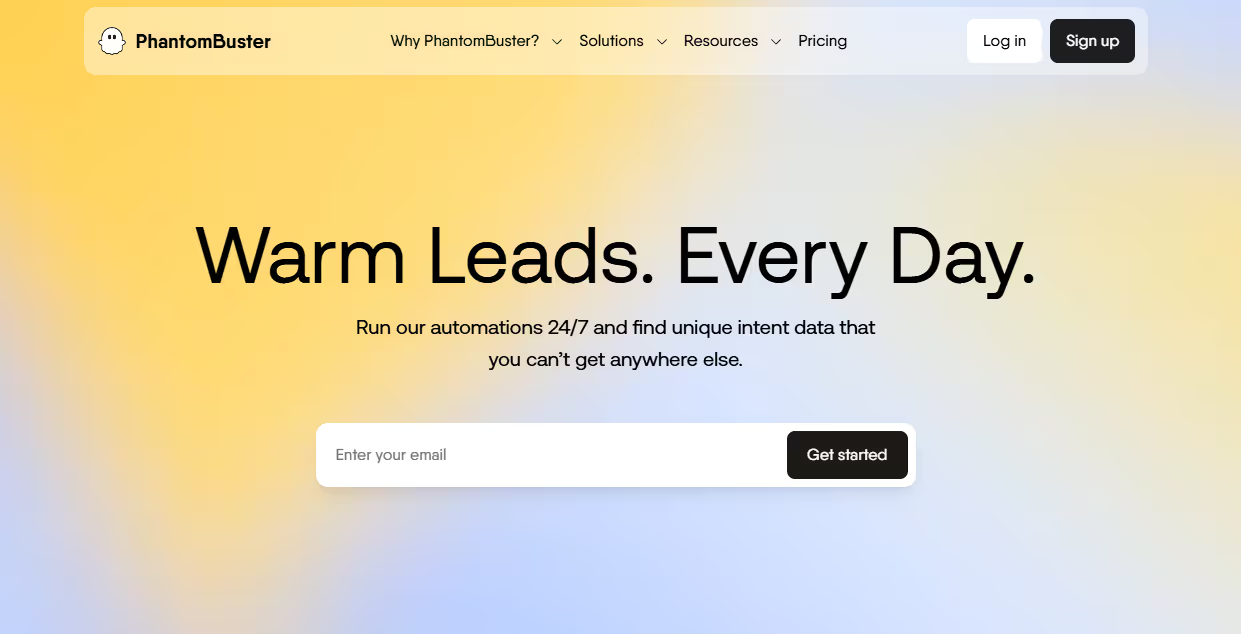
Overview:
PhantomBuster automates lead extraction and enrichment from LinkedIn, and other platforms using pre-built “Phantoms”(ready- to-use automations) and workflows. It pulls contacts from Sales Navigator, tracks profile and job changes, and feeds fresh data directly into your CRM for targeted outreach. Beyond lead collection, it monitors engagement, triggers outreach via HubSpot integrations, all without coding. For sales teams and marketers, PhantomBuster turns manual prospecting into a scalable, customizable workflow that keeps outreach smart and up to date.
Key Features:
- Access full API to build custom workflows and track results
- Use a visual workflow builder to schedule and streamline tasks
- Boost LinkedIn outreach and safety with the Chrome extension while syncing leads to CRMs.
Pros:
- Identify warm, high-intent leads from real-time LinkedIn data
- Track engagement and response rates to optimize outreach
- No-code, user-friendly setup for basic campaigns and workflows
Cons:
- Limited phantom slots and execution time hinder large-scale campaigns
- Complex workflows have a steep learning curve for setup and management
Pricing: Free trial; paid plans start at $69/month and can go upto $439/month
5. Waalaxy
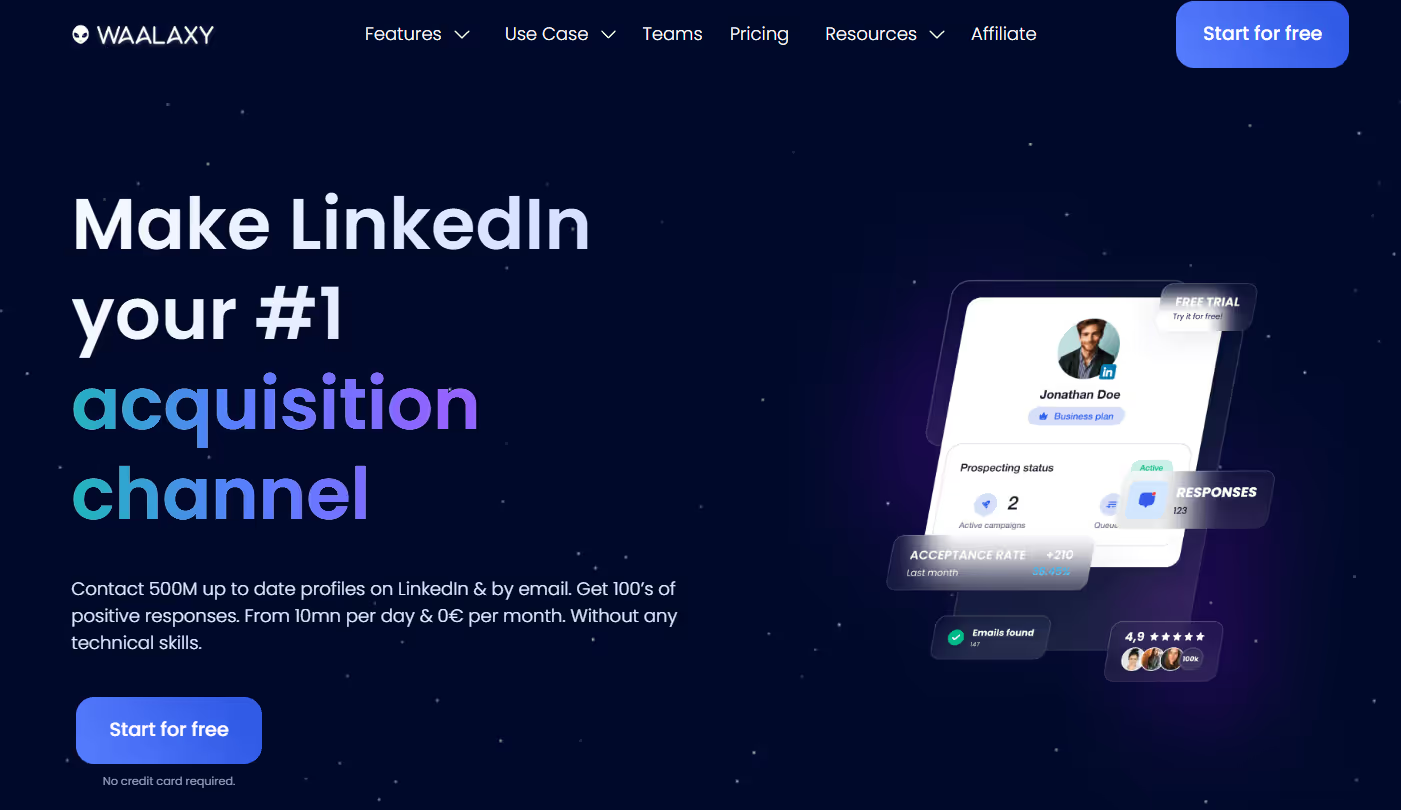
Overview:
Waalaxy combines LinkedIn and email outreach into a single platform, automating connection requests, follow-ups, and multichannel campaigns with verified, GDPR-compliant contacts. Its drag-and-drop interface makes campaign building easy, while the built-in CRM keeps all interactions organized. Advanced search filters, Sales Navigator integration, and performance analytics help users identify high-quality leads, optimize engagement, and manage multiple campaigns efficiently.
Key Features:
- Automate multichannel outreach in a single workflow.
- Centralized dashboard and optional LinkedIn inbox to manage multiple accounts
- Coordinate team outreach and monitor campaign performance
Pros:
- Automates LinkedIn outreach with an intuitive, user-friendly interface
- Supports multichannel campaigns, including email finding and enrichment
- Integrates natively with CRMs for efficient lead management and streamlined workflows
Cons:
- Browser-based setup requires system and extension to stay active for campaigns to run
- Setting up complex campaigns can be challenging
Pricing: Free trial available; Pro package $21/mo to Elite package $273/mo
6. Meet Alfred
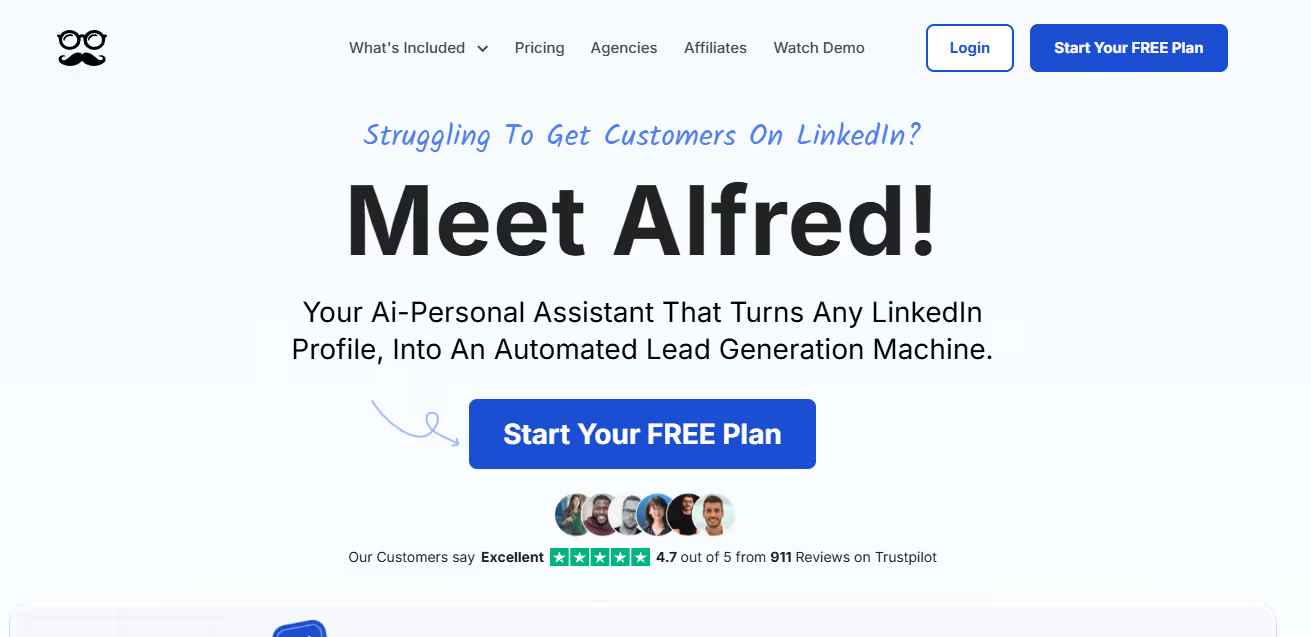
Overview:
Meet Alfred is a LinkedIn-focused automation platform that goes beyond single-channel outreach. It lets users orchestrate multi-channel sales pipelines across LinkedIn, email, and Twitter, automating connection requests, follow-ups, and engagement while staying within LinkedIn’s best practices. Its built-in CRM and Zapier integrations help manage leads, sync contacts, and maintain structured outreach. With dynamic personalization, AI-assisted message suggestions, and sequential messaging, Meet Alfred enables teams to scale outreach efficiently, nurture leads, and track performance across multiple channels from a centralized dashboard
Key Features:
- Run multi-channel outreach on LinkedIn, email, and Twitter.
- Personalize messages with dynamic tags and attachments
- Built-in CRM and analytics provide structured lead management and real-time performance insights.
Pros:
- Simplifies complex workflows into easy, actionable steps for prospecting.
- Improves engagement and responses with automated, personalized follow-ups.
- Provides straightforward performance reports for smarter outreach decisions
Cons:
- Aggressive automation may trigger LinkedIn account restrictions.
- Lacks a central inbox for managing messages in shared campaigns.
Pricing: Free trial available. Basic $59/mo, Pro $99/mo, Teams $79/mo per user (min. 3)
7. HeyReach
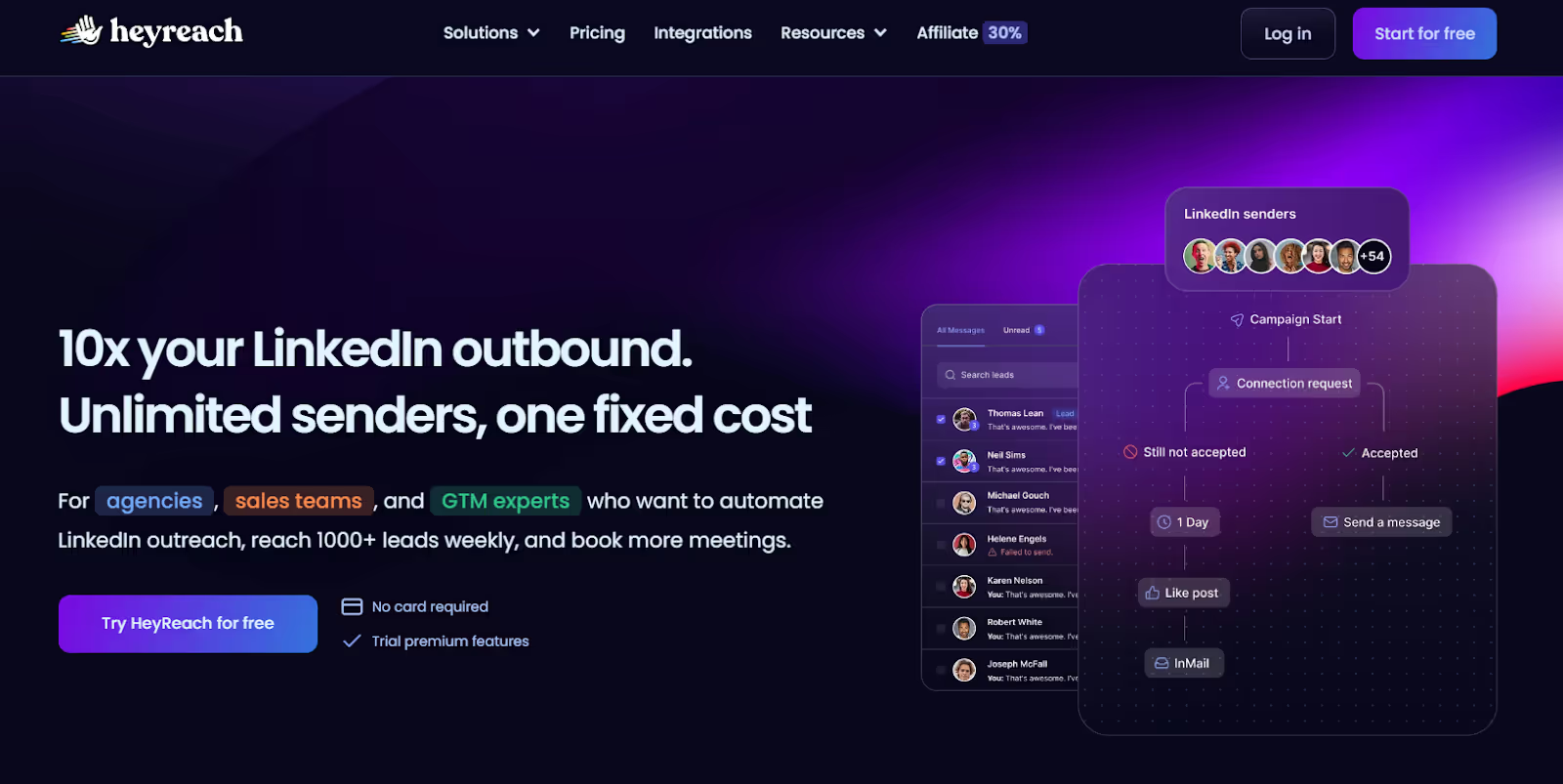
HeyReach is a LinkedIn outreach automation platform that scales lead generation safely using multiple accounts. It offers account rotation, multi-user dashboards, and safety controls, while team collaboration features help marketers and SDRs coordinate campaigns efficiently. A unified inbox centralizes conversations, and CRM integrations (HubSpot, Pipedrive, Zapier, Apollo) provide reporting to track and optimize outreach.
Key Features:
- Manage multiple LinkedIn accounts with a unified inbox to scale outreach.
- Track performance with advanced reporting and dashboard exports (CSV, PNG, SVG).
- Ensure account safety using proxies and automated action limits.
Pros:
- Syncs smoothly with top CRMs and sales tools to boost your pipeline.
- Enables outreach to decision-makers on autopilot.
- Lets you design advanced, multi-step outreach flows with ease
Cons:
- Limited to LinkedIn; requires other tools for multichannel campaigns
- Lacks AI-driven features like lead scoring and predictive insights
Pricing: Starts at $79/month for Starter, with Agency at $999/month and Unlimited at $1,999/month.
8. Zopto

Zopto is a cloud-based LinkedIn automation tool built for startups, sales teams, and agencies to scale outreach without losing personalization. It combines advanced targeting, multi-account management, and time zone–based scheduling to run tailored campaigns at scale. With features like CSV lead imports, campaign segmentation, A/B testing, and Zapier integrations, Zopto gives teams a centralized hub to track performance, refine messaging, and convert prospects efficiently.
Key Features:
- Message generation via ChatGPT to craft personalized LinkedIn messages..
- Run hyper-targeted campaigns with filters like company size, job title, and location.
- Automate multi-account management, A/B testing, and analytics on a cloud-based platform.
Pros:
- Hyper-precise targeting to reach the most relevant prospects.
- Reliable support that helps ensure campaigns hit their goals.
- Effortlessly scalable for growing teams and agencies.
Cons:
- Expensive for smaller teams and startups.
- Campaigns can run slower than competing platforms.
Pricing: starts at $197/month for Basic, $297/month for Pro, and from $156/month per user for Agency & Enterprise plans.
9. Linked Helper
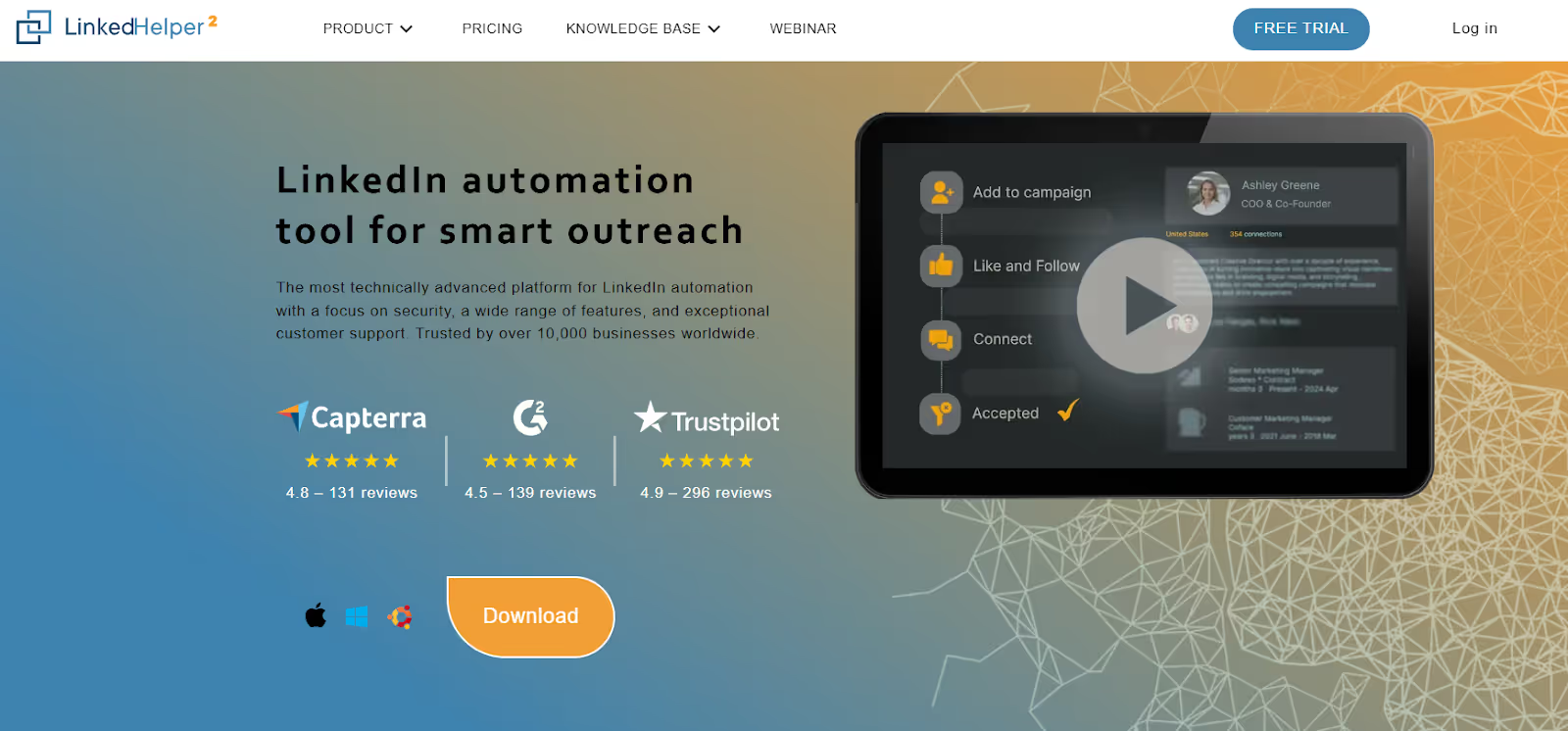
Linked Helper is a desktop-based LinkedIn automation tool that streamlines lead generation and outreach. It automates connection requests, follow-ups, InMails, and profile visits while managing leads through a built-in CRM. With customizable workflows, triggers, and data scraping, it’s ideal for sales teams, marketers, and recruiters looking to scale LinkedIn campaigns efficiently and securely.
Key Features:
- Desktop automation for full control over speed, timing, and security
- Visual campaign builder with smart reply detection to pause sequences automatically
- Built-in LinkedIn CRM with tagging, notes, and lead history for organized and personalized outreach
Pros:
- Operates offline locally for full control without browser or cloud dependence
- Supports all LinkedIn tiers: Basic, Sales Navigator, and Recruiter
- Affordable, reliable, and backed by responsive customer support
Cons:
- LinkedIn-only automation with no email or multichannel support
- Outdated, less intuitive UI can be tough for beginners
Pricing: Starts with a 14-day free trial, followed by Standard at $15/month and Pro at $45/month for advanced LinkedIn automation.
10. Clay
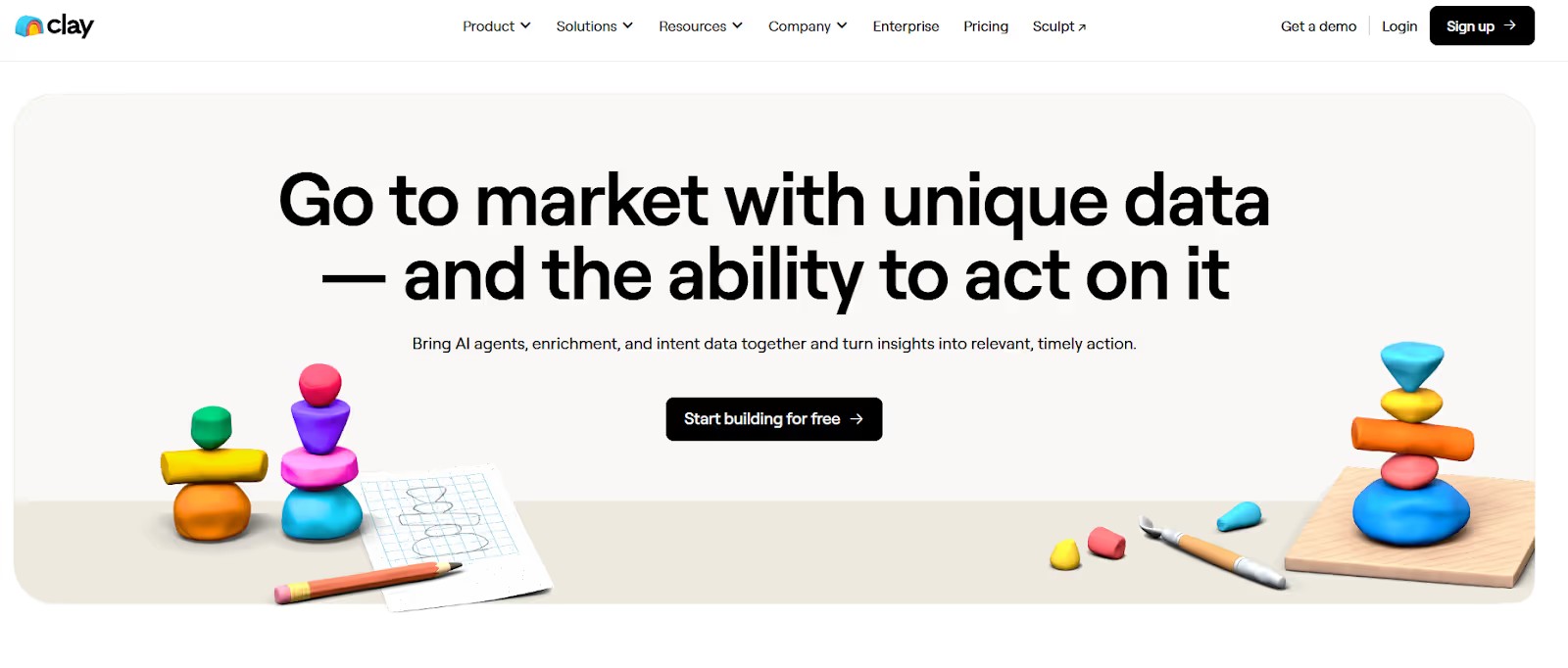
Clay is a workflow automation tool that connects with enrichment platforms to streamline personalized outreach. It helps teams build targeted lists, enrich contact data, craft tailored messages, and trigger emails, all while leveraging AI to optimize lead generation and outreach at scale - without being a CRM or database.
Key Features:
- Real-time waterfall data enrichment keeps lead data accurate and complete
- Spreadsheet-style interface enables custom workflows for list building, enrichment, and outreach
- AI-powered personalization (Claygent + GPT integration) crafts tailored messages and formulas at scale
Pros:
- Non-technical GTM teams can build and deploy customized workflows and automation templates
- Flexible workflows let technical users customize outreach.
- Slack community support aids troubleshooting and optimization.
Cons:
- Handles only lead prep and enrichment, requiring an external CRM for pipeline management.
- Displays data as provided by sources and cannot correct errors.
Pricing: Uses a credit-based model with plans from Free to Pro ($0–$720/month) and custom Enterprise pricing.
Selecting the Right LinkedIn Automation Tool
Practical Tips for Maximizing Results
A master carpenter doesn't just own great tools, they know exactly when to use each one, how much pressure to apply, and when to step back and let the work breathe. LinkedIn automation is no different. Here's how to use your tools like a pro:
- Segment smartly: Target by role, company size, industry and other relevant filters
- Personalize with context: Reference shared interests, mutual connections, or recent activity.
- Align marketing and sales: Sync campaigns with CRM data for smoother handoffs.
- Monitor key metrics: Track acceptance, reply, conversion rates, booked demo calls etc
- Use automation for nurturing: Send content, case studies, or invites to webinars to add value.
How can Factors simplify LinkedIn Automation?
Think of it like walking into a networking event already knowing who's interested in what you're selling, instead of awkwardly pitching everyone at the table. Factors helps B2B teams generate, qualify, and convert leads faster while measuring the true revenue impact of every campaign.
Factors’ LinkedIn Adpilot helps you reach the right people without all the manual work. It updates audience lists automatically, shows more ads to accounts that matter most, and gives you a clear picture of how your ads influence actions like website visits, content downloads or demo requests.
Key features:
- Auto-updated intent-based audience lists
- Control impressions and clicks per account
- Show more ads to high-intent, sales-ready accounts
- Track how ads impact website visits, demos, and deals
- Optimize campaigns in real time with LinkedIn Conversion API
Make LinkedIn Ads work for you: LinkedIn AdPilot by Factors
When it comes to LinkedIn ad automation, most tools focus on scheduling or reporting. But what really matters is automating the decisions that make your ads perform better. That’s exactly what Factors’ LinkedIn AdPilot helps you do.
1. Build audience lists without guesswork
Manually updating campaign lists takes forever, and usually leaves you chasing the wrong accounts. AdPilot automatically creates and syncs intent-based audience lists so your ads reach the right prospects every time.
2. Take control of your LinkedIn spend
The top 10% of accounts often eat up 80% of your impressions. With AdPilot’s Smart Reach, you can control impressions and clicks per account, ensuring your budget covers more of your ICP instead of just a few over-served companies.
3. Show more ads to the right accounts
AdPilot aligns marketing and sales by letting you prioritize sales-ready accounts and deliver more impressions to those most likely to convert, keeping your brand top of mind when it matters most.
4. Uncover the true impact of LinkedIn Ads on revenue
Not every buyer clicks, but everyone sees. AdPilot tracks view-through influence to show how LinkedIn ads contribute to the pipeline, from first impression to closed deal.
5. Optimize campaigns at scale with LinkedIn CAPI
Finally, you can sync online and offline data directly to LinkedIn, send back conversion signals, and scale campaigns, without relying on third-party cookies.
With AdPilot, automation doesn’t just make LinkedIn Ads easier to manage, it makes them smarter, more accountable, and infinitely more efficient.
What makes Factors different is that it looks at the bigger picture. It connects LinkedIn activity with other touchpoints, emails, website visits, and outreach, so you can see how everything works together.
To encapsulate this lengthy blog
When it comes to LinkedIn outreach, think fine dining, not an all-you-can-eat buffet. Less is more. You don't need to blast 500 people a day. You need the right message, to the right person, at the right time. That's it.
Tools like Factors, Expandi, and Dripify handle the repetitive stuff requests, follow-ups, sequences while keeping it personal. They sync with your CRM and ad platforms so marketing and sales don't act like Batman and Bane. Factors goes further with AdPilot, connecting LinkedIn activity to actual revenue, not just vanity metrics.
LinkedIn automation isn't replacing human connection. It's making sure you don't ghost the person you swore you'd "circle back with" three weeks ago.
FAQs
1. What are the best LinkedIn automation tools for B2B lead generation?
Tools like Factors, Expandi, Dripify, Waalaxy, and HeyReach are among the top performers. They offer automation for outreach, analytics, and personalization while staying compliant with LinkedIn’s limits.
2. How can automation improve LinkedIn marketing for B2B companies?
Automation helps teams scale outreach, nurture leads with personalized messages, and analyze campaign performance all while maintaining human-like interaction and data accuracy.
3. What should I look for in a LinkedIn automation tool?
Key factors include safety, CRM integrations, reporting features, and the ability to segment audiences for tailored campaigns.
4. How does Factors simplify LinkedIn automation?
With its AdPilot feature, Factors connects LinkedIn ads, audience data, and conversion tracking, helping marketers target high-intent accounts and measure true revenue impact.
5. Is LinkedIn automation safe for marketers?
Yes, when used within LinkedIn’s limits and with cloud-based tools that mimic human behavior, automation can safely enhance outreach without violating LinkedIn policies.
6. Can LinkedIn automation replace human interaction?
No. The best results come from combining automation for scale and data with genuine human engagement that builds trust and closes deals.
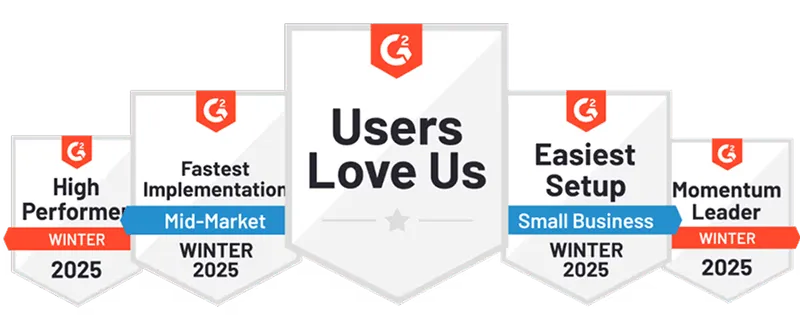

.svg)
